Hello everyone and welcome aboard this report, the return flight from my short weekend trip to Hyderabad from my temporary residence in Bangalore.
Introduction
You must be starting to know me by now. I’m not really the stay-at-home type. Even though my mission in India requires me to be in Bangalore for work during the week, I have my weekends free to go on little indians adventures. We're just a few days away from Diwali, less than a week before the flight, when my schedule finally locks in.
Since this is a religious celebration period in India, it’s no surprise that Indians want to spend the holidays with their families. With public holidays falling on Sunday and Tuesday, many Indians take an extra day off to visit their families. As a result, flights one week before Diwali are particularly expensive.
I’m trying to find a destination that both satisfies my interest in exploring the country and feeds my inner av-geek!
Having read some trip reports from Proximanova on the English-speaking section of the site, he praised Hyderabad as an interesting city. It’s not too far from Bangalore, about an hour by plane, and the two major cities of central India are well-connected with many flights.
For the outbound leg, I find an affordable flight with Vistara, a company that is set to disappear soon due to its merger with Air India. I really wanted to add it to my collection, and it only serves a few destinations from Bangalore (Delhi, Mumbai, Goa, Guwahati, and Hyderabad).
For the return, I had planned to depart from a small rural airport in Bidar, a tiny town on the border between Karnataka and Telangana, located 2.5 hours by road from Hyderabad. Why go all the way there? Because the small carrier Star Air operates flights in an ERJ145 to Bangalore. Unfortunately, after I bought my ticket, my flight, originally scheduled for the evening, was moved to the morning (just two days before the flight). This meant I had to take a night train to Bidar, leaving at 4 AM on sunday definitely not ideal to still have some rest during the week-end.
I then contacted Star Air’s customer service, who informed me that I was eligible for a refund. Perfect! I started the process to initiate the refund and looked for another flight on Sunday from Hyderabad the Thursday before. The benefit of flying on a bank holiday night is that the planes are mostly empty, and prices are very low.
I found a flight in the evening with Air India Express, scheduled on a Boeing 737 MAX 8, which had only been delivered a few months prior a nice little exclusive in the making. However, as you’ll see, my hopes were dashed when they swapped it for an old Boeing 737-800 just after my booking.
However, Star Air managed to pull a fast one, charging me a "convenience fee" of 3300 INR (€38) on the refund, almost the entire refund! For a flight that was moved 6 hours earlier, but unfortunately for me, they were within their legal rights. Consumer protection laws are not the same everywhere (EU261 <3). So, be cautious when flying in India it's just like the country itself… full of surprises, both good and bad.
ERRATUM / EPILOGUE: Ultimately, three weeks later, and without any notification, I received the full refund back into my account… Okay, Star Air, I forgive you.
So, here’s the routing:
Enchainement de vols
- 1
- 2
- 3UK897 - Economy - Bangalore => Hyderabad - Airbus A320neo
- 4IX974 - Economy - Hyderabad => Bangalore - Boeing 737-800
Needless to say, the air connection between the two major cities of central India is a highly competitive market, with no fewer than 6 airlines sharing the market! With 7 daily flights (on A320/1neo), Indigo leads the pack, followed by Vistara (A320neo) and Air India Express (B737/A320), both operating up to 3 daily rotations. Then come the more niche players: Akasa Air (1 daily flight on a Boeing 737 MAX-8), Alliance Air (1 daily flight on an ATR72-600), and finally, Star Air with a near-daily flight on an ERJ175.
To add a bit of spice, Air India has been running familiarization flights for its A350 crews on this route since the beginning of 2024, using their brand-new A350-900s (unless there’s an unexpected twist, you should soon have a report on that subject :-p).
As often happens in India, the French database is empty. I had just reported the opposite direction with Vistara, but this will be the very first report on Air India Express on a Boeing 737-800 on the english side of our website.
Departure from Hyderabad is in the late afternoon
So, it's late Sunday afternoon during Diwali when I head to Rajiv Gandhi Airport. Once again, I choose Uber—very convenient and inexpensive. I have a small chat with my driver over the phone for a little extra tip.
The fare was initially set at just over 750 INR (€9), but we settle on 1000 INR (€11). The ride takes about 30 minutes from downtown, assuming traffic is smooth.
He tells me that sometimes he has to wait for up to 2.5 hours at the airport for a "return" ride, but he’s very friendly and drives a brand-new car. No issue giving him a little extra because clearly, any regular taxi would have charged me double, even with negotiation.
After a smooth ride, we arrive at the airport. The weather is beautiful, just like the rest of the weekend
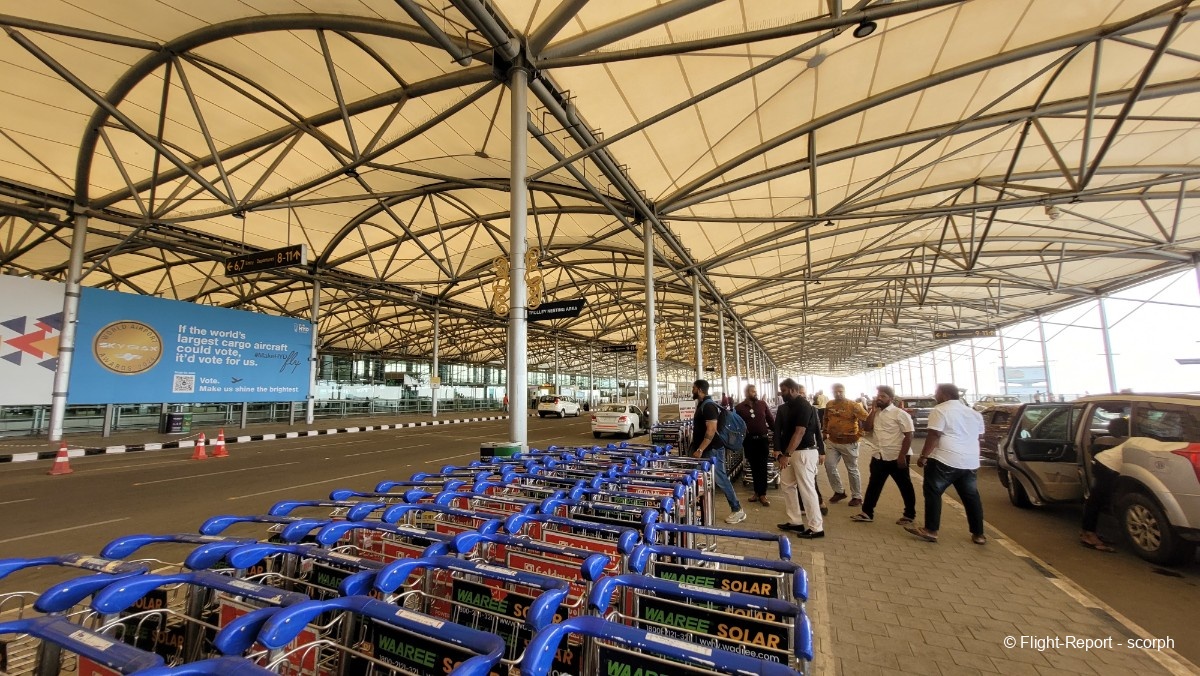
As is the case in all Indian airports, you need to show your passport as well as your ticket or reservation to enter the terminal. A fast-track service called Digi-Yatra is available, which uses facial recognition, but it can only be used if you have an Indian ID card or passeport.
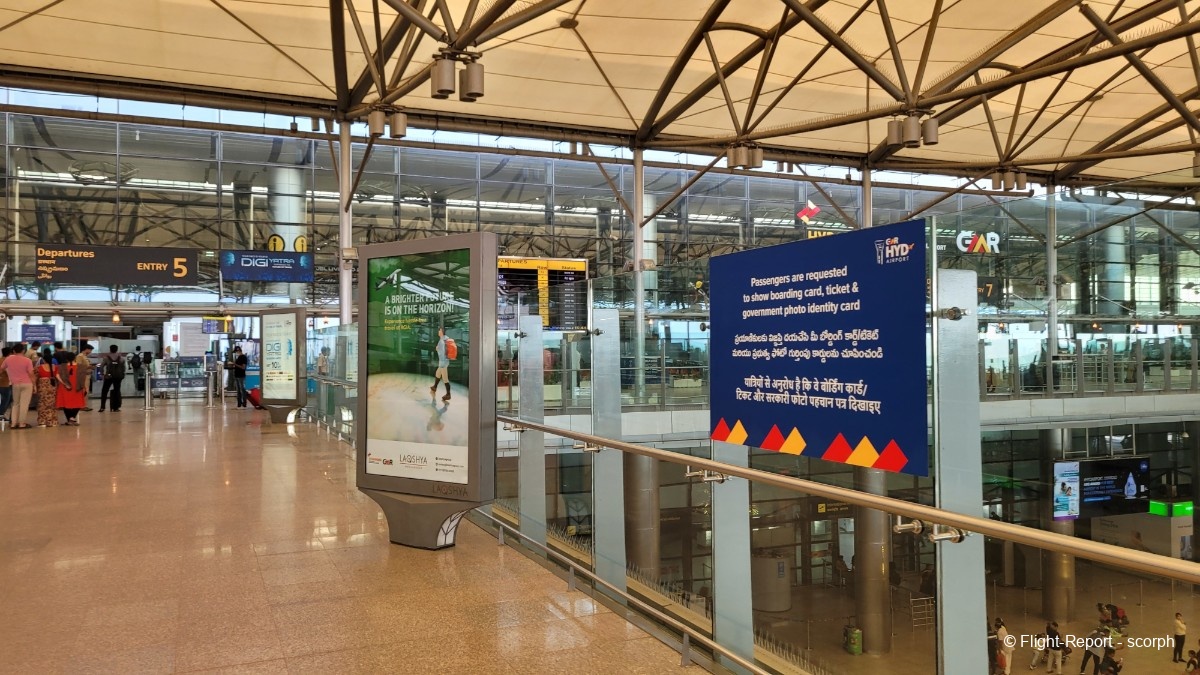
The architecture is modern for this terminal, which opened in 2008.
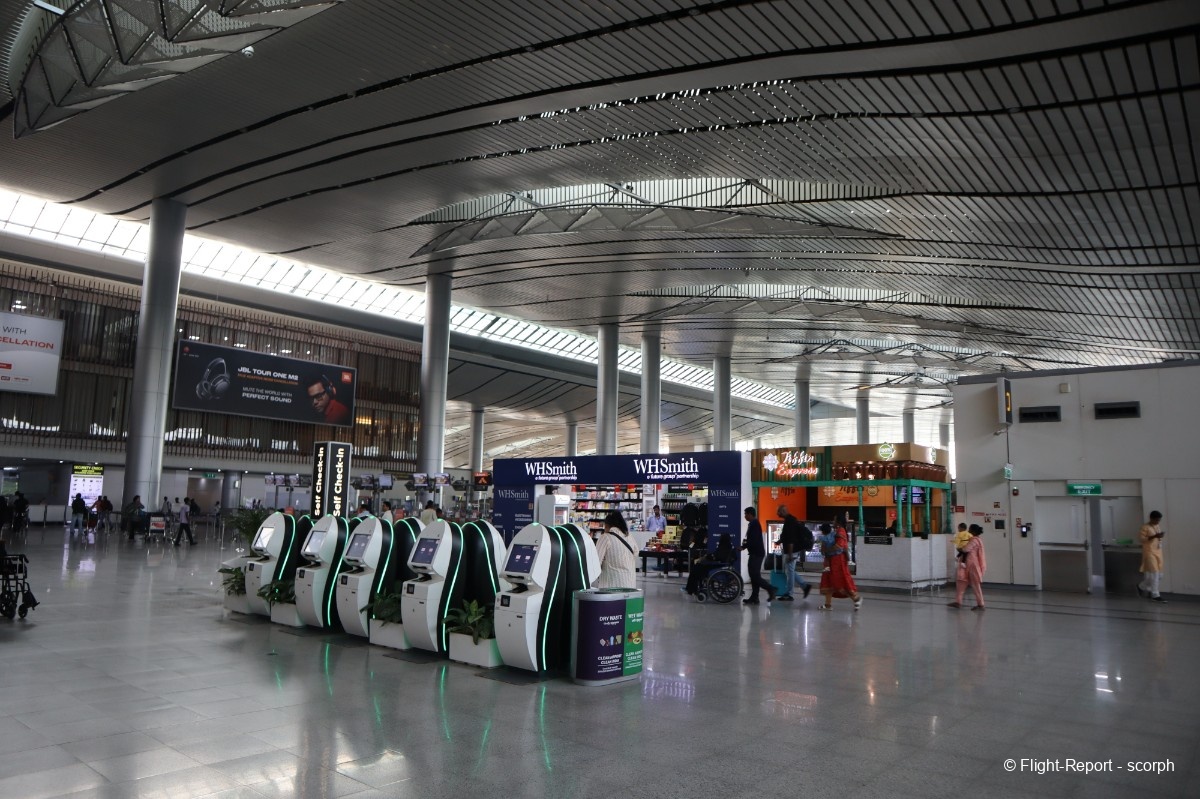
Once I’ve quickly passed through security, I head towards the self-check-in kiosks to collect my boarding pass.
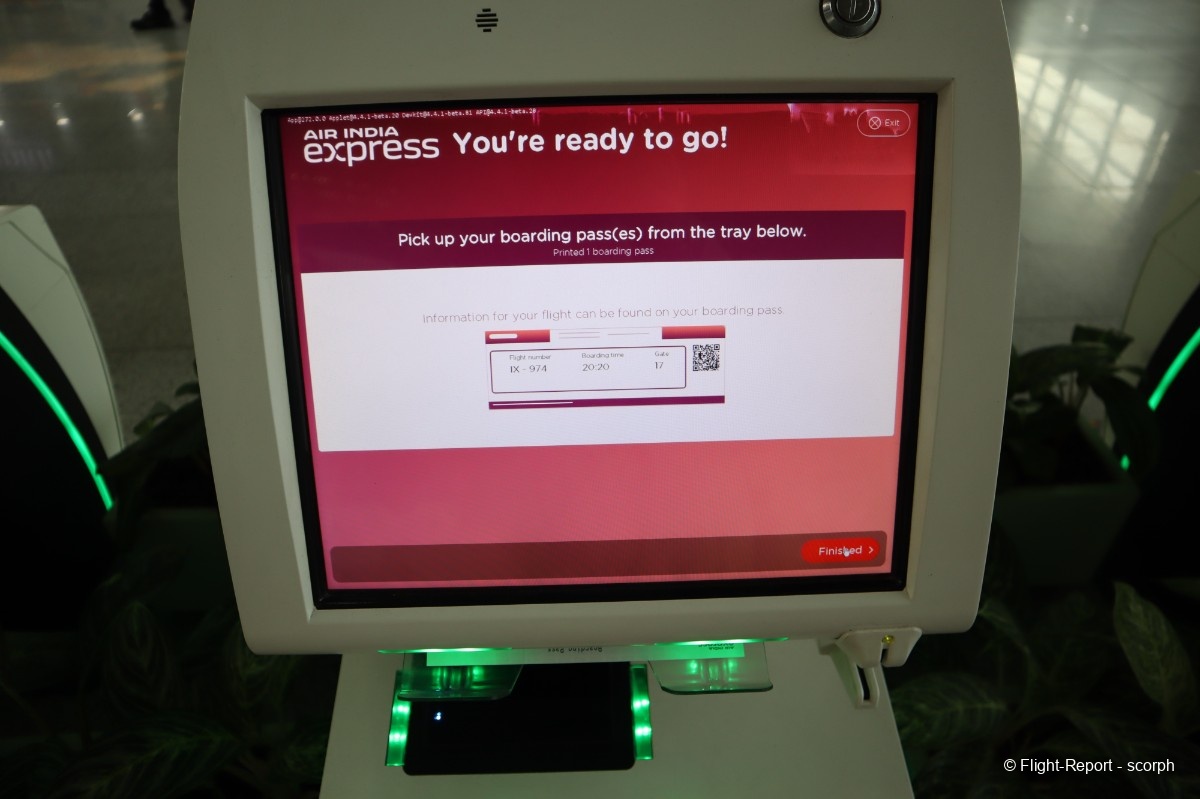
There it is, printing out in the receipt-style format.
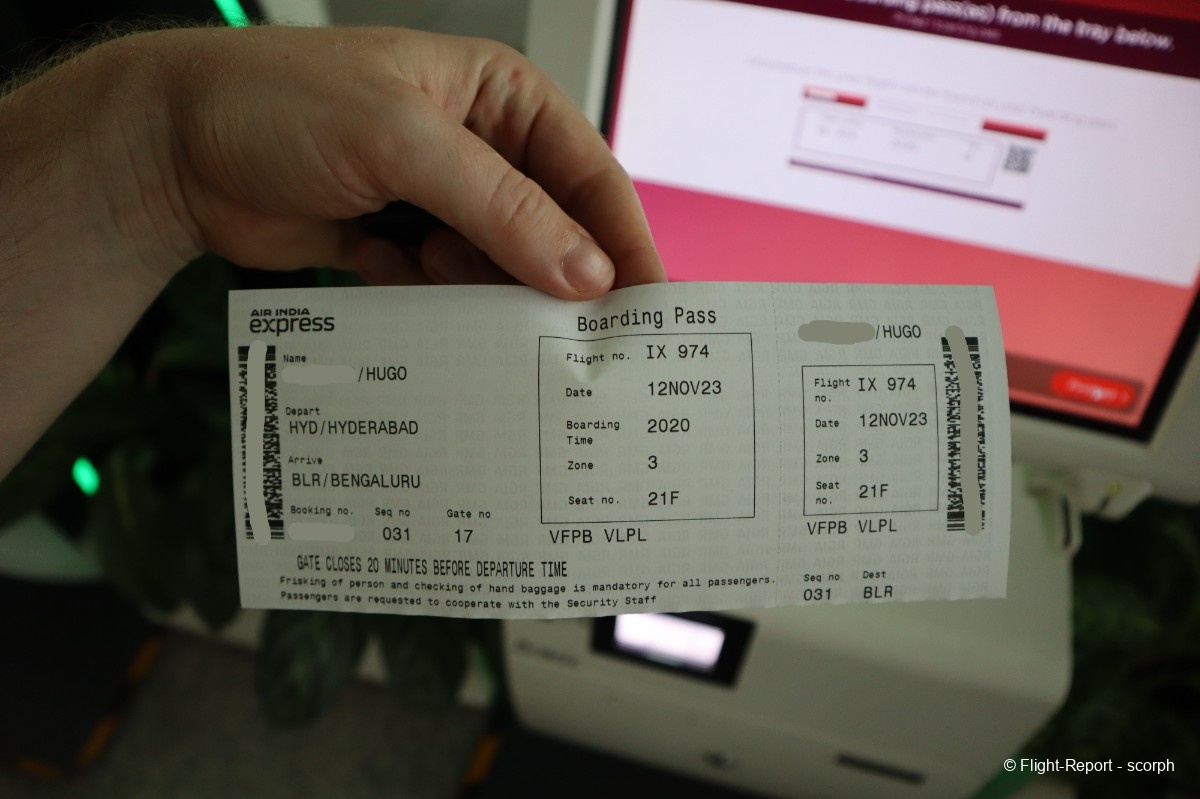
I pass by the baggage check-in counters without stopping and head towards security checks. Like all Indian airlines, Air India Express offers 15kg of checked baggage + a standard 7kg carry-on for all fare types!
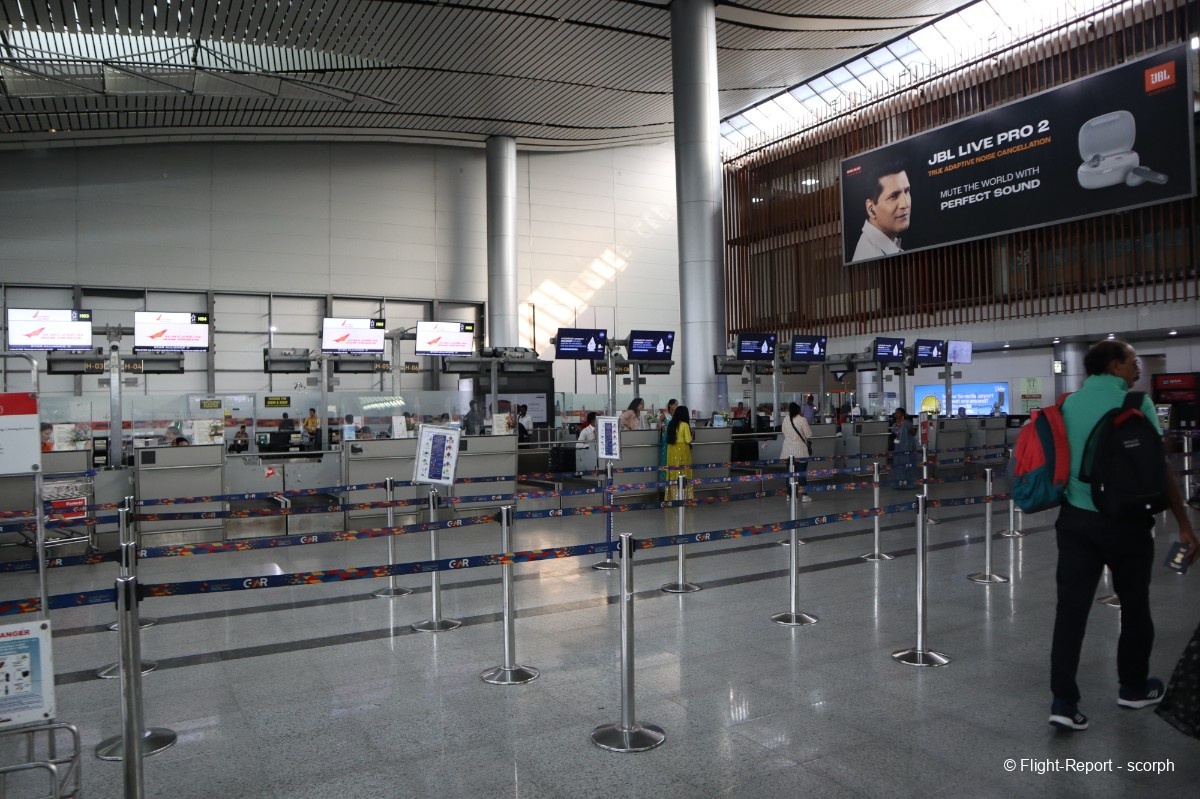
The security checks are passed quickly, despite a somewhat odd organization. My wallet attracts the attention of the agents due to a metallic shape, which turns out to be coins. It’s interesting to note that the box of cookies I bought a little earlier from a famous "Karashi Bakery" retailer doesn’t cause any issues, nor does the bottle of water. I have the strong feeling that the 100ml rule doesn’t really apply in Indian security checks for domestic flights.
Once through, I step into the airside area, which opens up into a massive shopping gallery with numerous stores, along with both Indian and international chains for food and clothing.
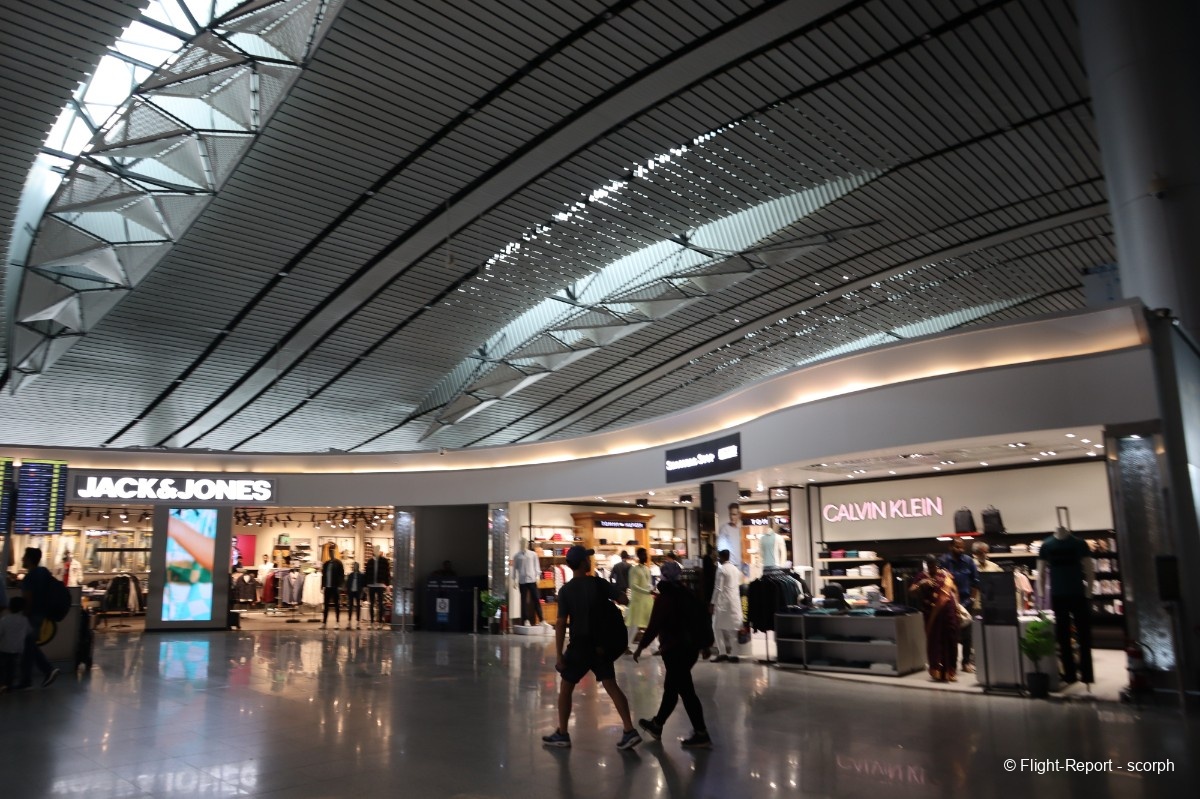
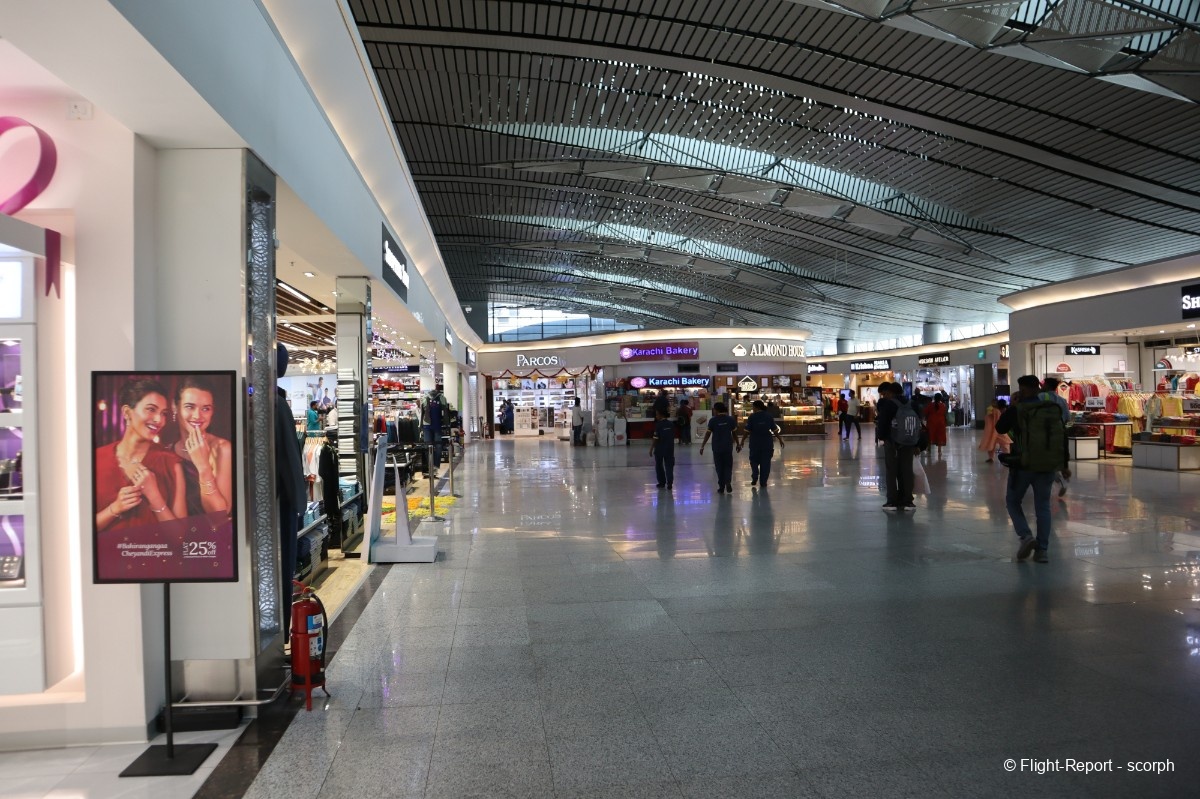
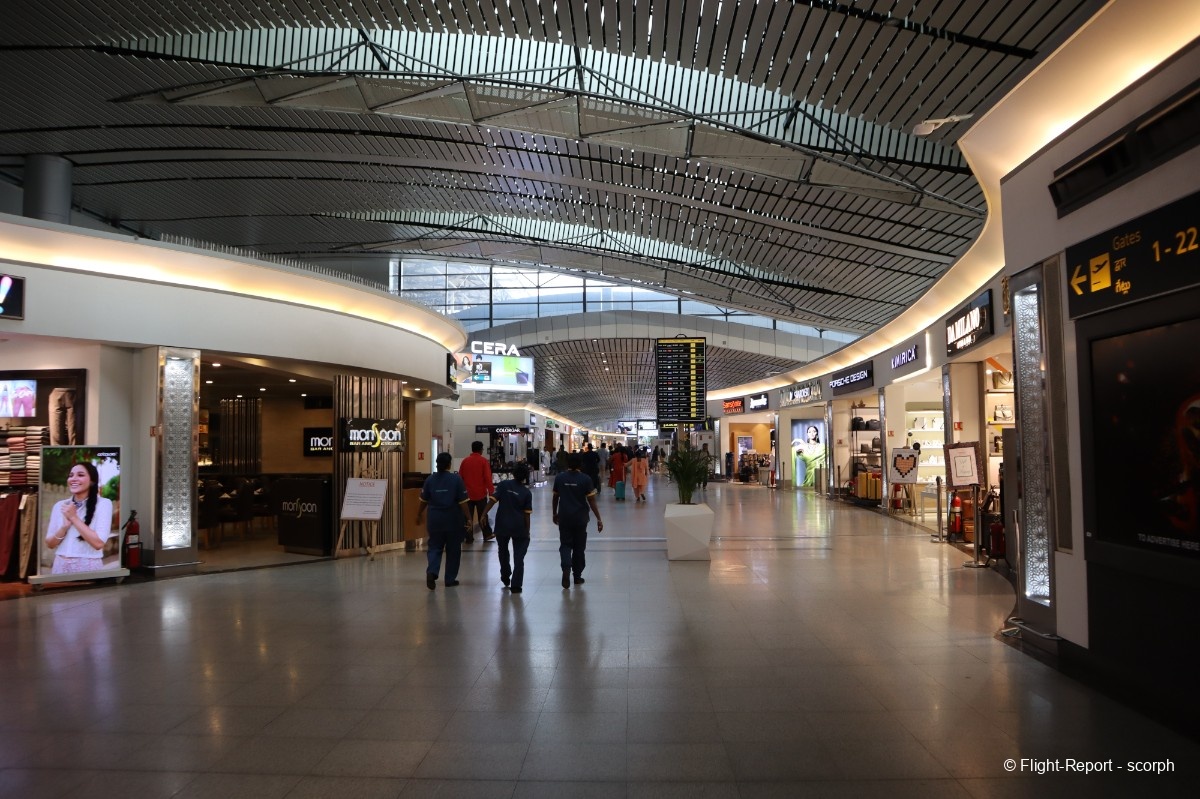
Most of the stores display promotions and decorations to celebrate Diwali, the festival of lights, which is probably one of the most important celebrations of the year across India.
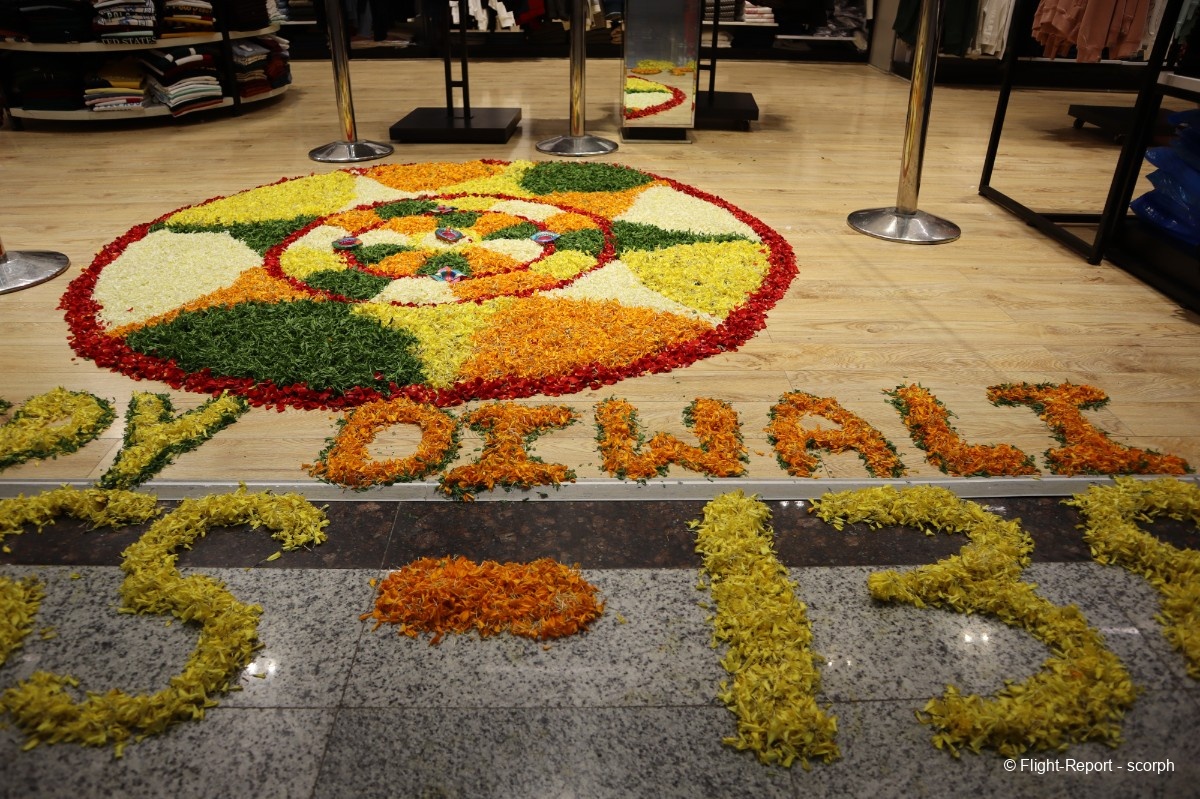
The terminal has large windows that offer a view of both the gate traffic and the runways, which will occupy a good portion of my waiting time. We kick off this spotting session with the iconic IndiGo Airbus planes that dominate the skies across the country. The A321neo will be heading to Coimbatore, in the far west of Tamil Nadu, while the A320neo, being pushed back, will depart for Chennai, the capital of Tamil Nadu.
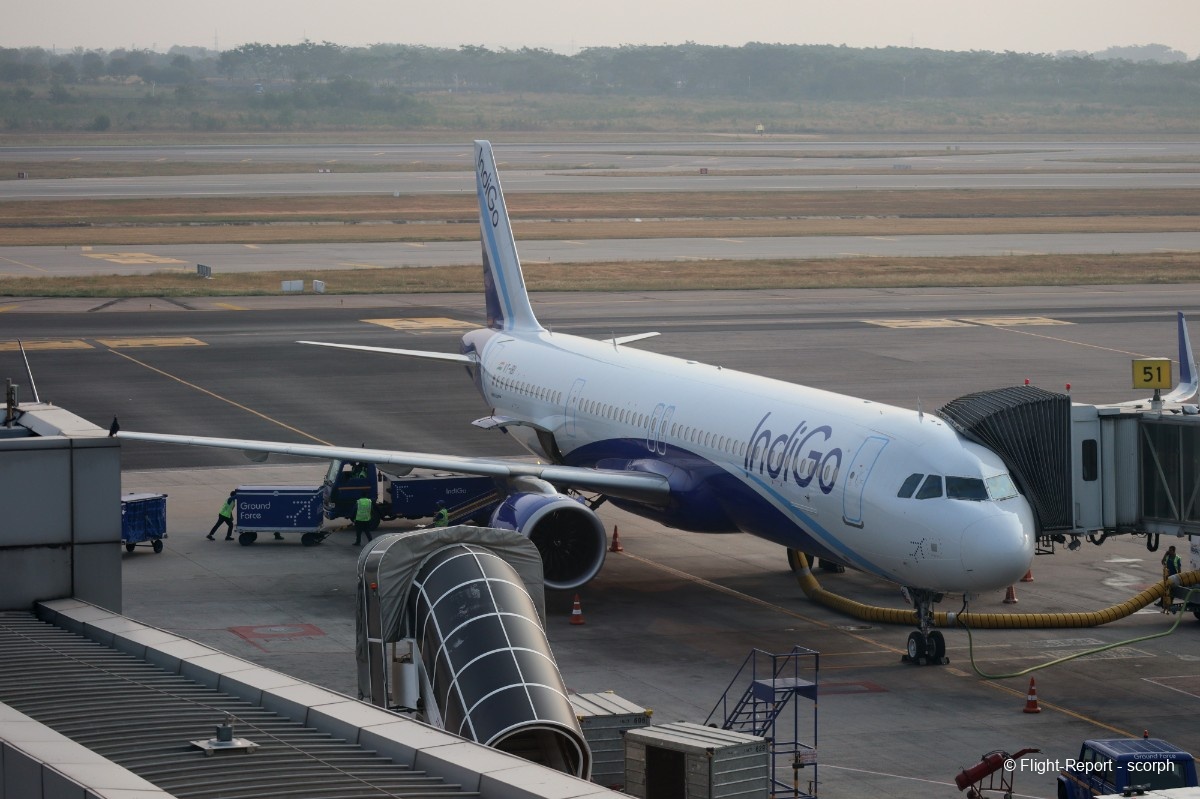
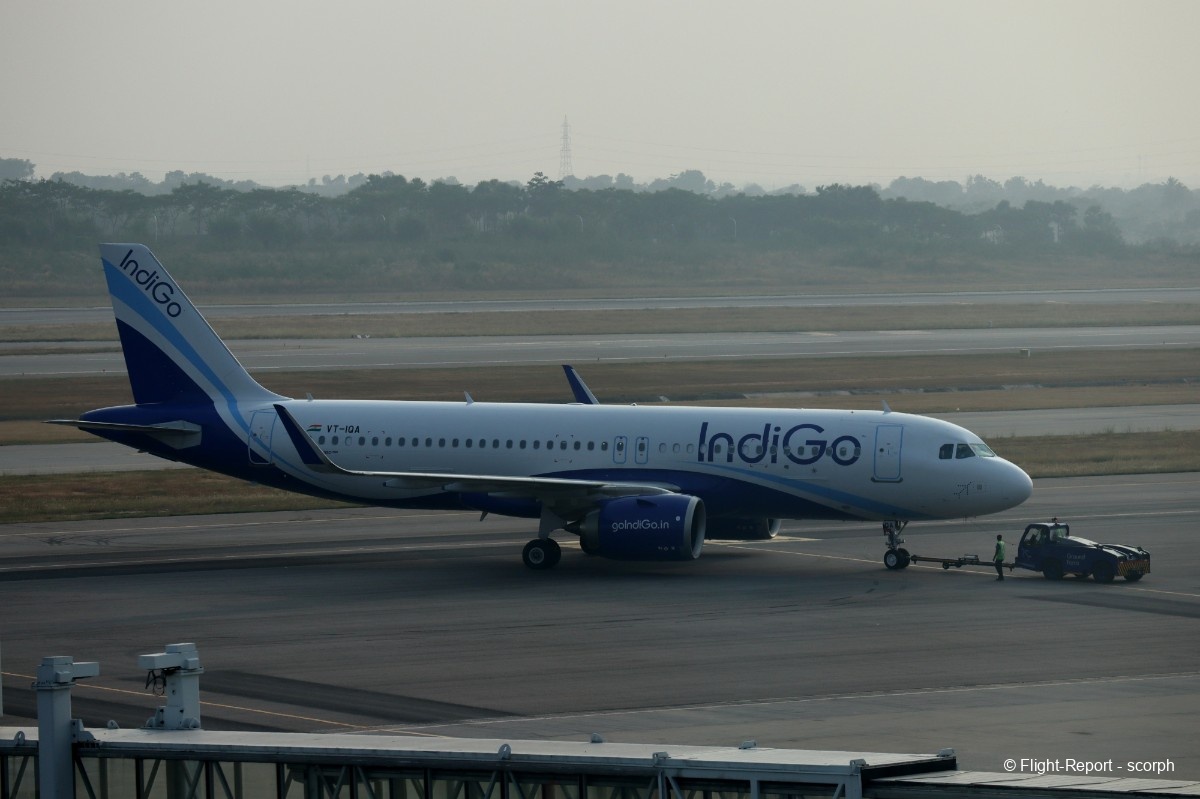
An Air India Express chartered Airbus A320 is preparing to depart for Jaipur, in Rajasthan.

Air India arrives from Tirupati (Andhra Pradesh) with an Airbus A320neo.
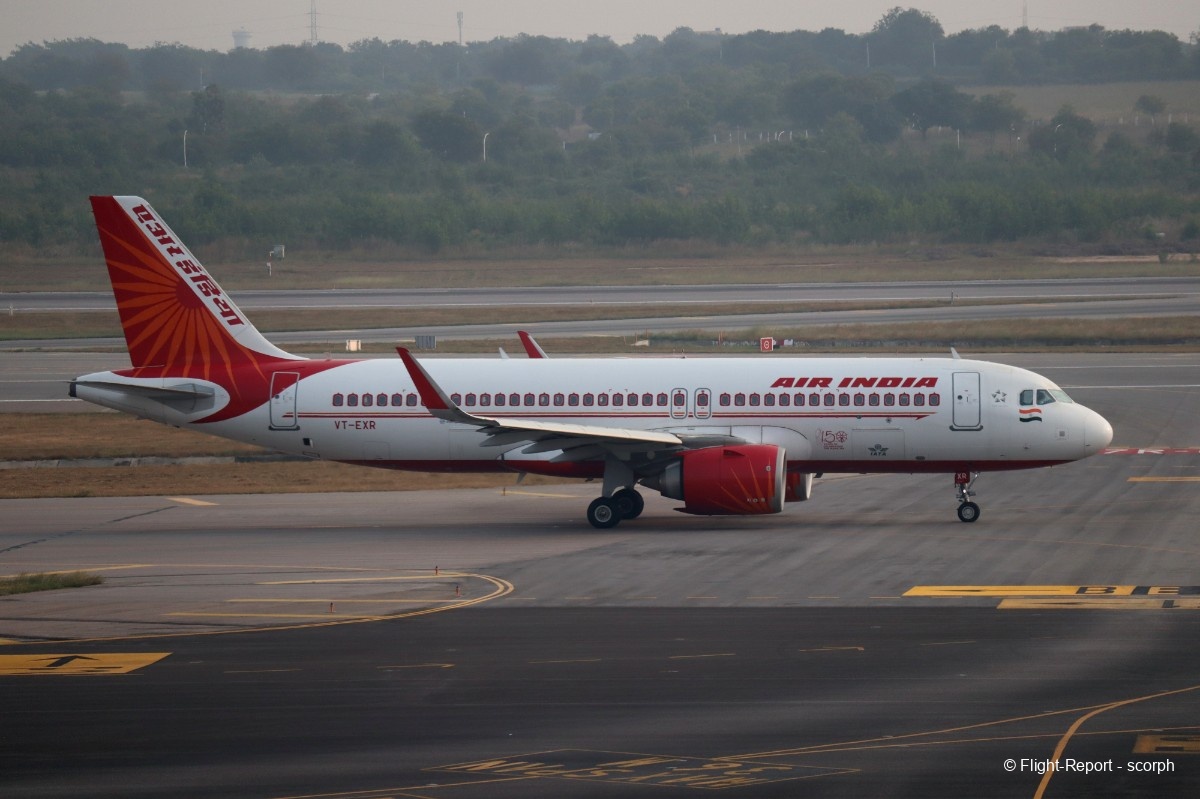
A longer version of the Neo, with this A321neo from IndiGo arrives from the Sri Lankan capital, Colombo.

The latest low-cost carrier is also present with its Boeing 737 MAX-8s, including this one, which will head to Delhi in the evening. Just behind, you can spot a private jet, a Hawker 900XP, parked at the gate.
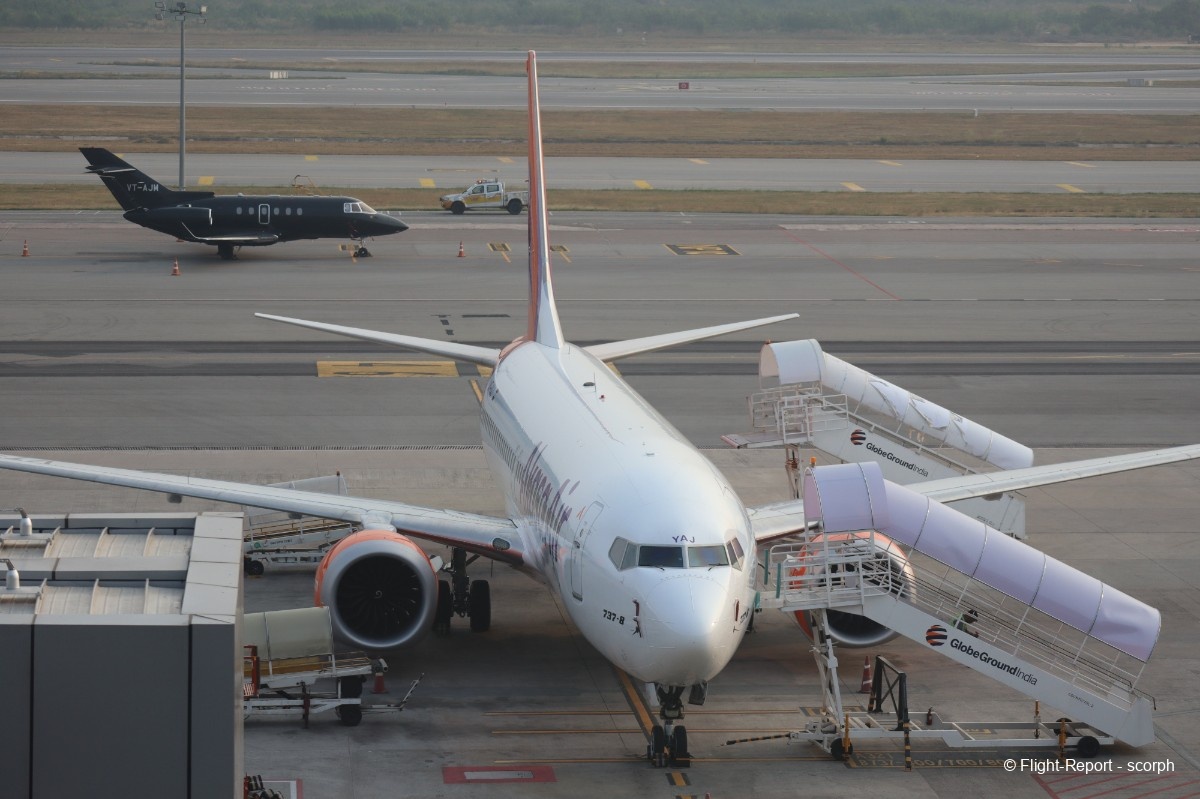
A small ATR72-600 from Alliance Air arrives from Chennai (Madras). This small airline, once a regional subsidiary of Air India, was not part of the deal when Tata acquired the Air India group. Operating in India's secondary market, it has a fleet of about twenty ATRs, along with a few Dornier 228s provided by the Indian aircraft manufacturer Hindustan.
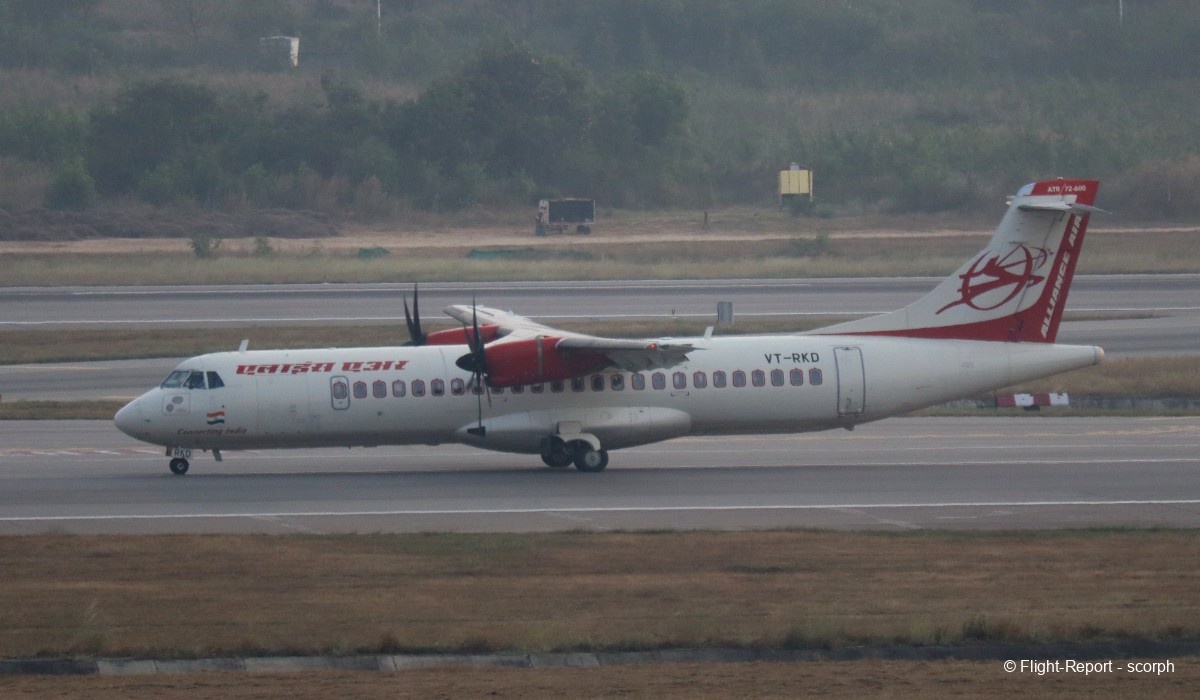
Our ATR will head towards the remote parking area, while in the foreground, you can spot an Embraer Legacy 650 (the VIP version of the ERJ135) registered in the principality of San Marino.
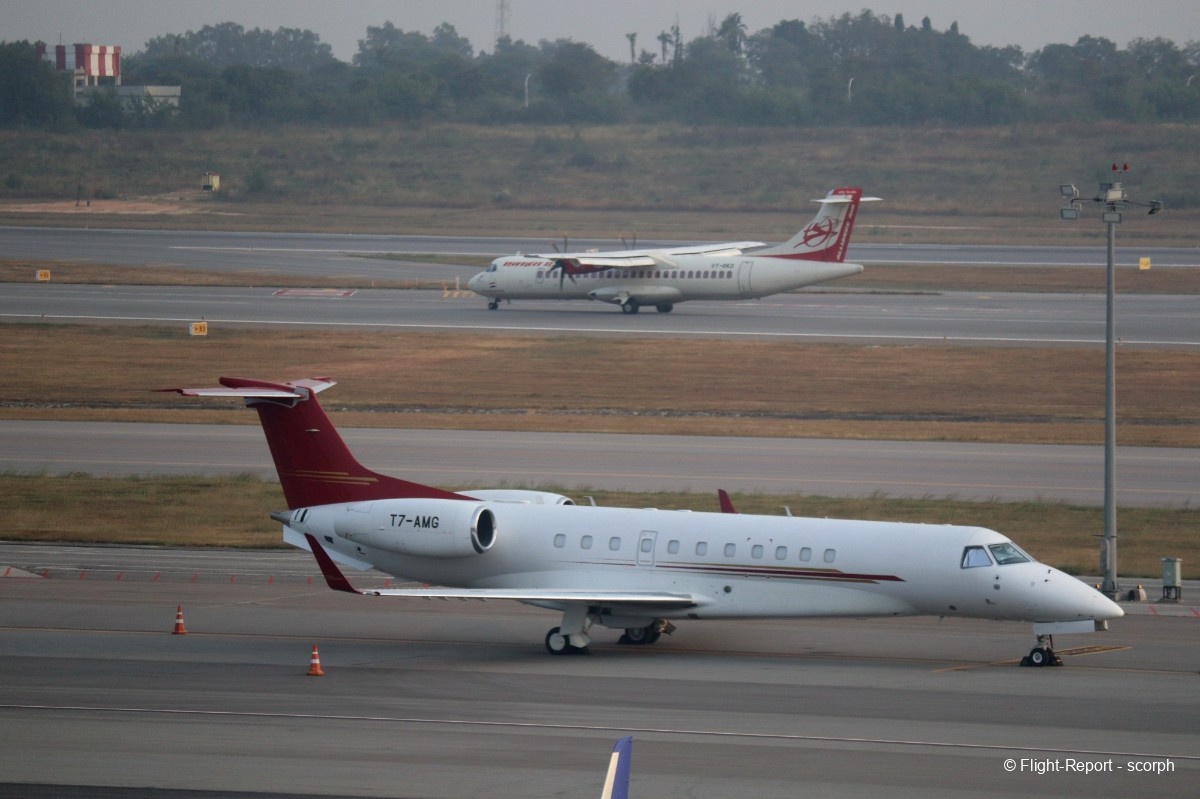
Then it’s time for my aircraft of the day to make its entrance. The sleek B737 MAX-8 has turned into a pumpkin with this good old -800. This plane certainly follows the same routes as me; we saw it the day before departing from BLR. With nearly 15 years of service for Air India Express, it’s safe to say this bird has been around the Indian skies… and sometimes a bit beyond. In fact, this aircraft was involved in a runway excursion in 2019 at Mangalore and was repaired after a month of work! On the left side, the livery features a depiction of the "Ellora Caves," a UNESCO World Heritage site located in the state of Maharashtra.
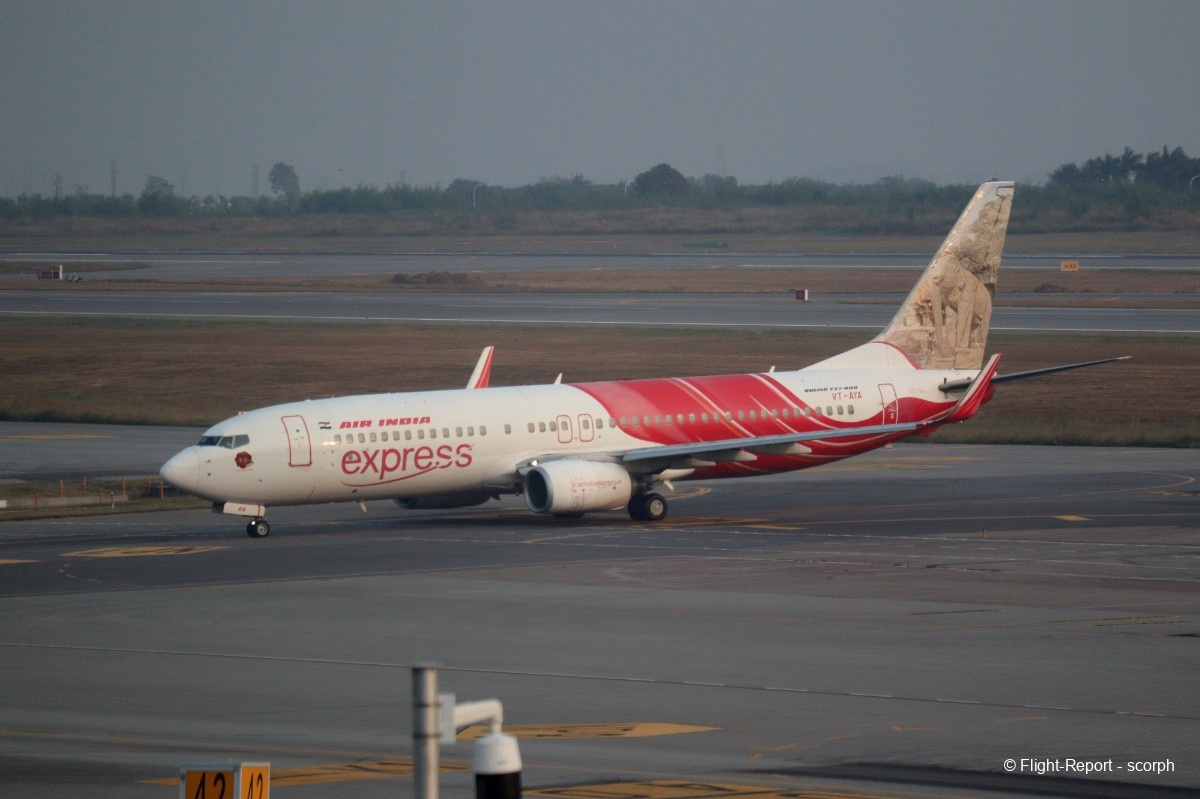
On the right side, we find a depiction of the "Ajanta Caves," also located in the state of Maharashtra.
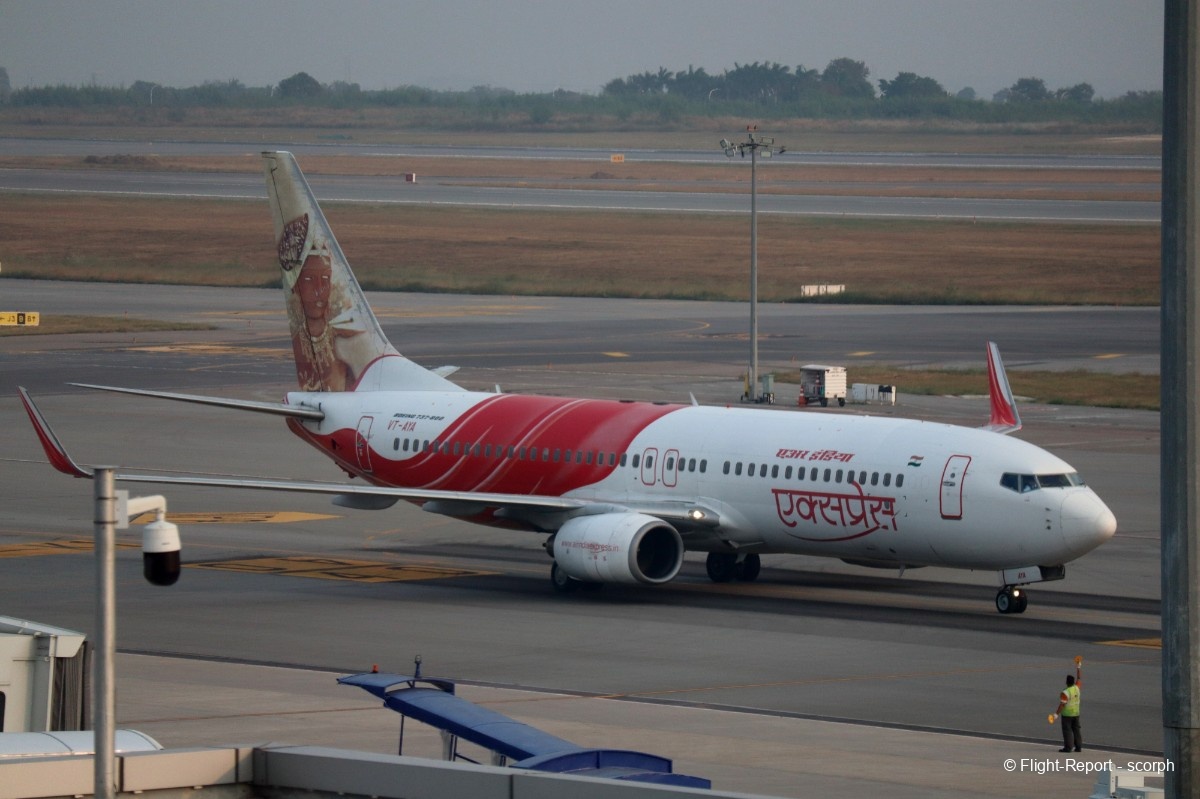
A few close-ups of our aircraft for the evening… well, not yet, as it’s running over an hour late and still needs to make a round trip to Goa before coming to pick us up! ^^
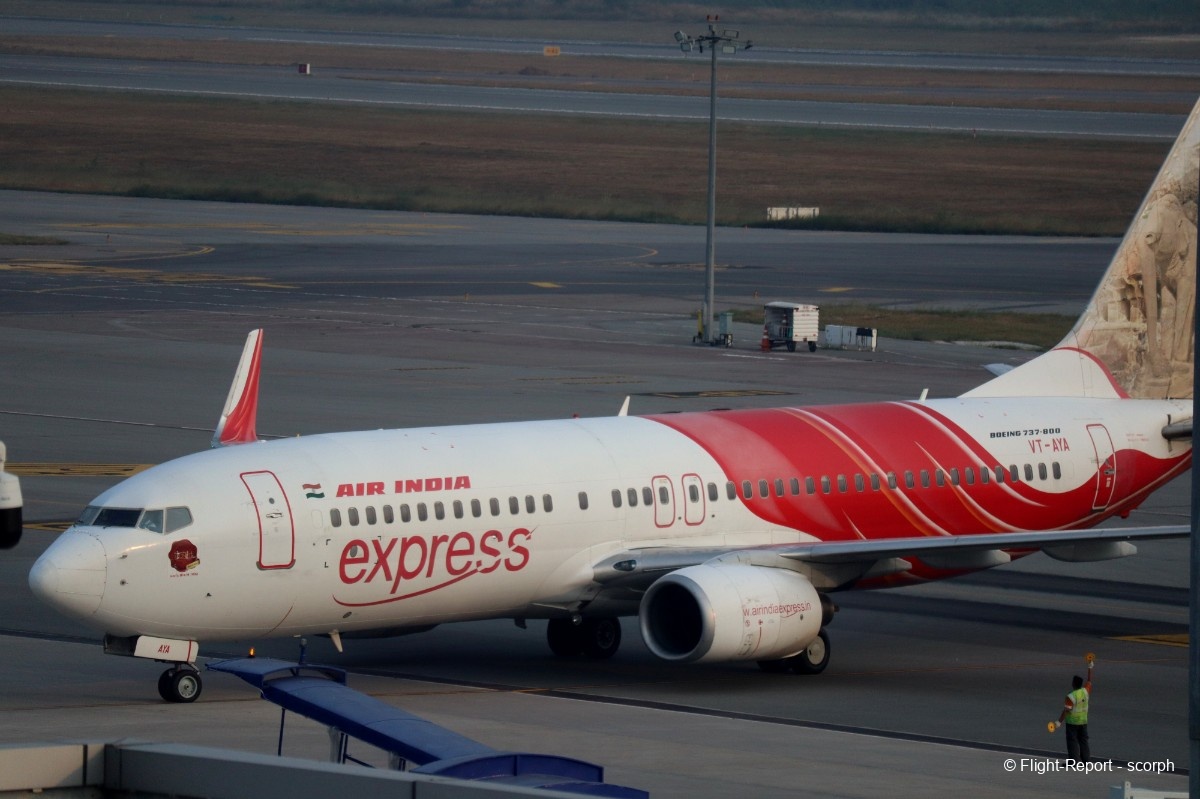
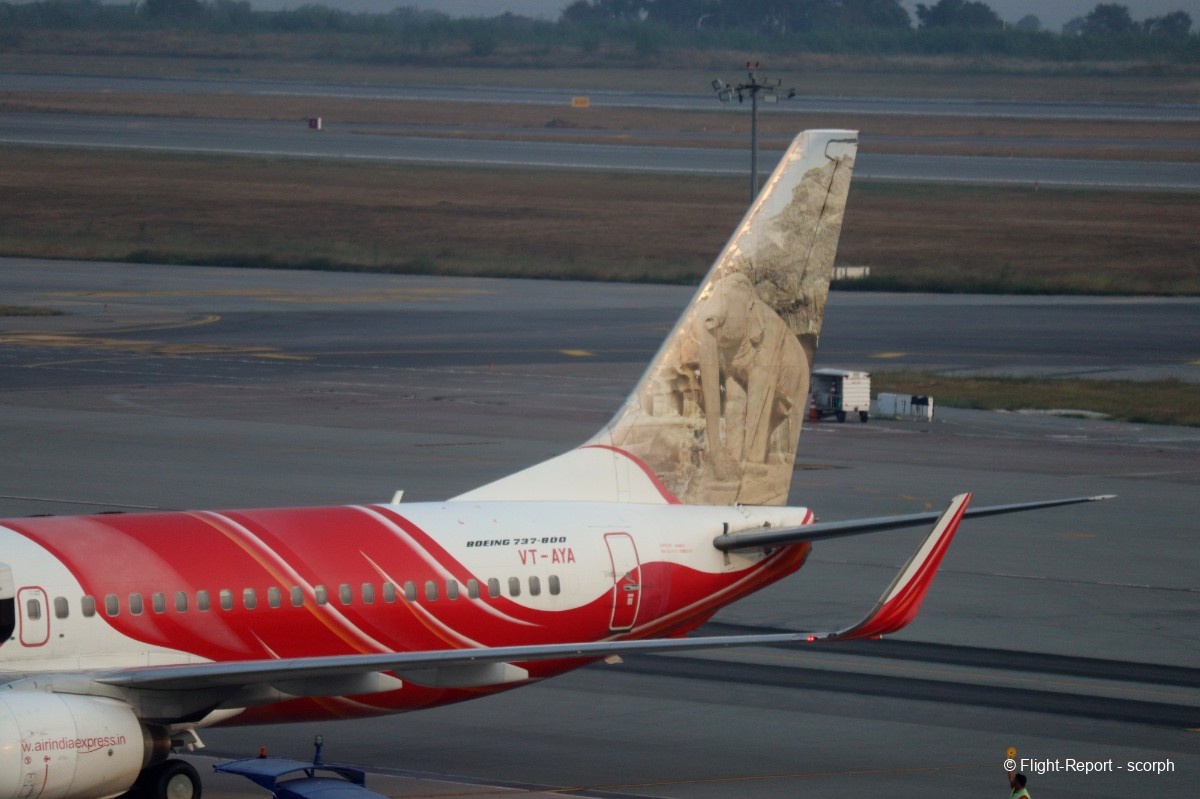
Well, at least I have time to spot in peace with this SpiceJet Boeing 737-700 heading to Chennai (Tamil Nadu). SpiceJet, once a thriving airline, took a massive hit from COVID. Heavily indebted and with many aircraft on lease, the airline almost went under during the 2021/2022 recovery. Now, it’s just a shadow of its former self, with barely over 30 aircraft still in service.
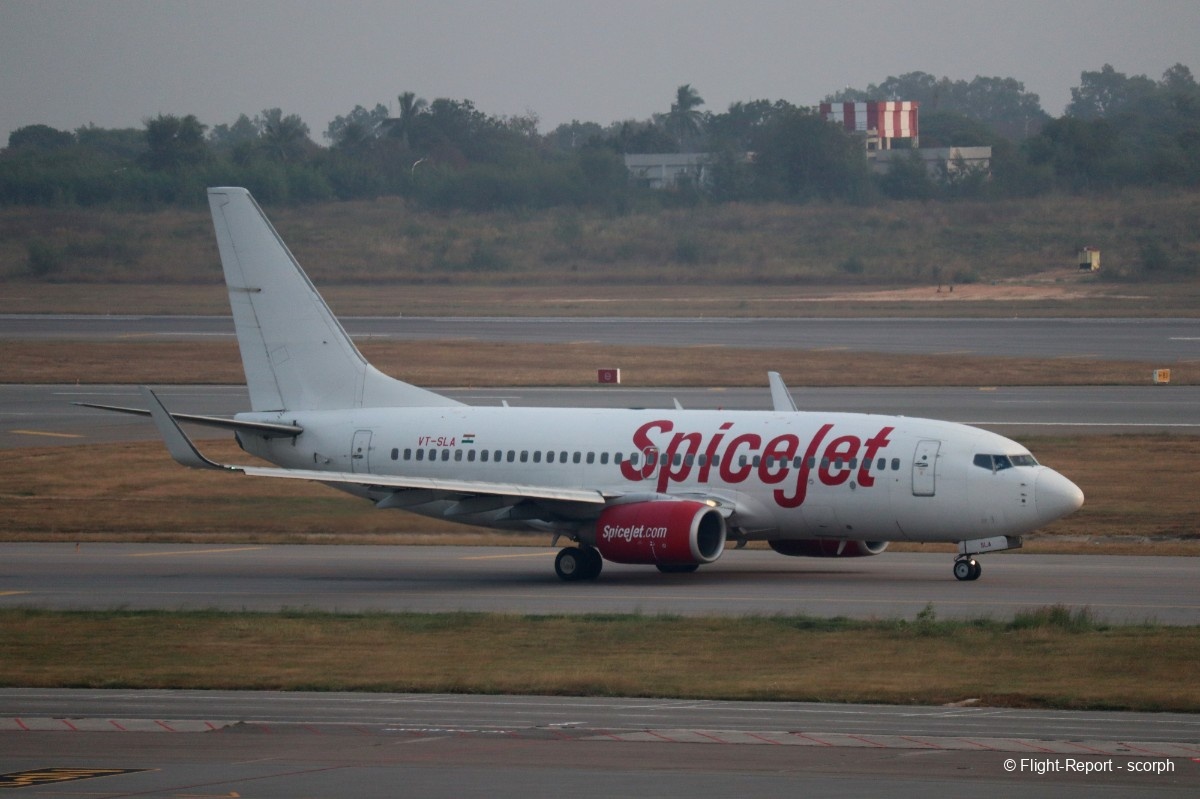
It’s true that the competition is fierce, with Indigo dominating the Indian domestic market by a long shot, thanks to its fleet of Airbus A320neos, like this one arriving from Madurai.
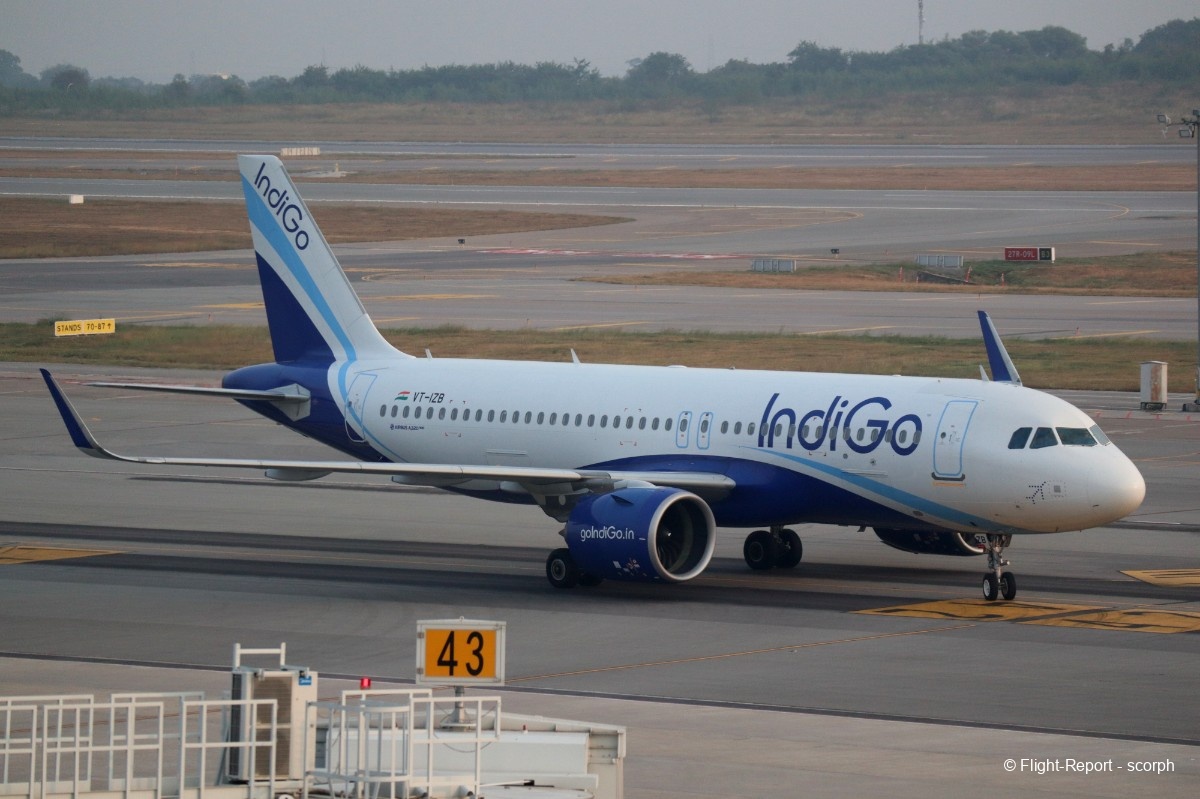
Another major user of the Airbus Neo family is Vistara, here with an Airbus A321neo arriving from Delhi.

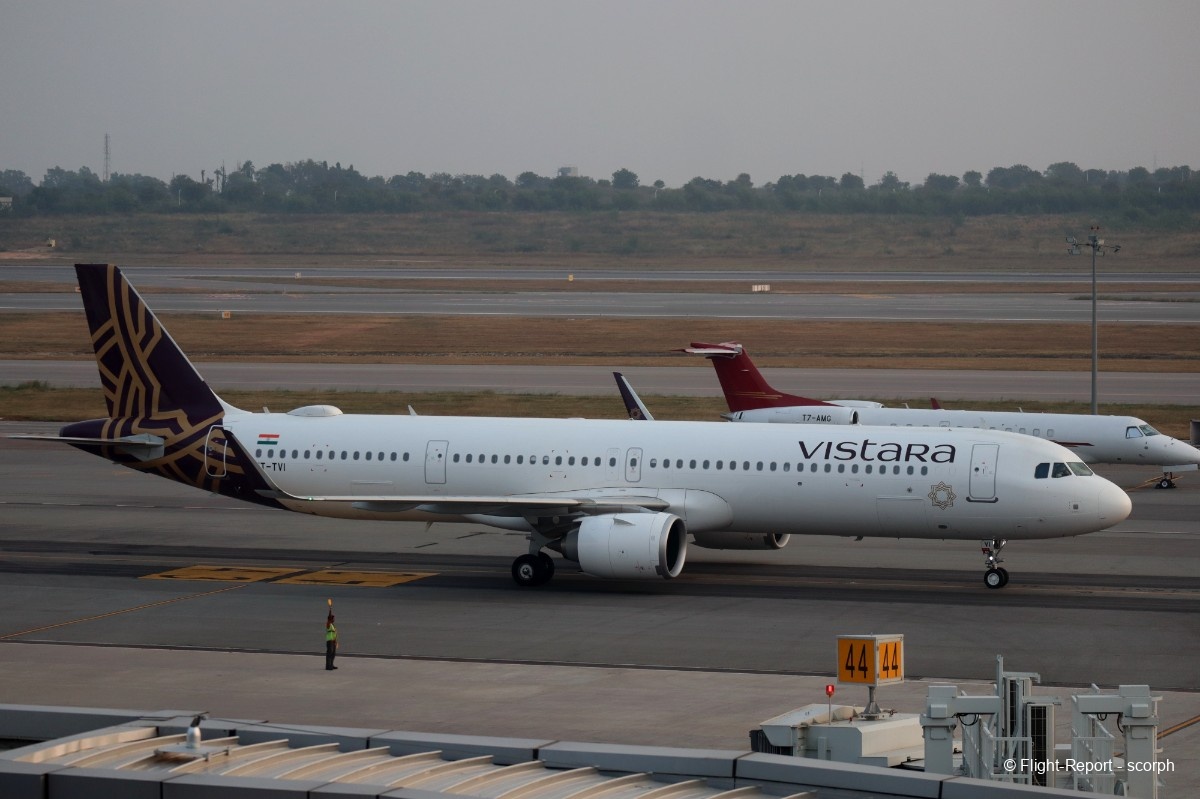
However, IndiGo doesn’t only operate Airbus aircraft; it also has a solid fleet of 45 ATR72-600s (which must make it one of the largest operators of this model in the world). This fleet allows them to serve secondary airports, like Jabalpur in the state of Madhya Pradesh (in central-northern India).
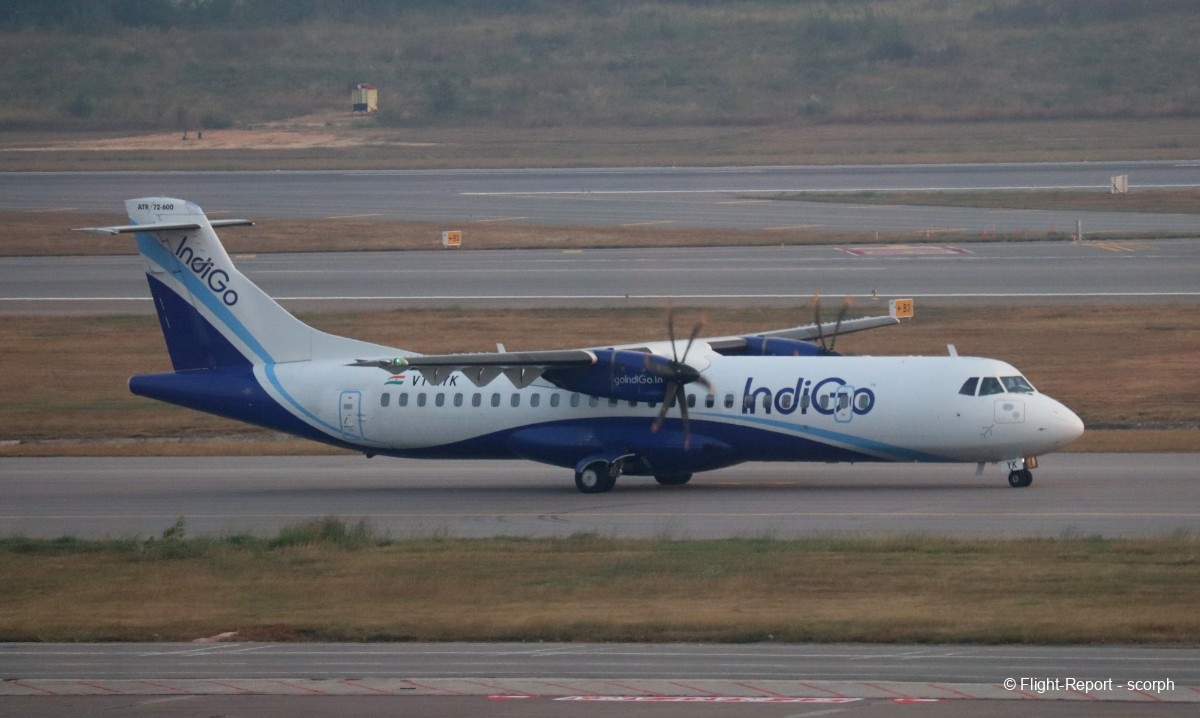
While the average person travels at 78 seats in an ATR, some, on the other hand, travel in luxury aboard this Embraer Lineage 1000, the private jet version of the ERJ 190, with just a few passengers onboard.
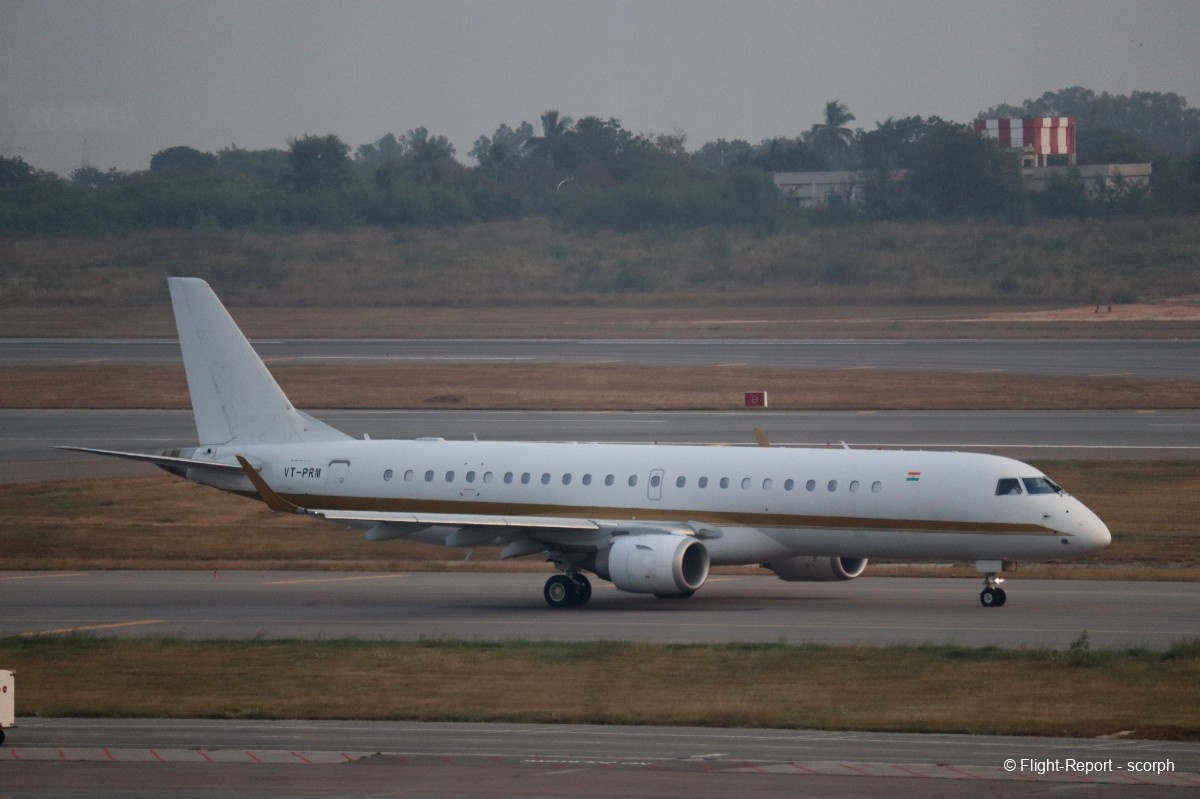
Akasa Air, the small low-cost carrier making its rise in the Indian market, operates Boeing 737 MAX-8s. Here, another MAX-8 arrives from the new Mopa Airport in Goa.
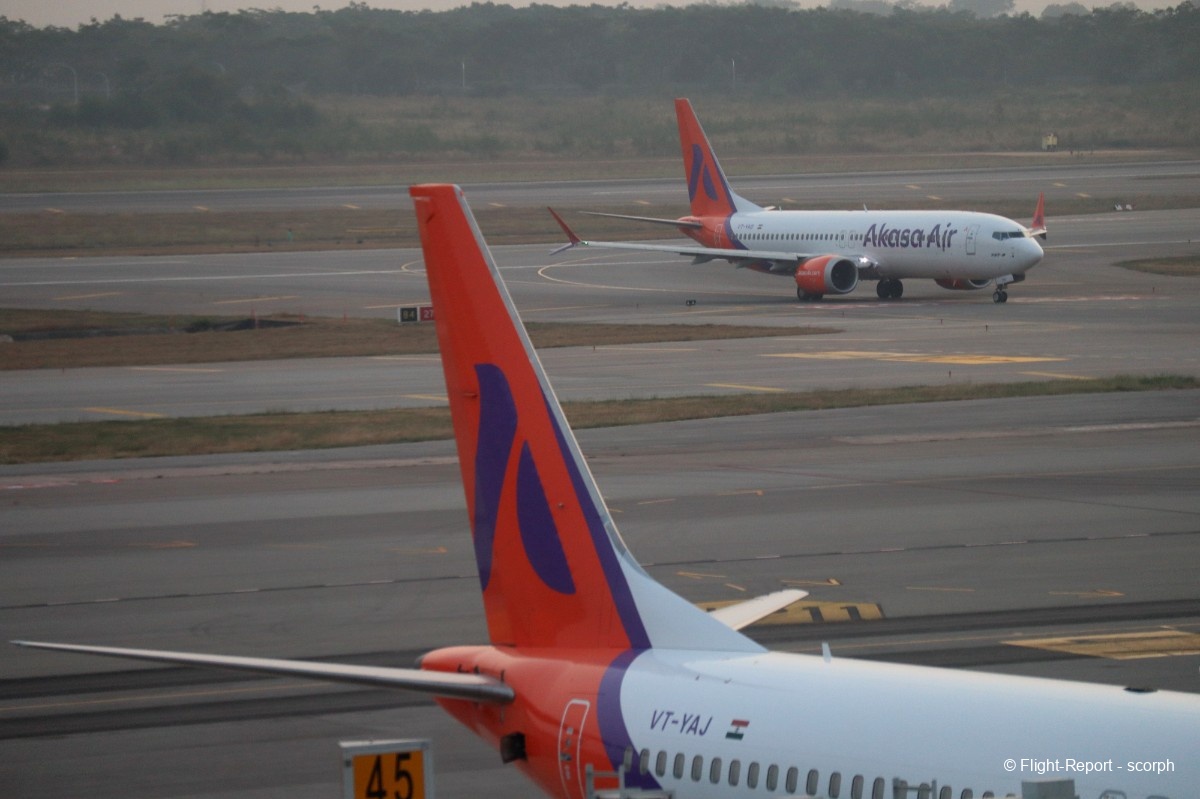
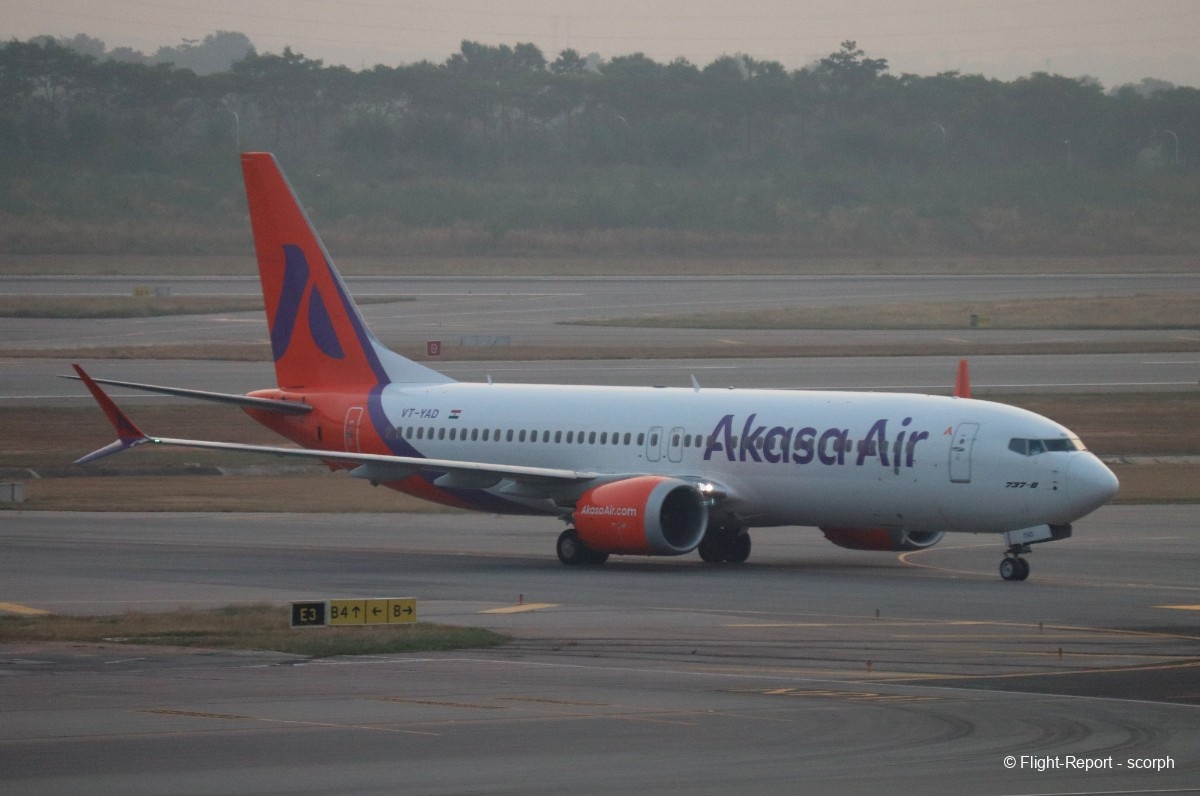
The previously seen Airbus A320neo is now ready to depart again, this time heading to Visakhapatnam, located on the eastern coast of the country in Andhra Pradesh.
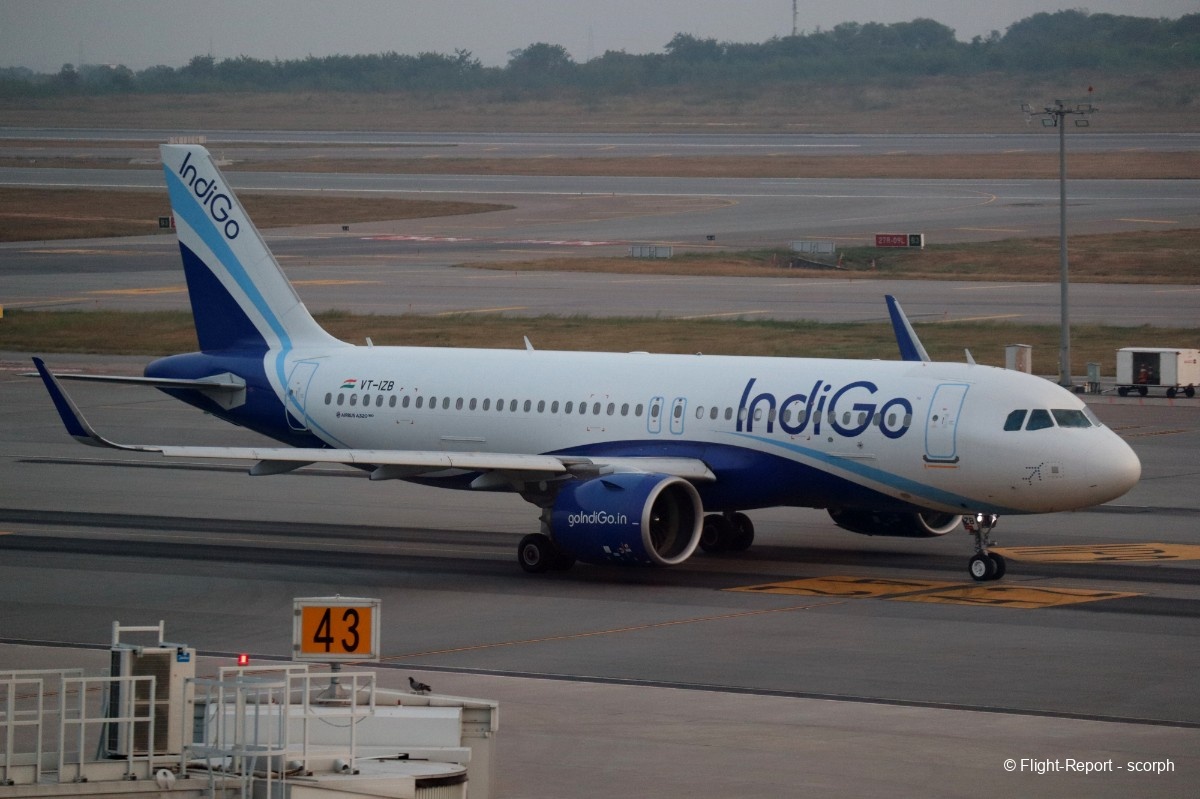
Another Airbus A320neo, this time from Vistara, arrives from Mumbai.
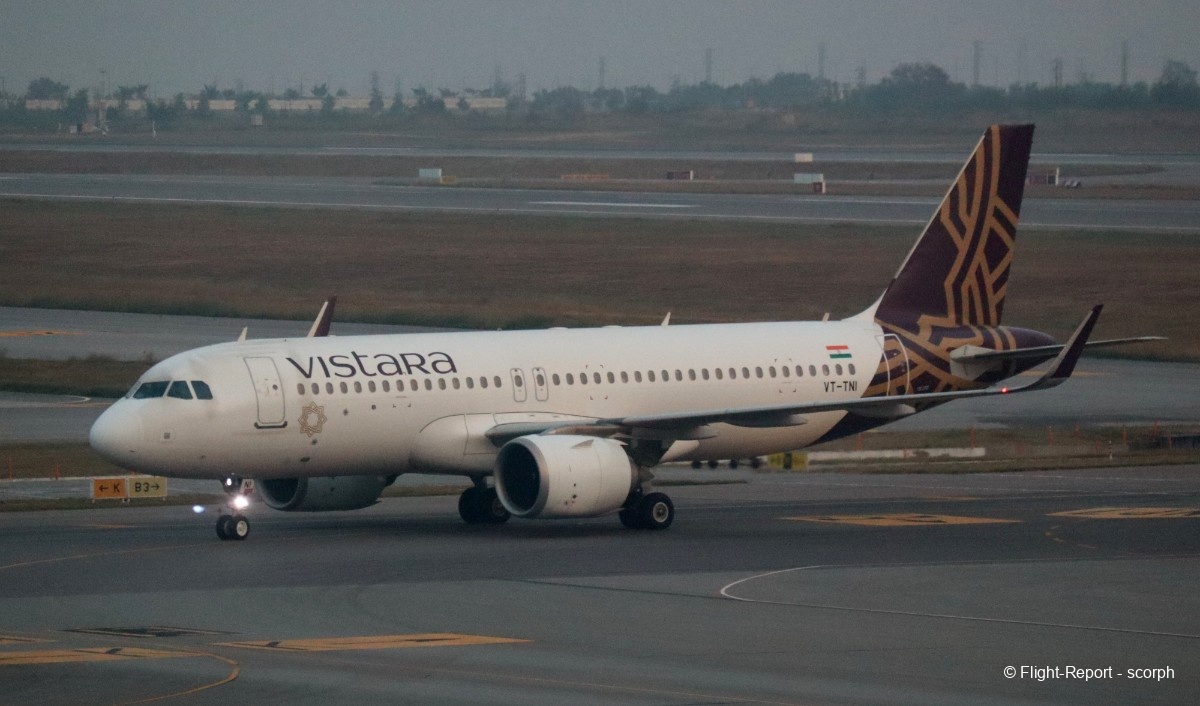
No matter where you are in India, it’s hard to escape the IndiGo wave. Here, two of their aircraft are taxiing, with the ATR heading to Rajahmundry in Andhra Pradesh.
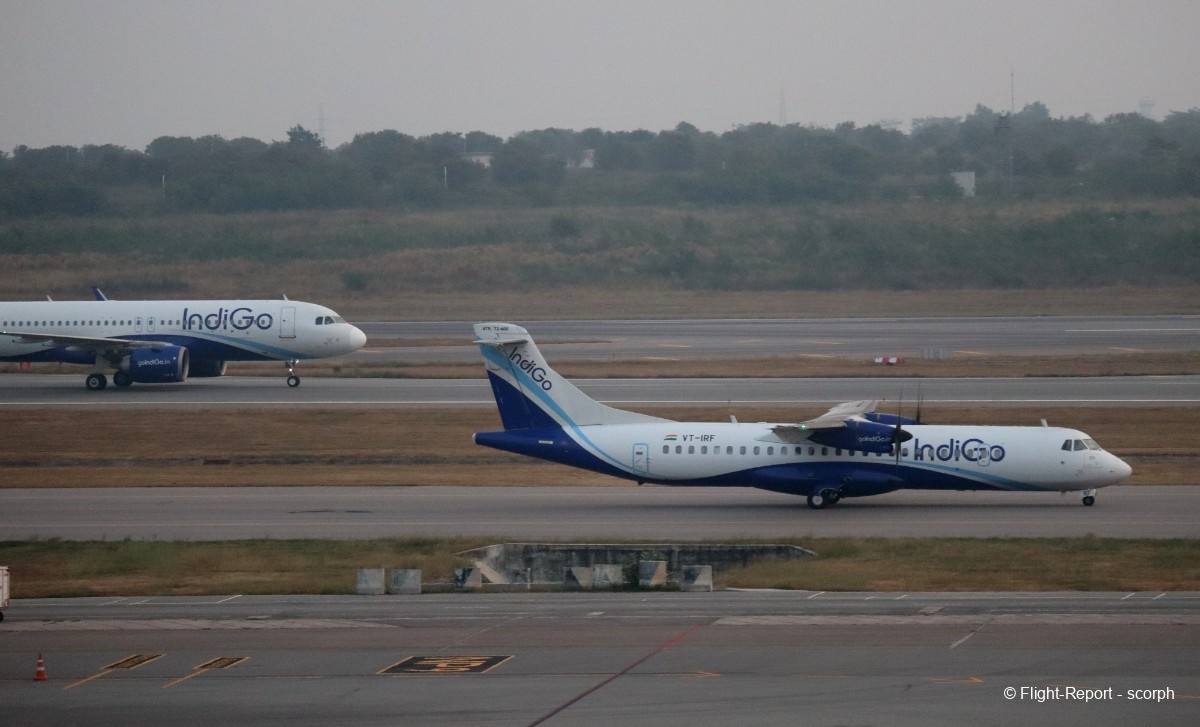
My aircraft for the day departs with a significant delay of over an hour, heading for a rotation to Goa Dabolim.
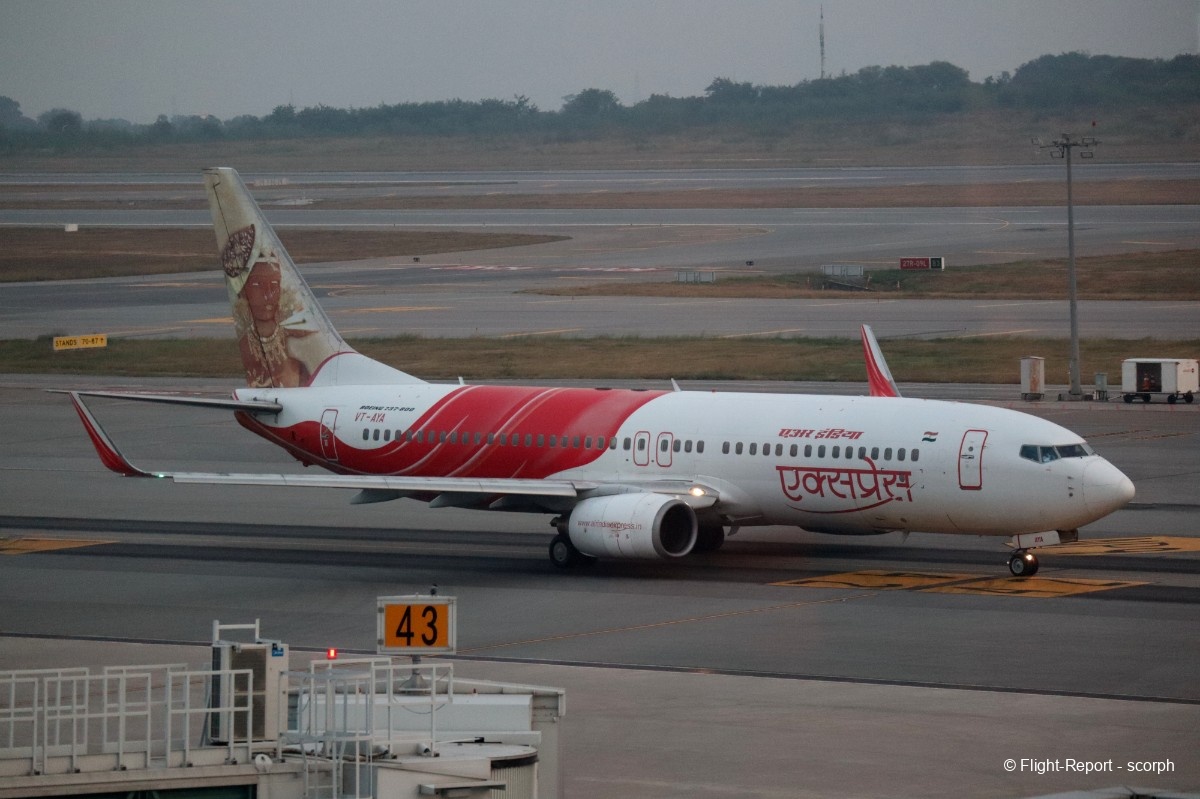
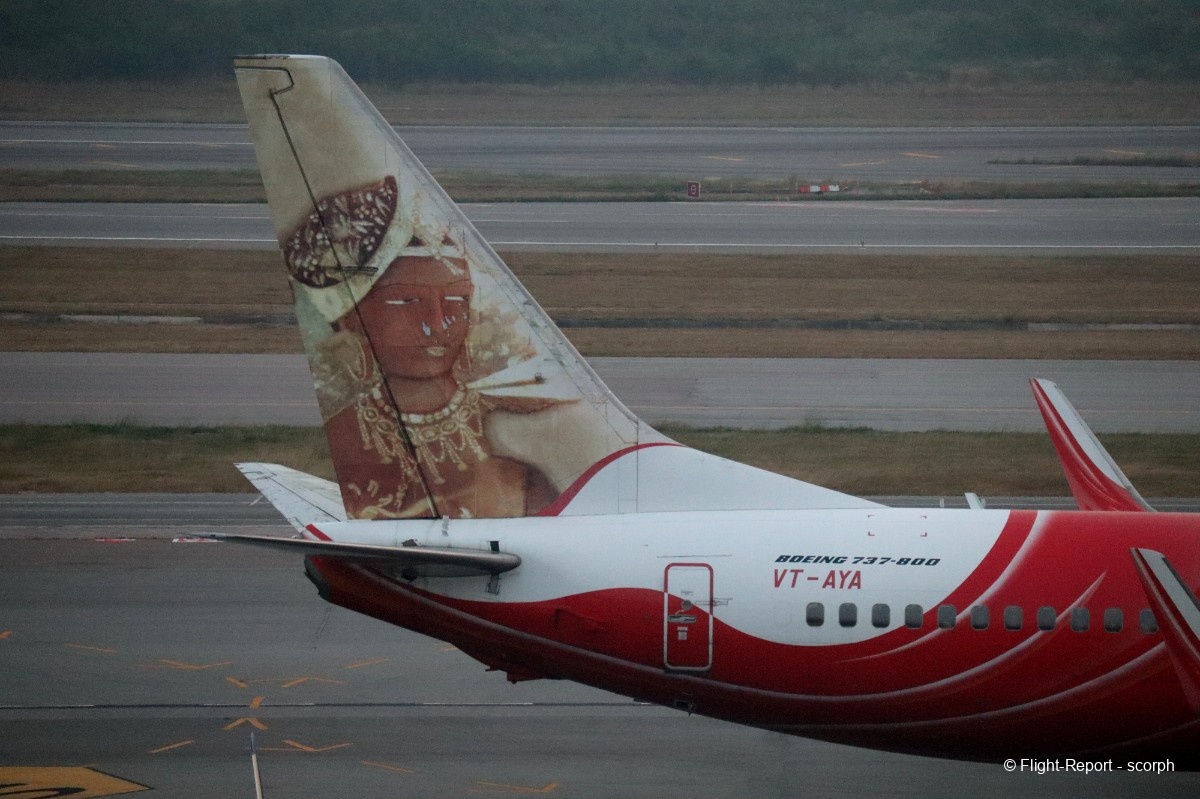
The terminal is modern and vast, with an older section that’s already well-equipped and features a fairly modern design. There are plenty of shops and food stalls, and I’ll grab a quick meal at one of them.
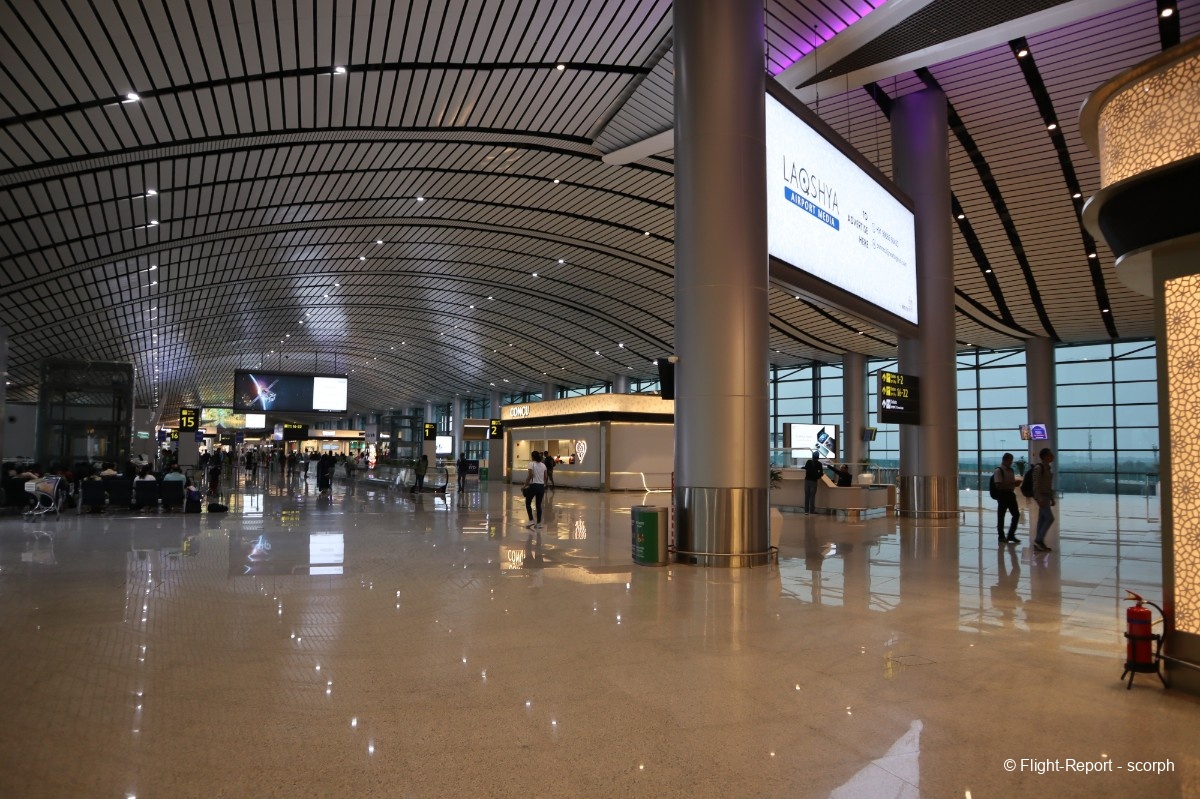
There are even a few French brands, like Relay, in the terminal.
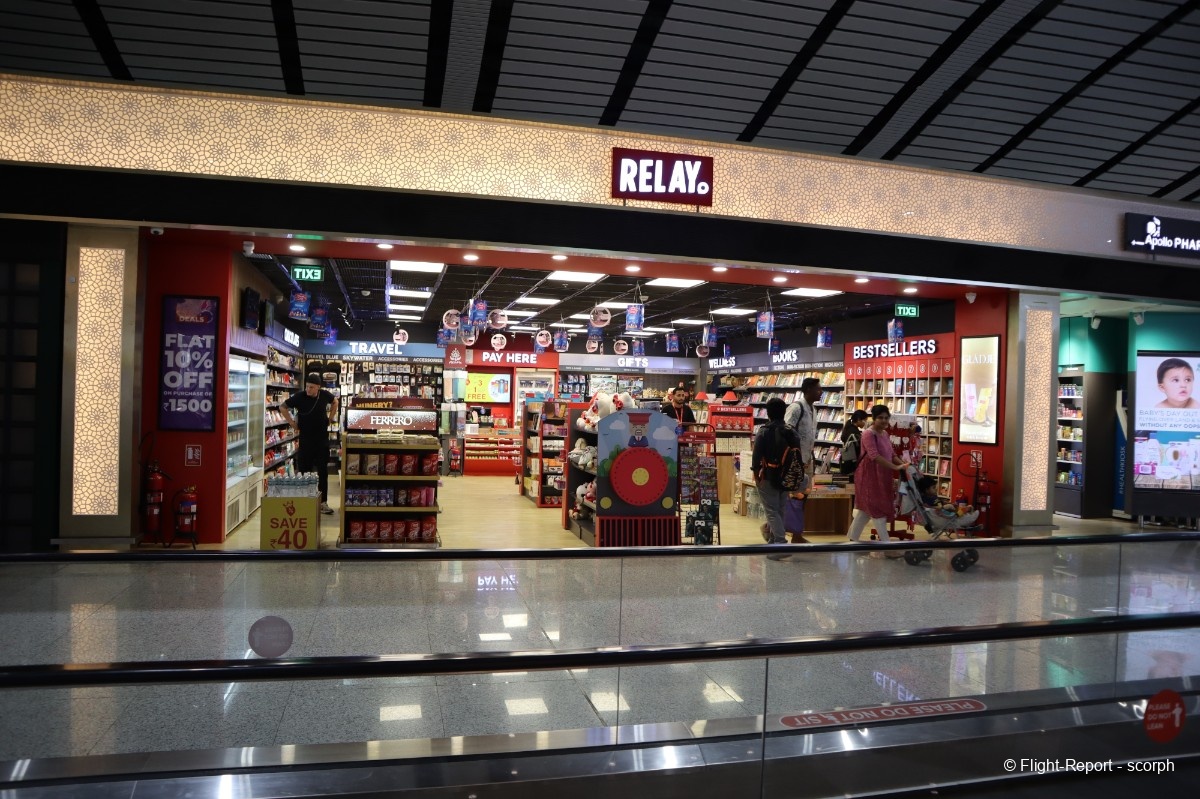
The FIDS (Flight Information Display System) is first in Telugu (the language of the Telangana region), then in a version that's more understandable for the Westerners! 😊
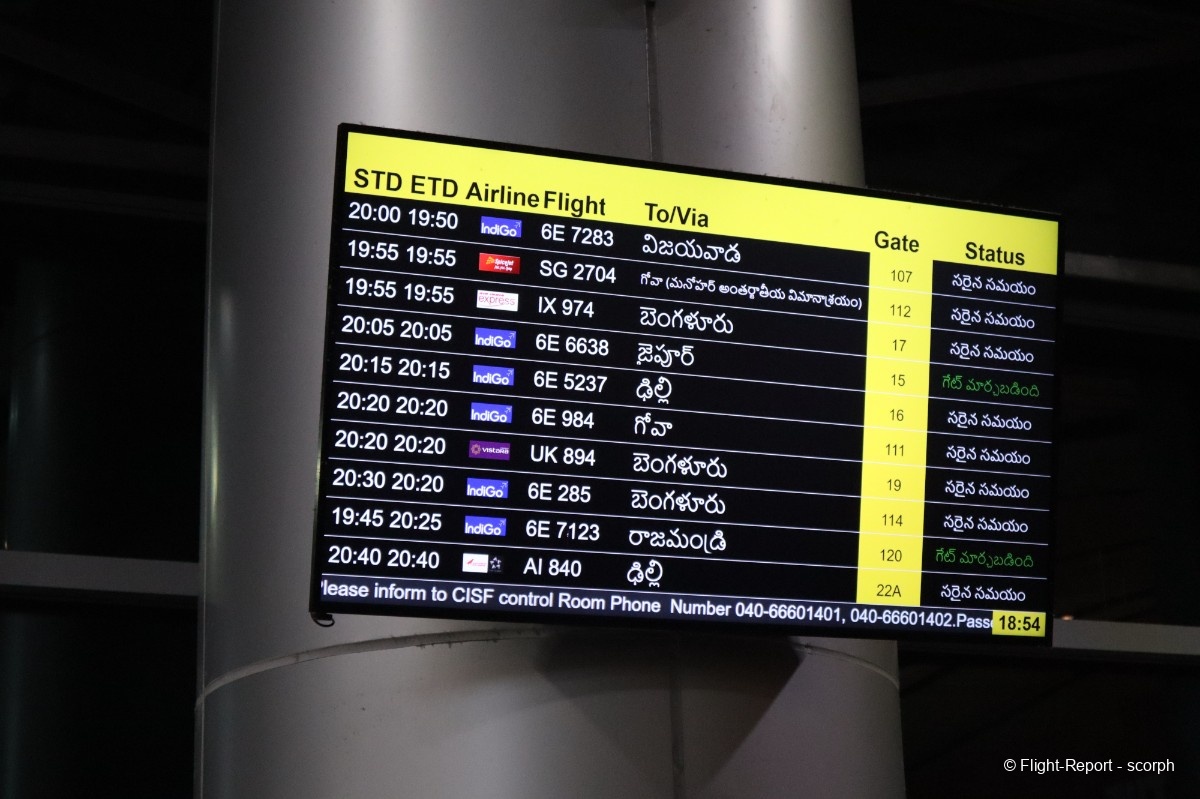
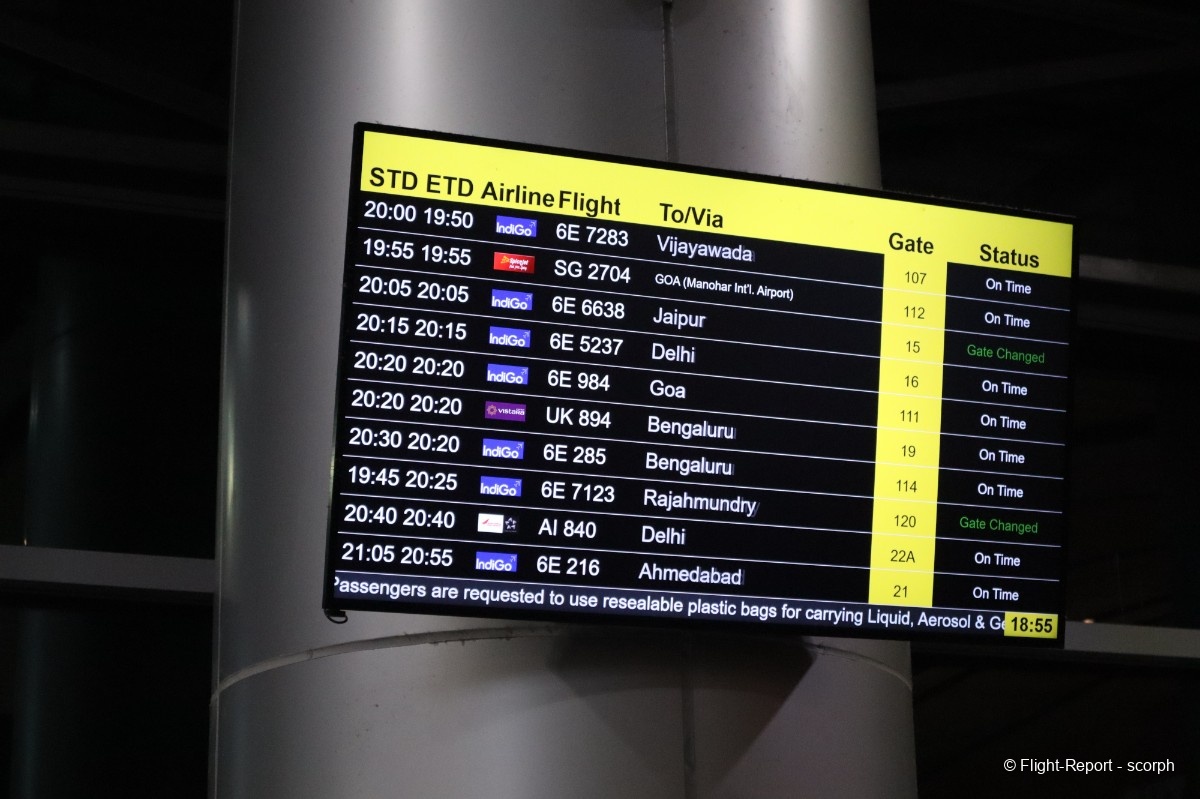
Then there's the new pier, which added about twenty new gates and opened just a few weeks ago.
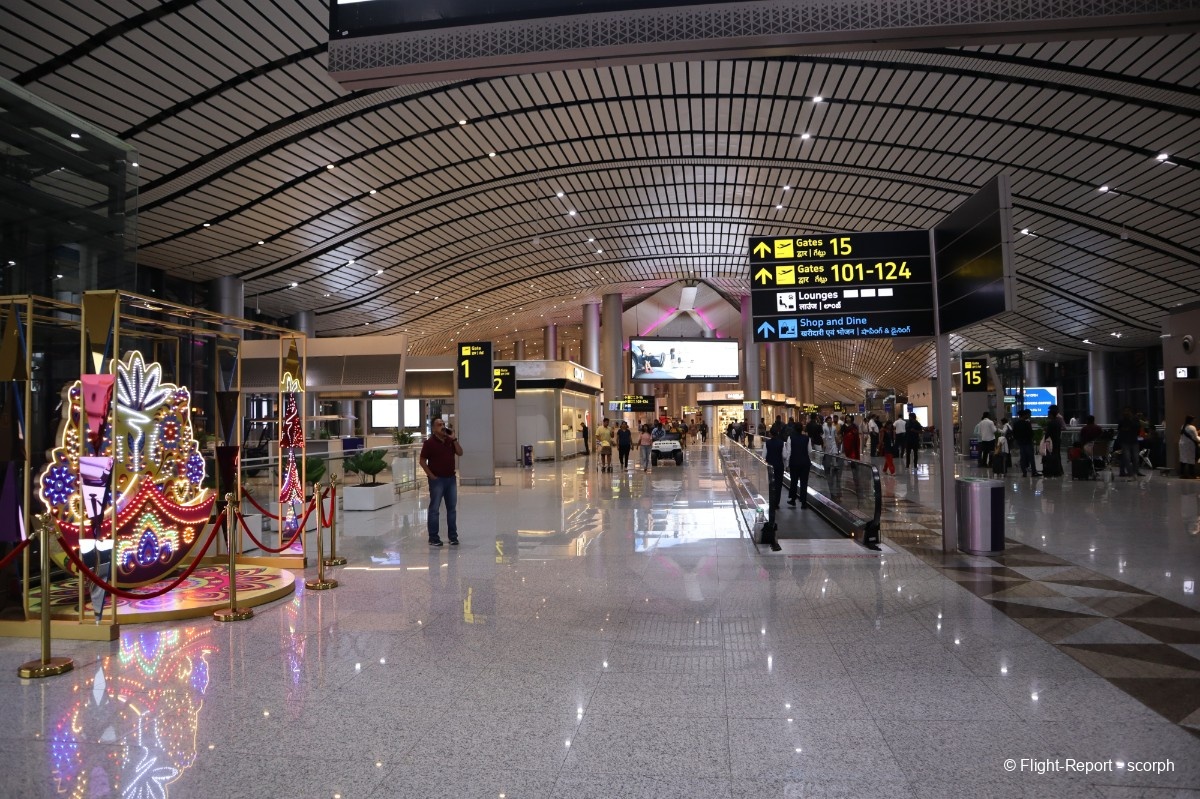
There’s a small architectural break, but the two sections blend quite well together. The newer area is more spacious, with some small patches of flowers and greens added for a nice touch. You can tell this part of the terminal has just opened, as almost all the shops are still under construction and being set up.
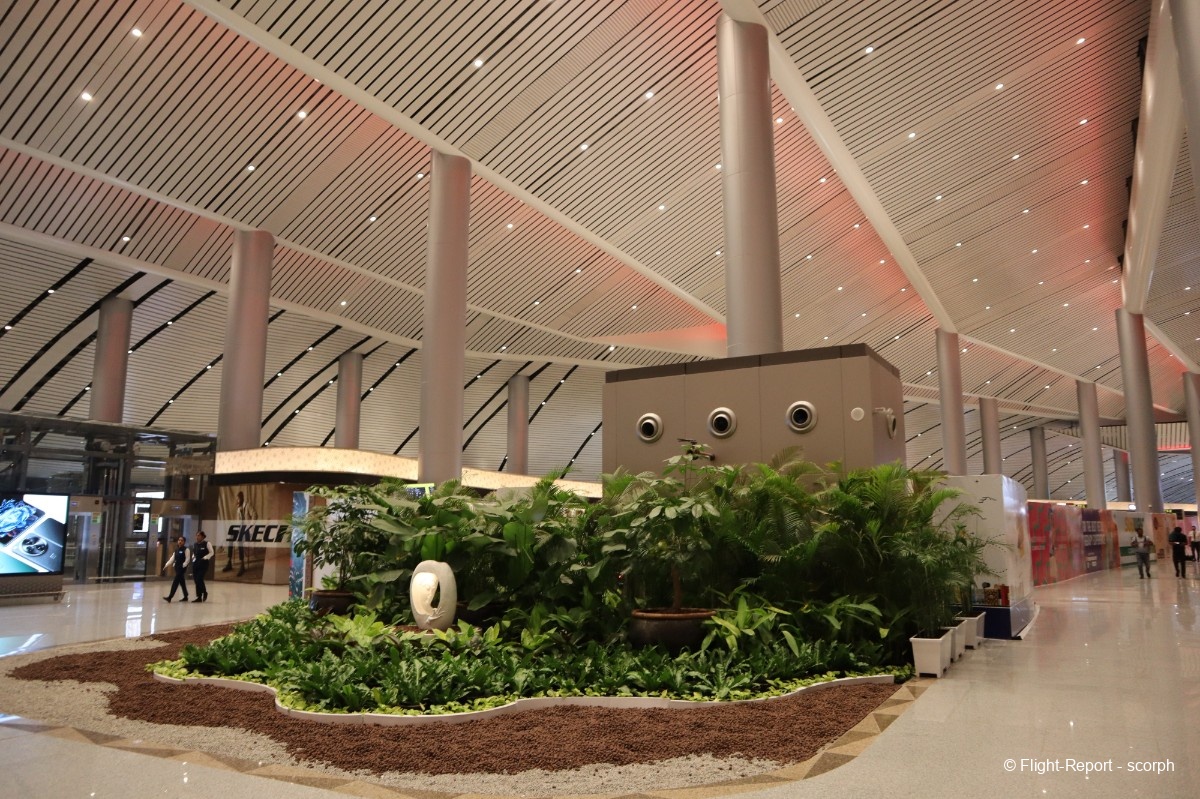

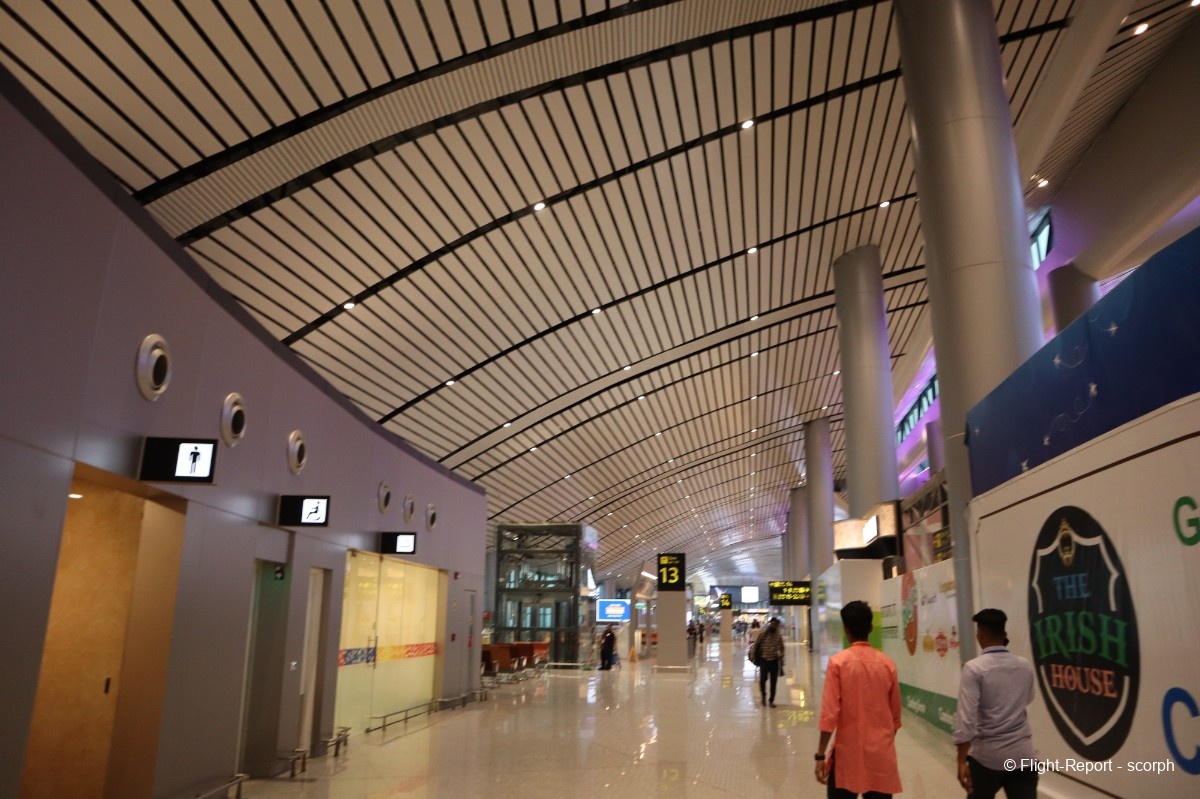
Most of these new gates are passenger bus gates located on the ground floor, and at this lower level, there are few shops, with primarily just a waiting area.
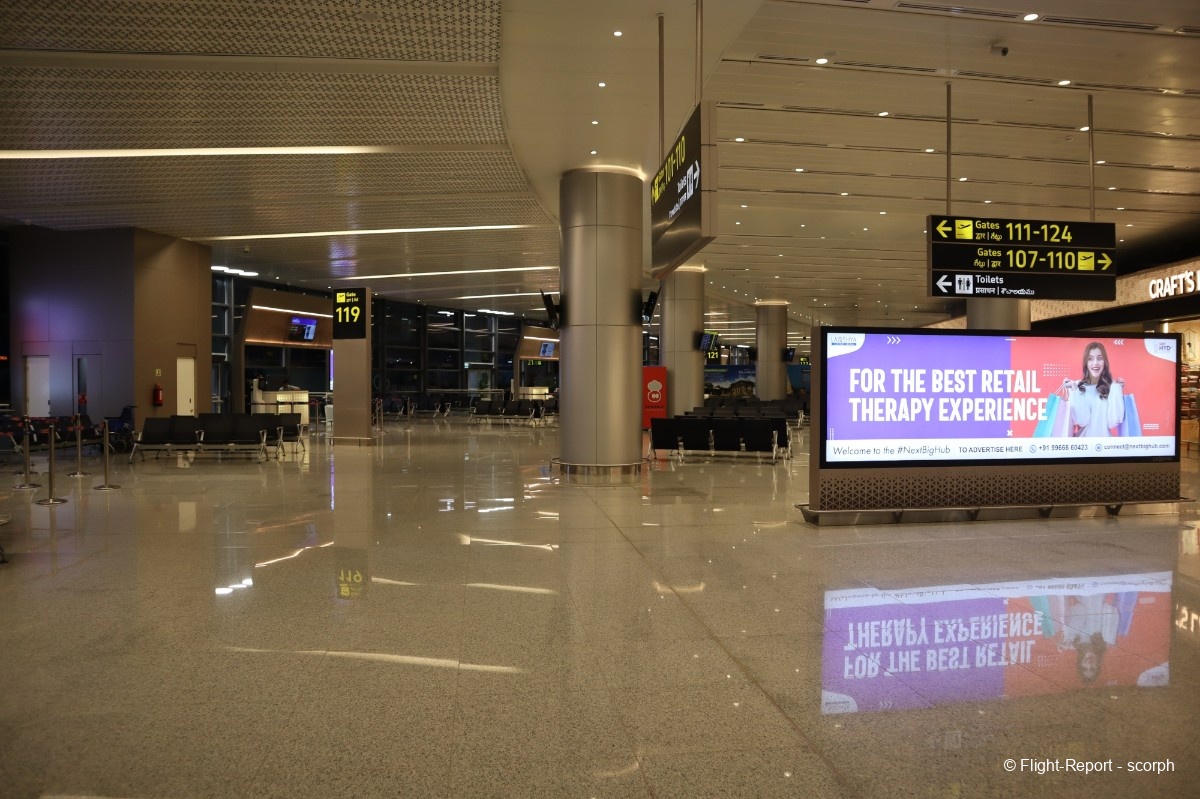
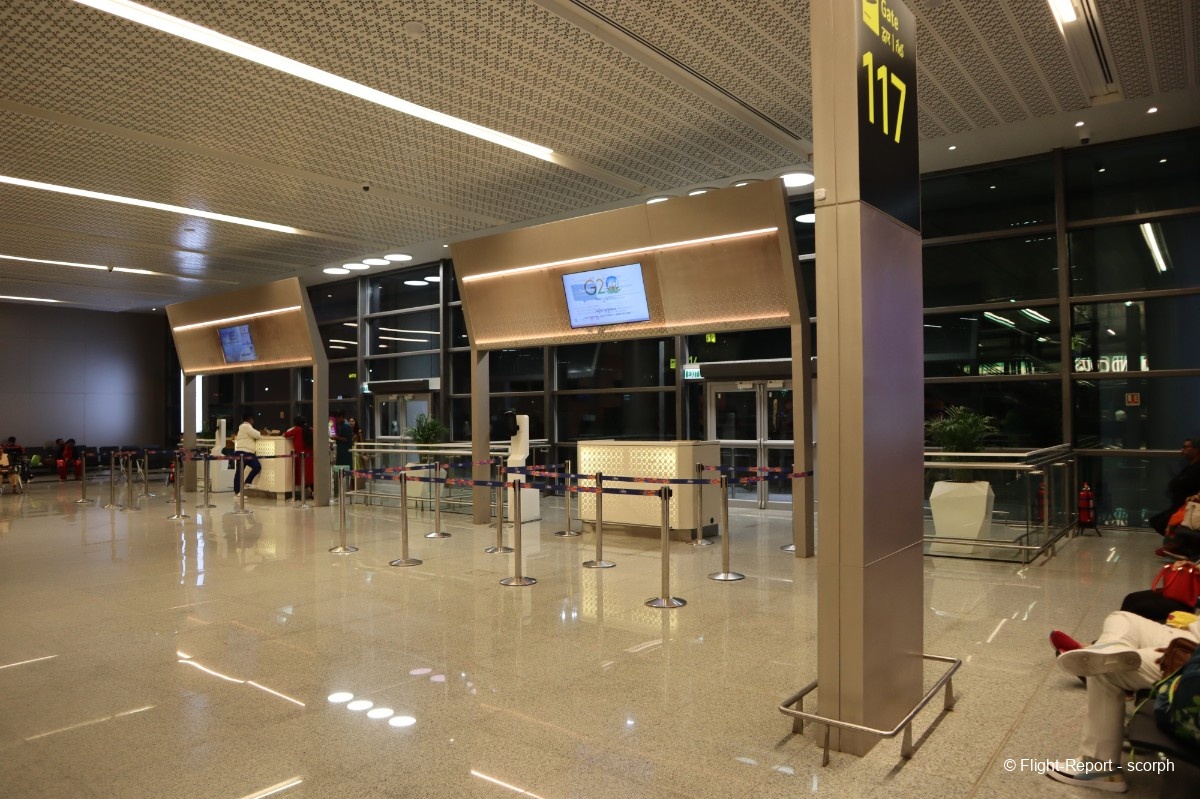
Our flight is already displayed at the gate with an estimated delay of an hour. Notably, the flight is listed for Pune (which is near Mumbai). In fact, Bangalore is just a stopover on this flight. It’s quite common in India to have multi-leg flights like this, where it’s "possible" to board or disembark along the way.
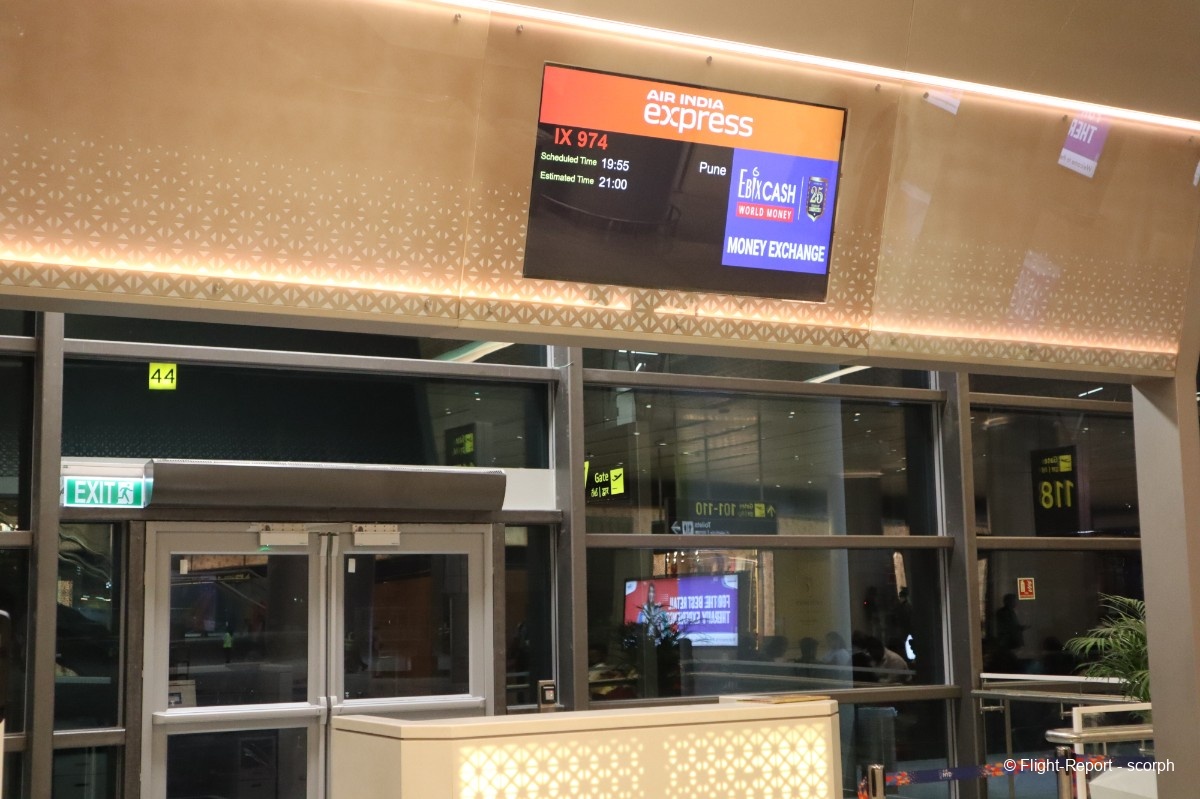
Boarding is called, and there's no rush at the gate. I'll board towards the end of the line, but I still manage to get on the first and only bus. After a short ride in the paxbus, we arrive at our Boeing for the evening.
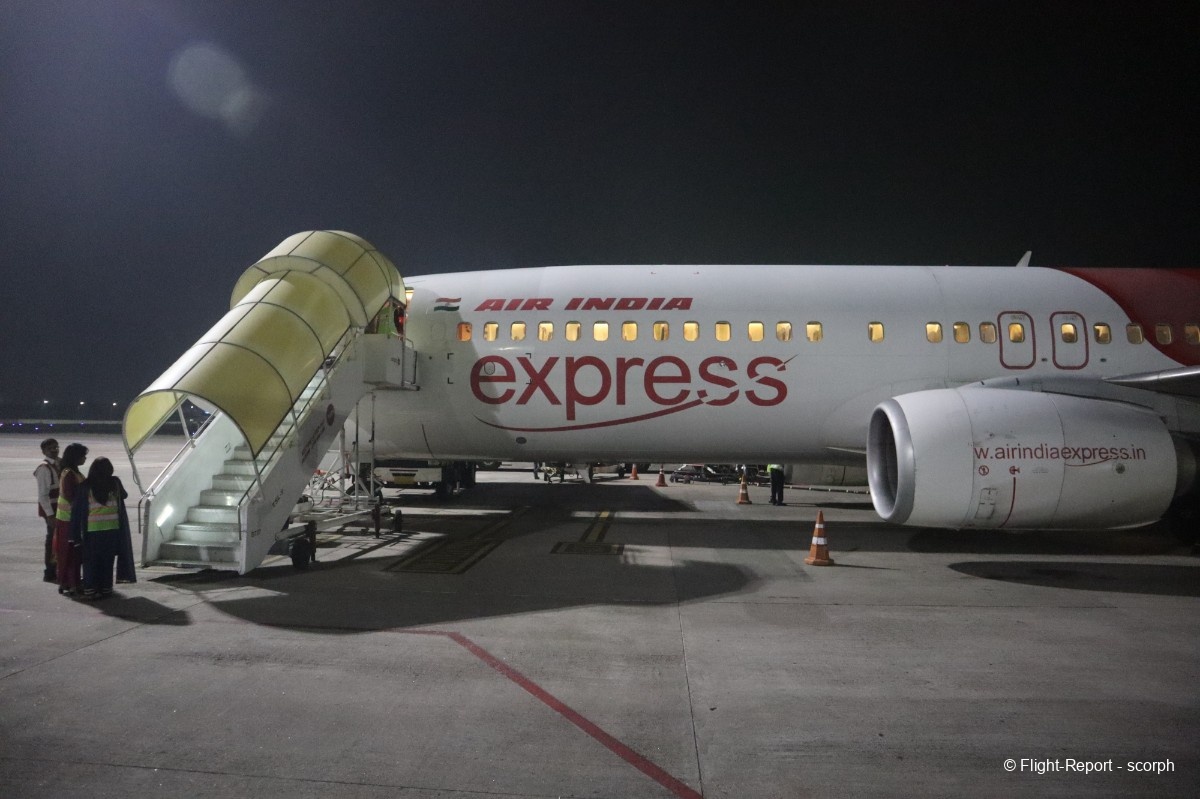
Given my seat number, it’s off to the rear door.
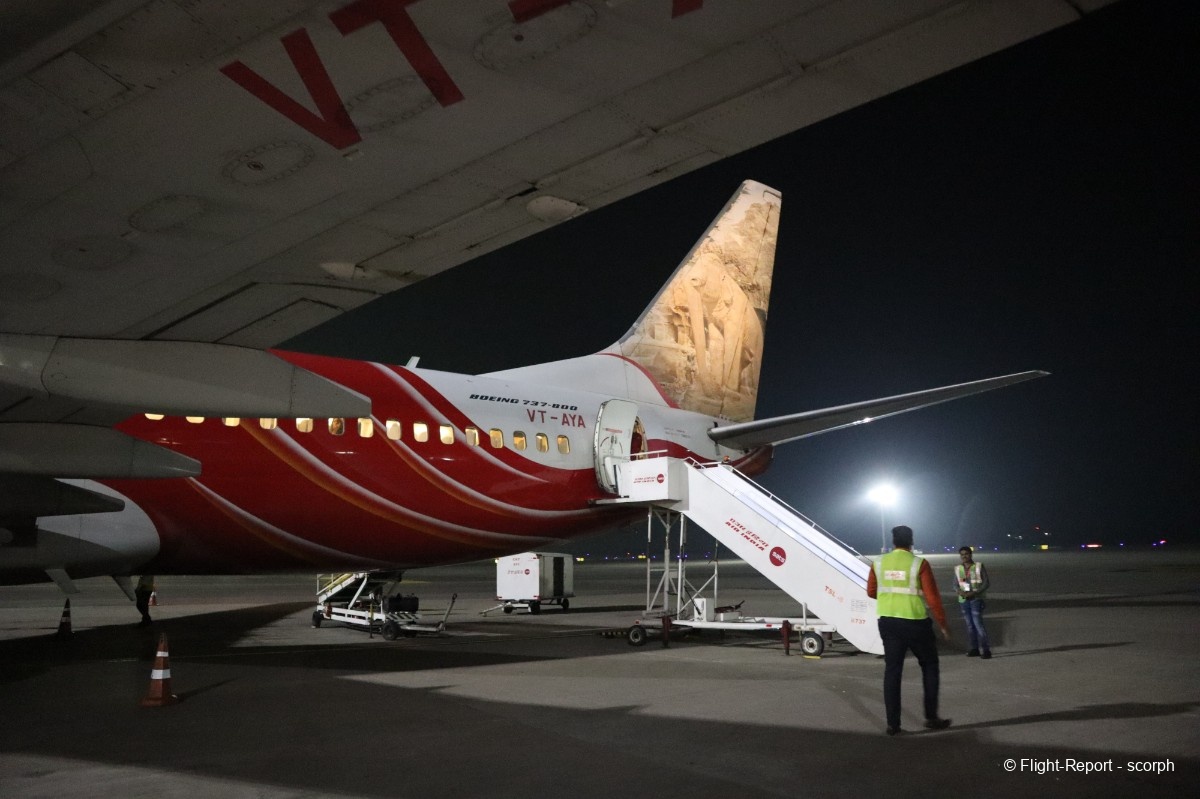
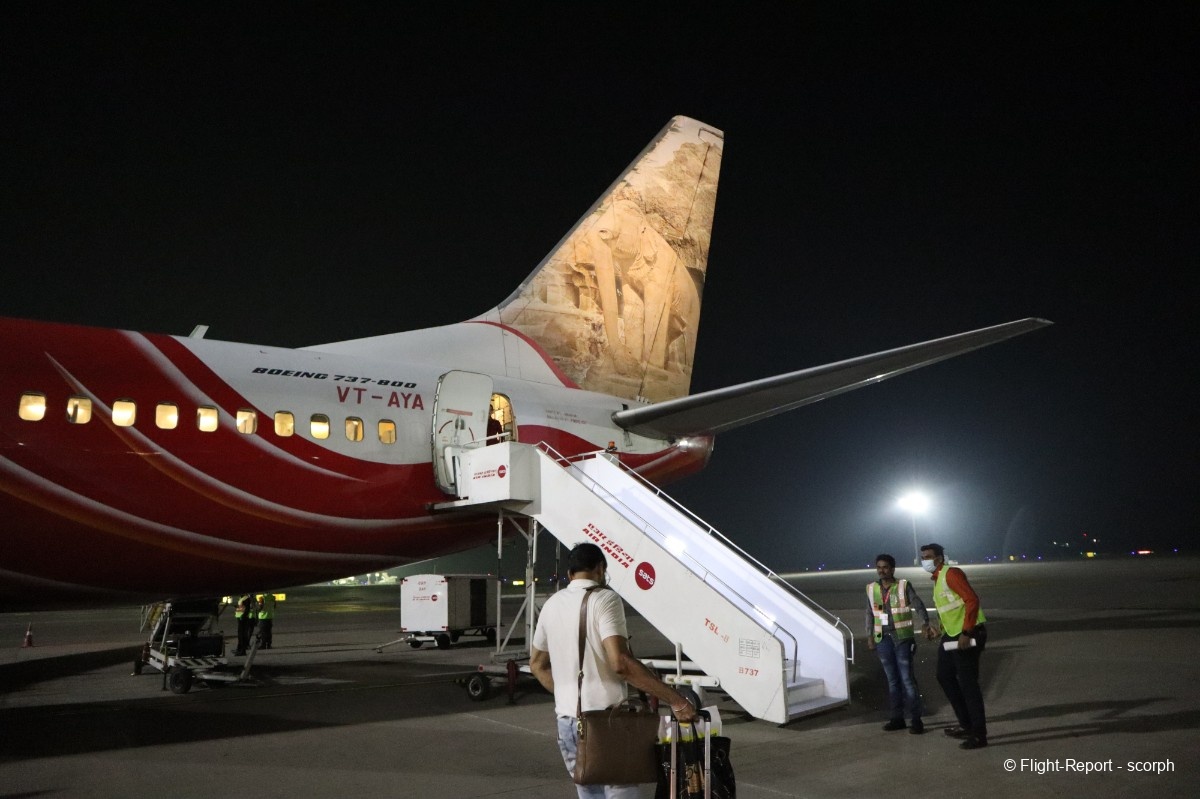
Fuselage shoot
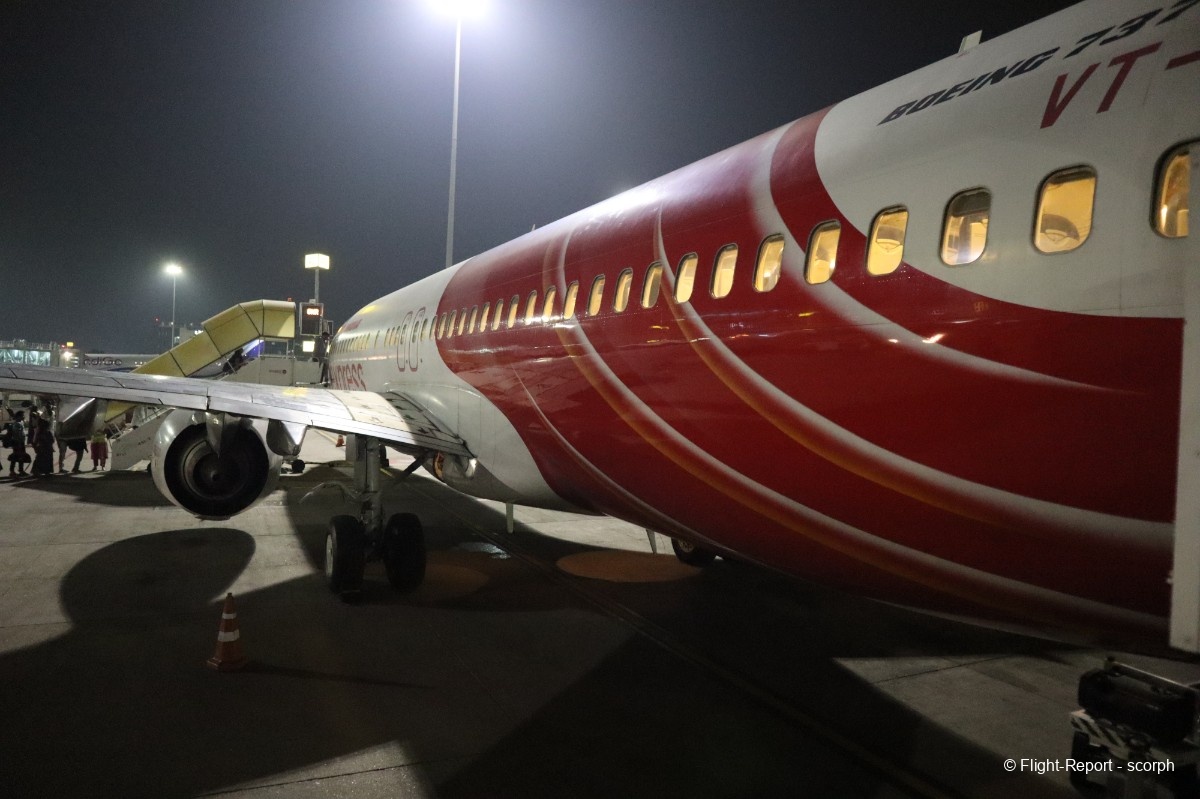
And a tailshot! I have to admit, I really like the concept of having different tail designs for each aircraft, though I like the Frontier livery with their animal-themed tails.

Aboard the Boeing 737-800 of Air India Express.
The welcome onboard from the young cabin crew at the gate is warm and enthusiastic… though the cabin itself is a bit less so. It feels like a step back in time with the old Boeing interiors, still in their original condition. The blue seats (why blue?) in the sky are as basic as they come, offering only a very slight recline. There are no power outlets or other accessories—just the bare minimum of comfort. These aircraft were primarily deployed for flights to the Persian Gulf countries, with an average duration of around 5 hours, so it’s clear the focus is on functionality rather than luxury.
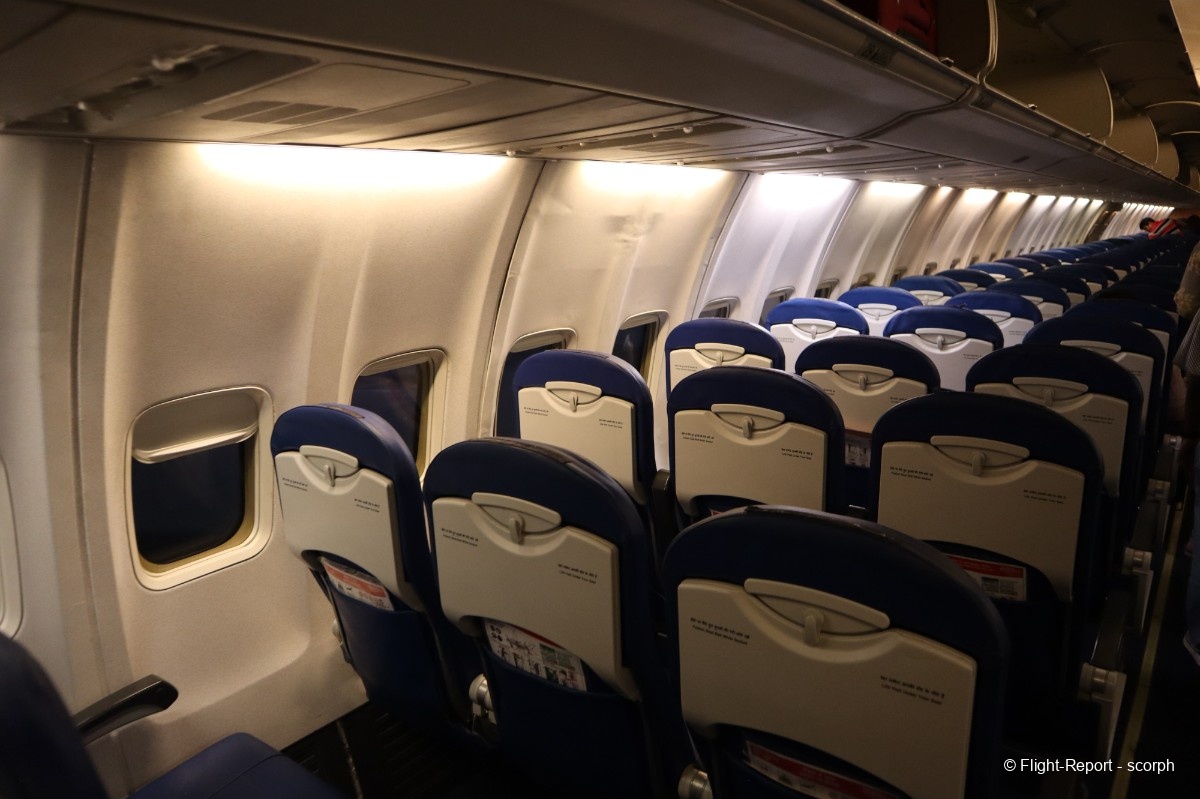
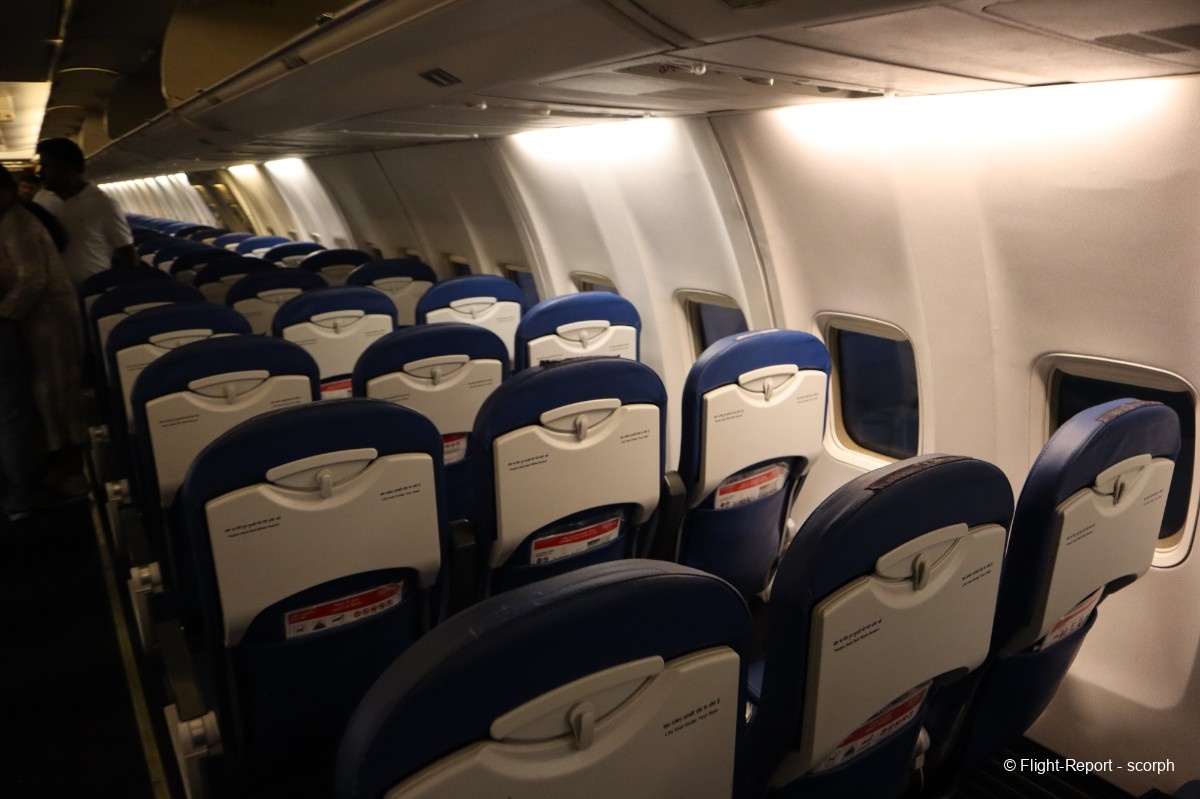
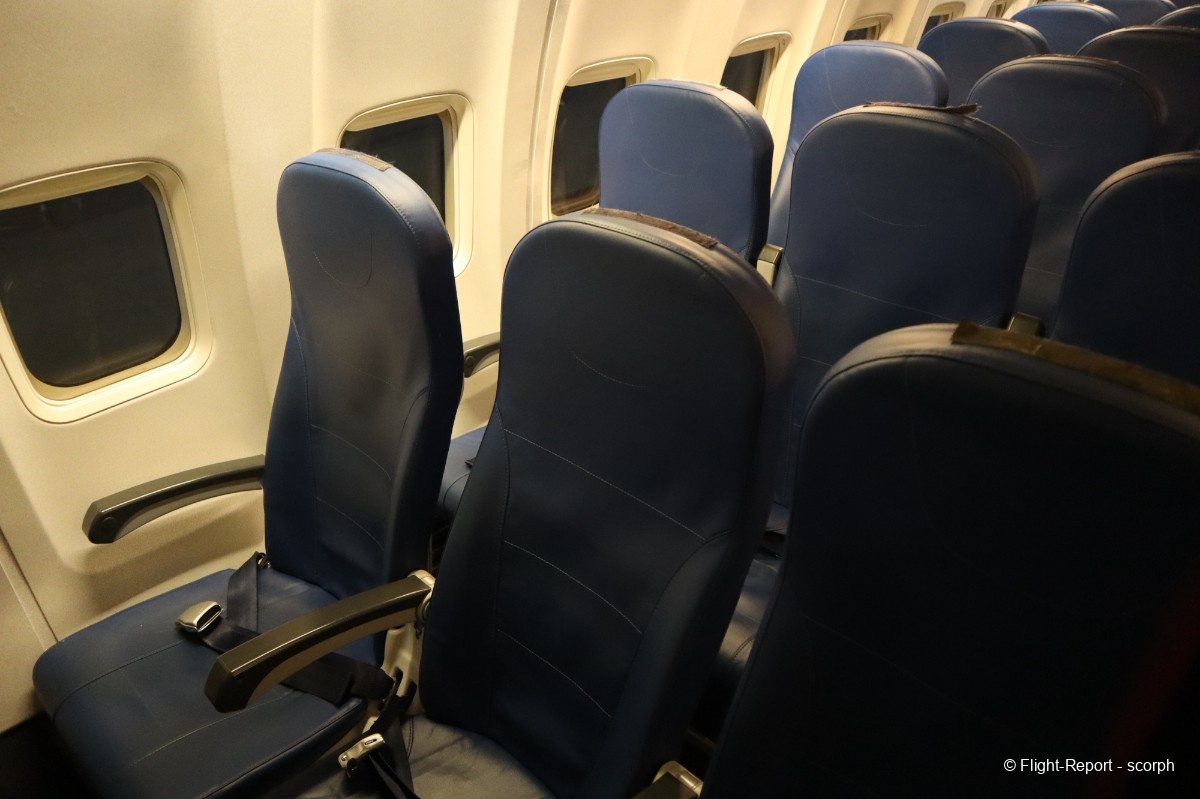
The rectangular windows, typical of the older 737 cabins, are a reminder of the aircraft’s age. I’ve definitely seen cleaner windows… Overall, the cabin isn’t in the best shape.
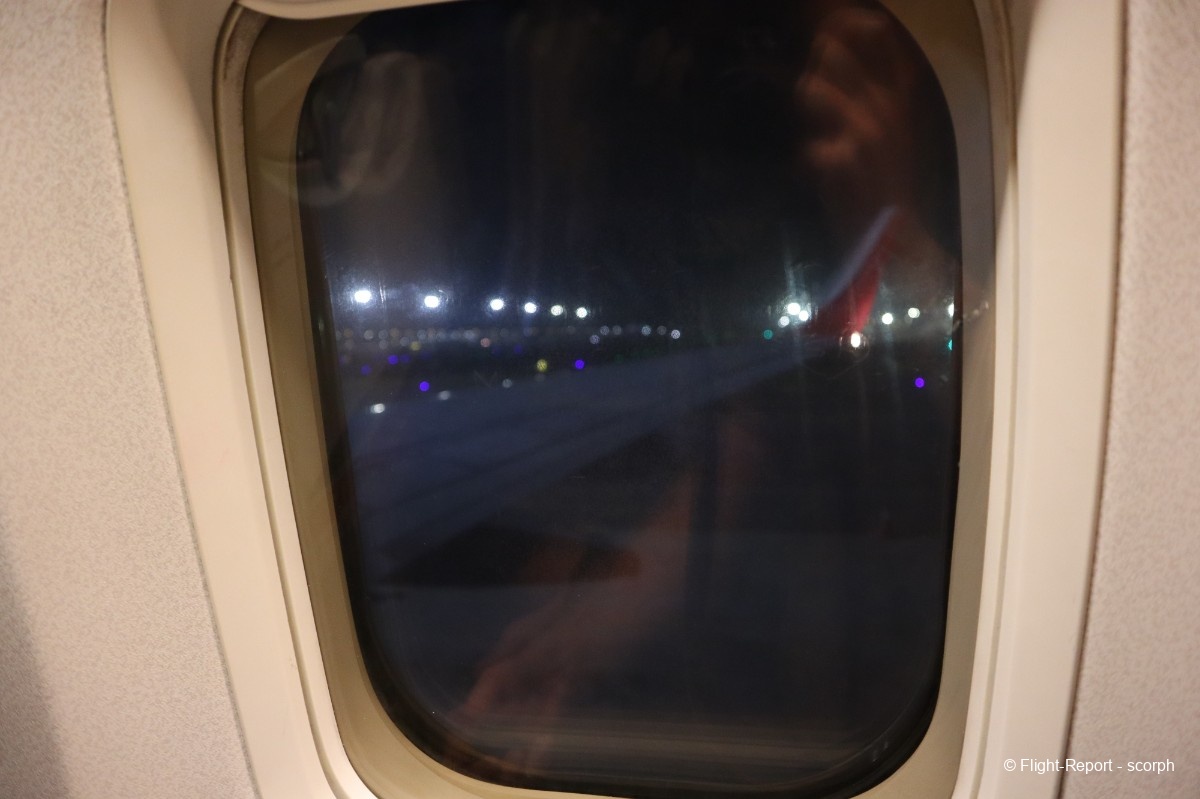
Boarding will be completed in about ten minutes, especially since there are only around thirty passengers filling the plane on this Diwali evening.
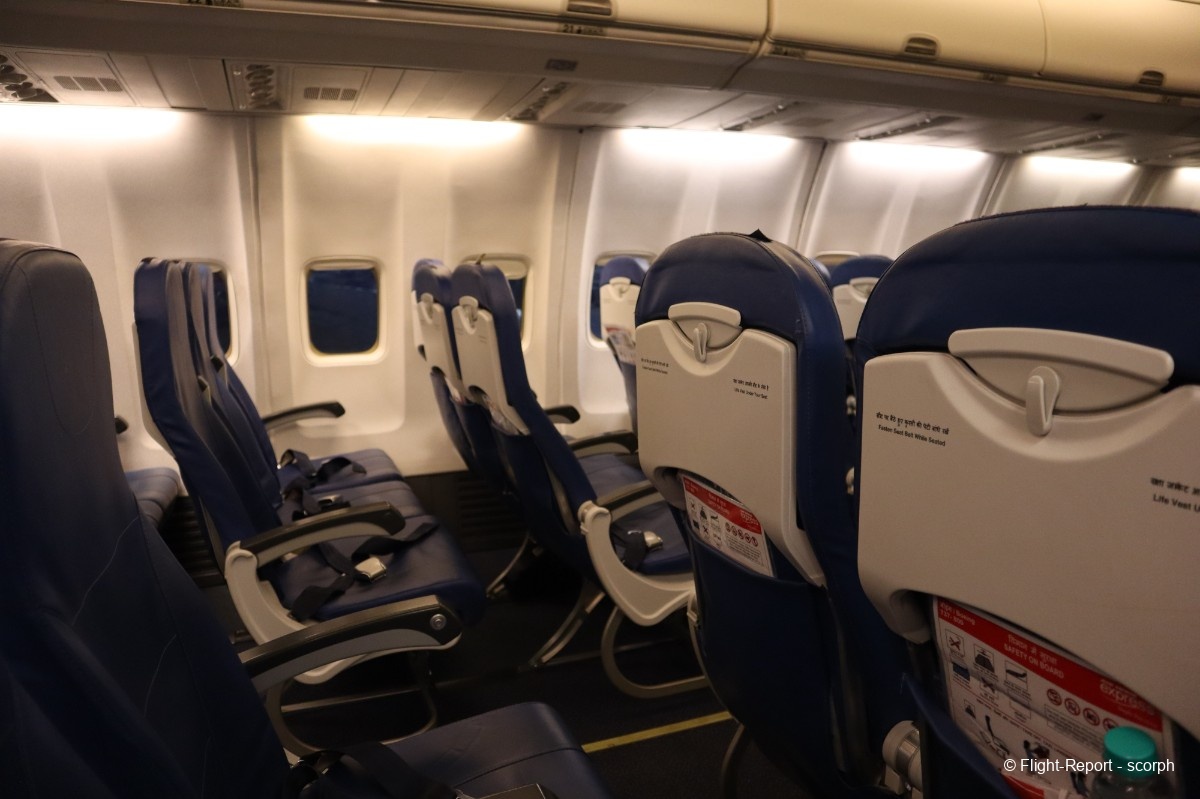
The seat map as displayed by aerolopa website

The proof is in the fact that I’m not too bothered by my neighbors, which will earn a few extra points for comfort. However, it seems the cleaning wasn’t done today, as I find a life jacket under my seat, even though the seat is already equipped with one.
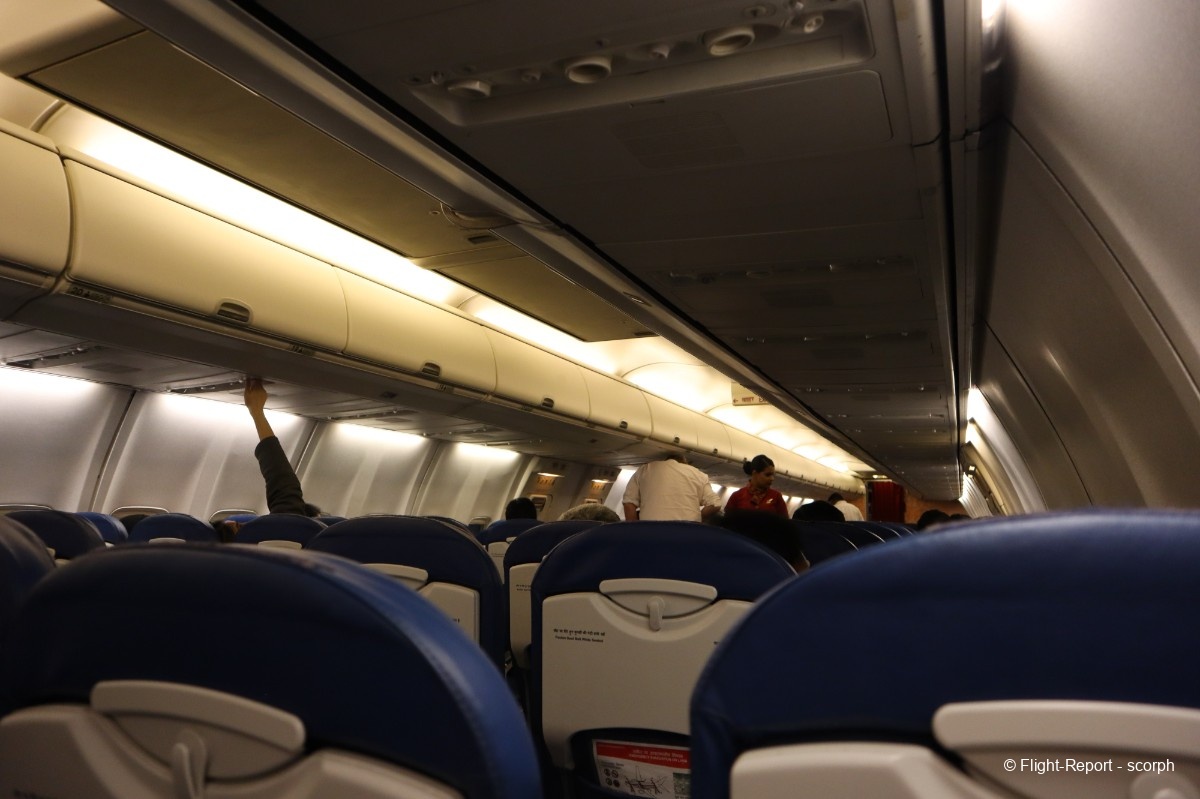
The crew will pass through the aisles handing out small bottles of water for free.
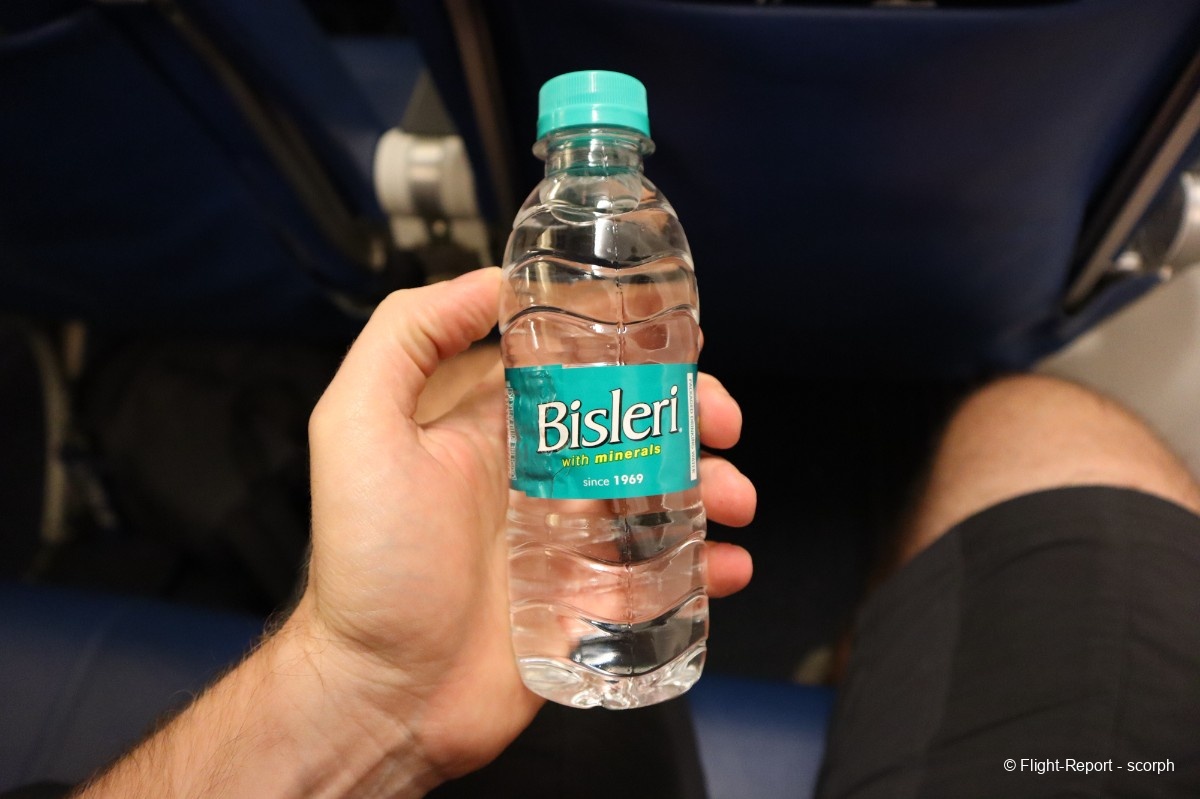
The doors are closed and the safety demonstration are displayed by the crew "manually." Shortly afterward, we are starting the push back.
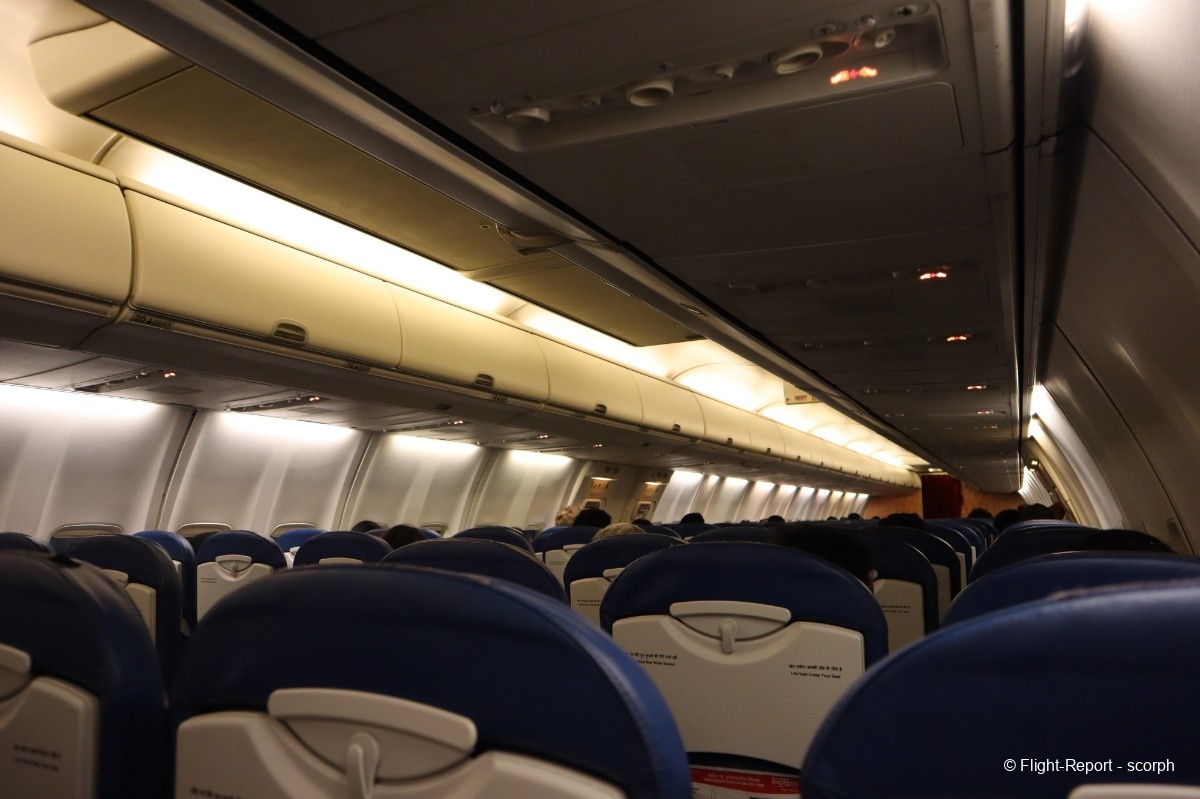
We begin taxiing toward runway 09, passing along the terminal where we get a glimpse of the variety of traffic, including Indian airlines such as Akasa, Air India Express, and Vistara, as well as Emirates with a Boeing 777.
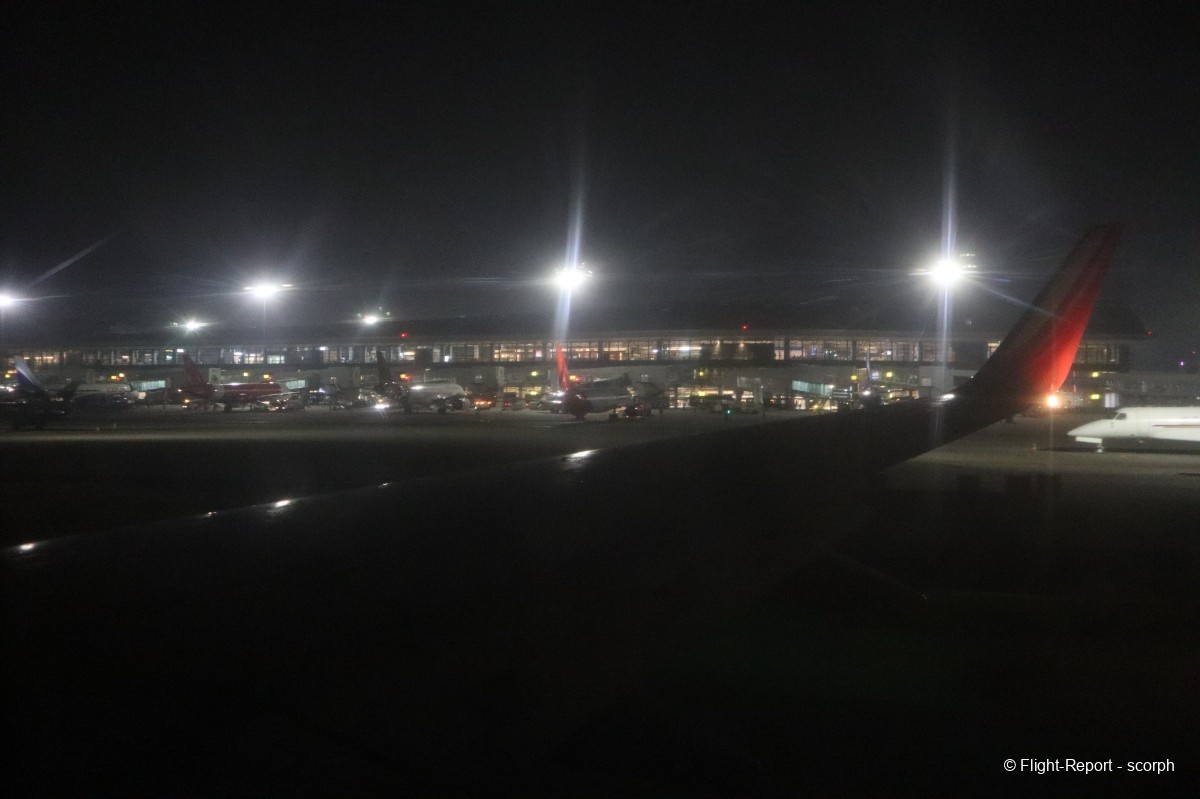
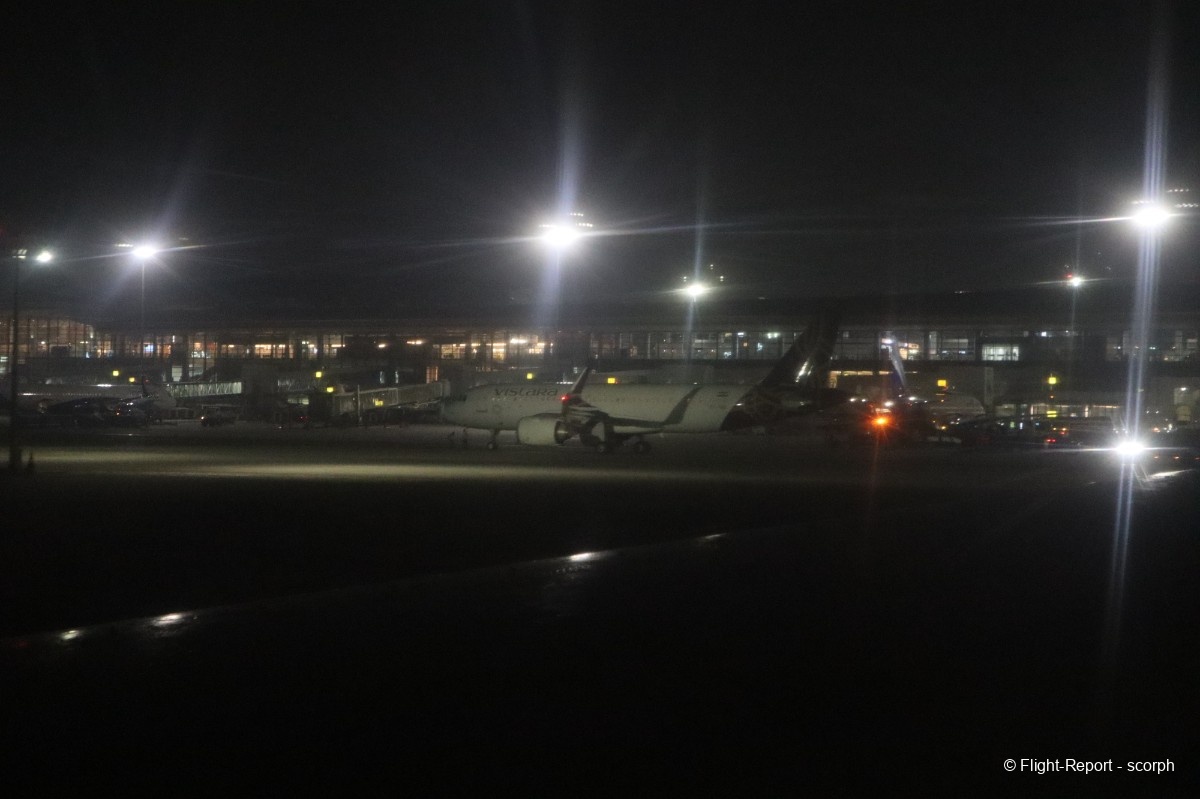
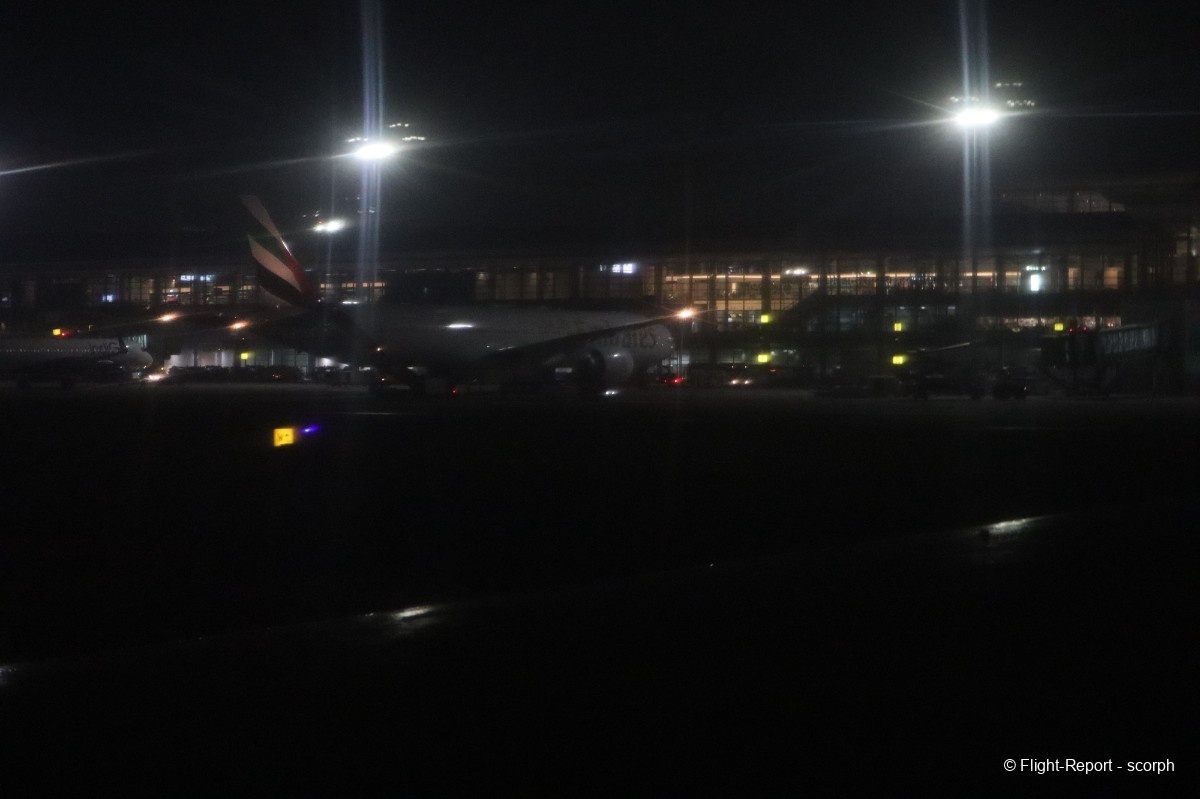
Passing close to the airport control tower.
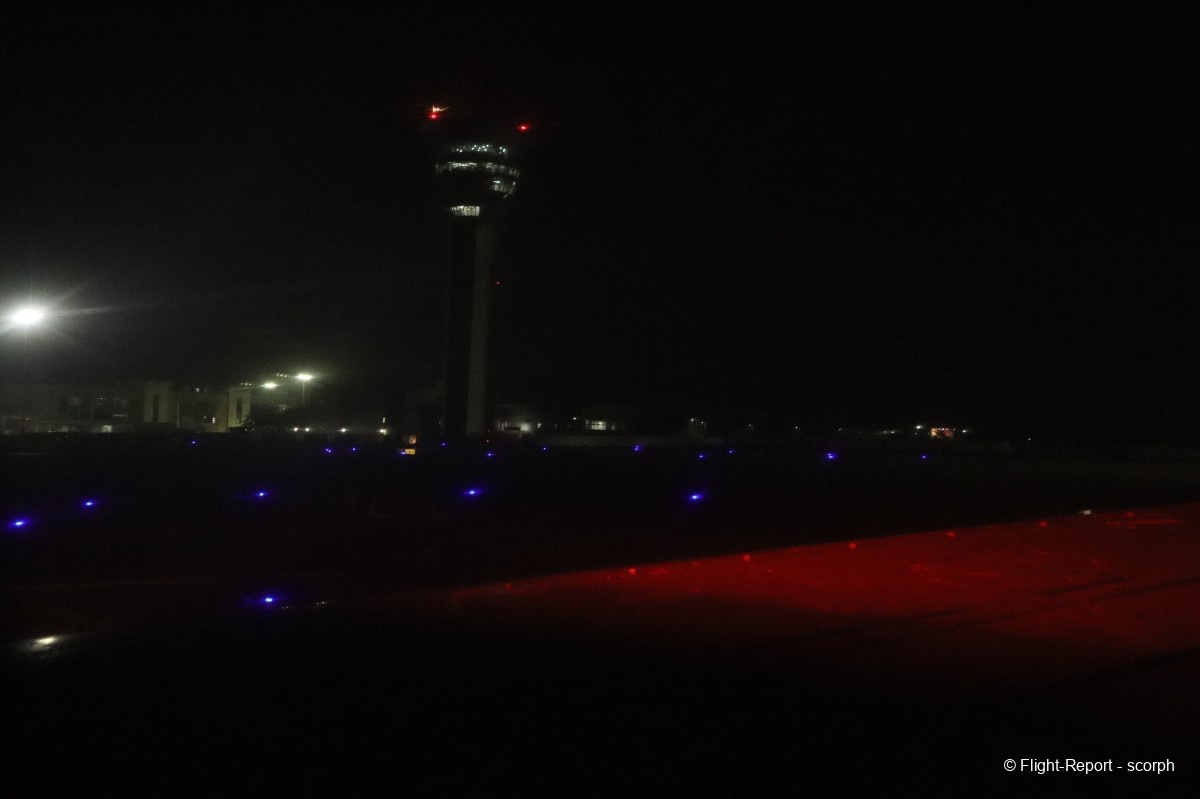
Before entering the runway, the only strip of illuminated asphalt in the middle of the dark night.
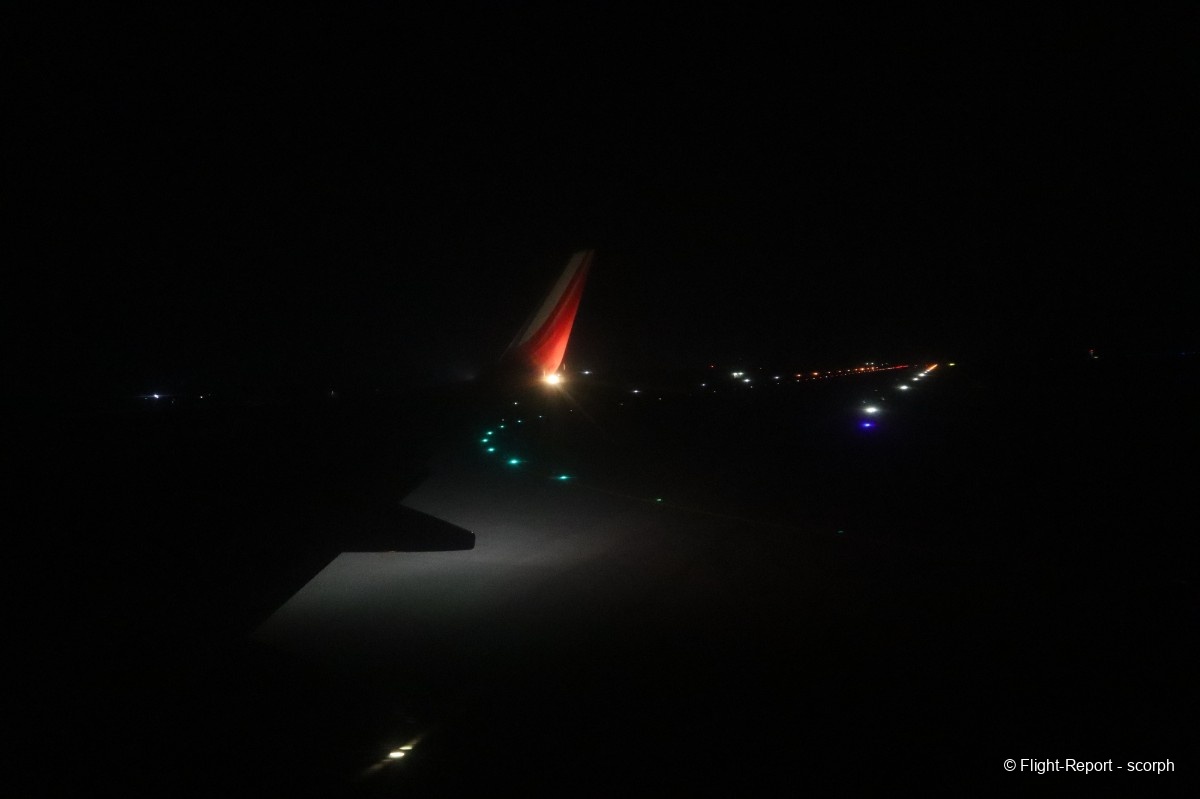
We take off without delay over the lights of Hyderabad's suburbs, which we quickly leave behind as we head south toward Karnataka.
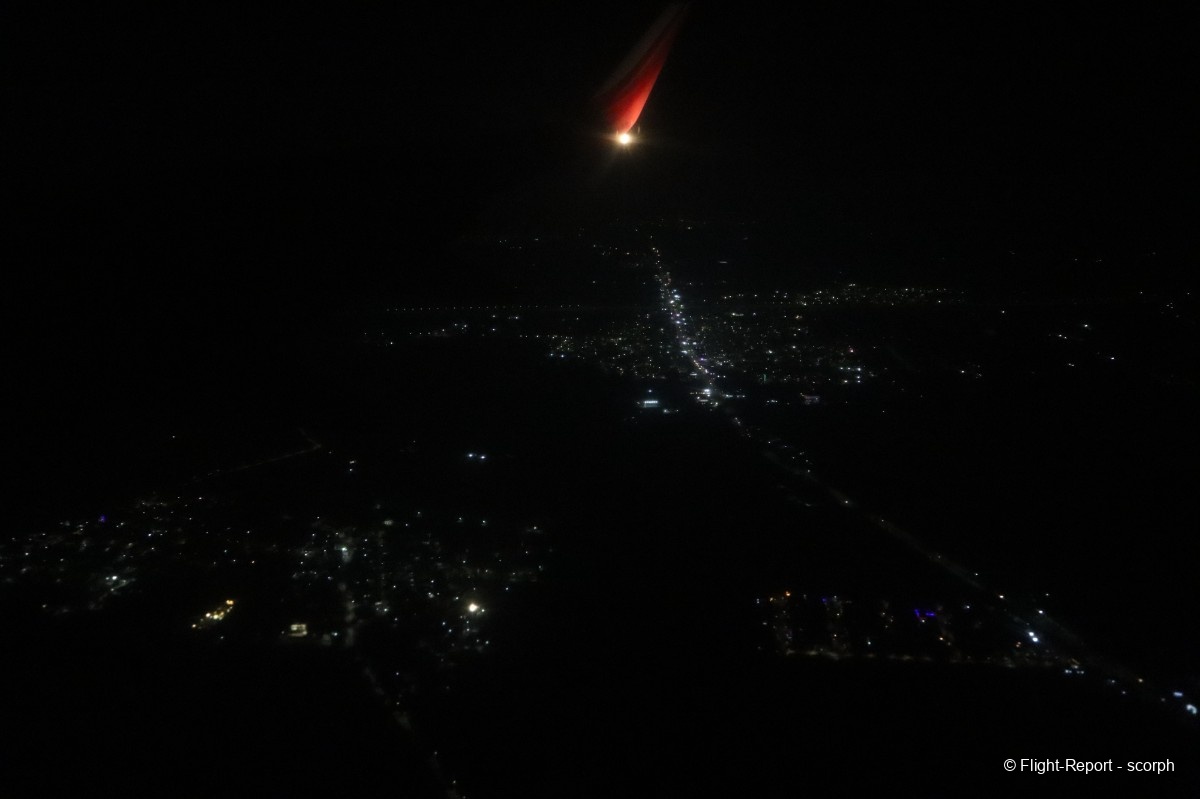
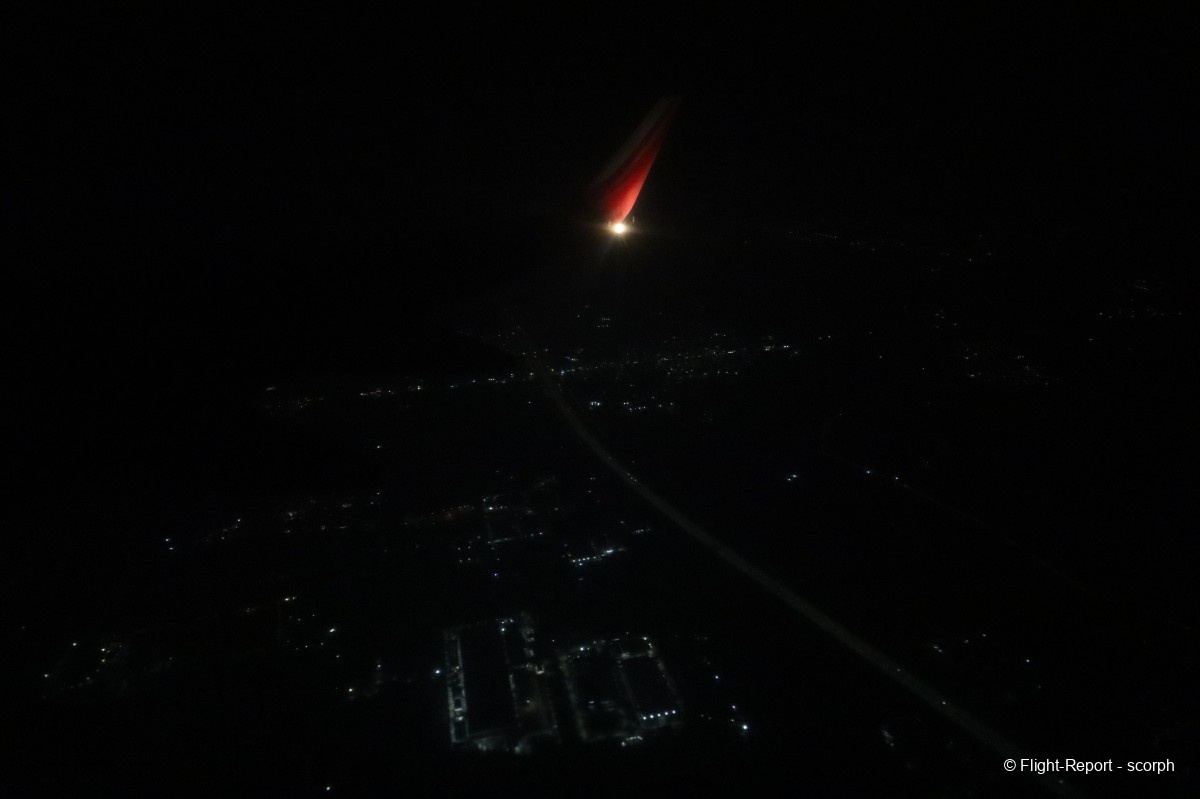
The seat pocket contains two items in addition to the standard safety card (which, by the way, is in poor condition). There's the buy-on-board (BoB) menu, which also includes some information about the airline. There's also a small brochure informing us about the rollout of a Wi-Fi entertainment system, which I must admit I didn’t try out.
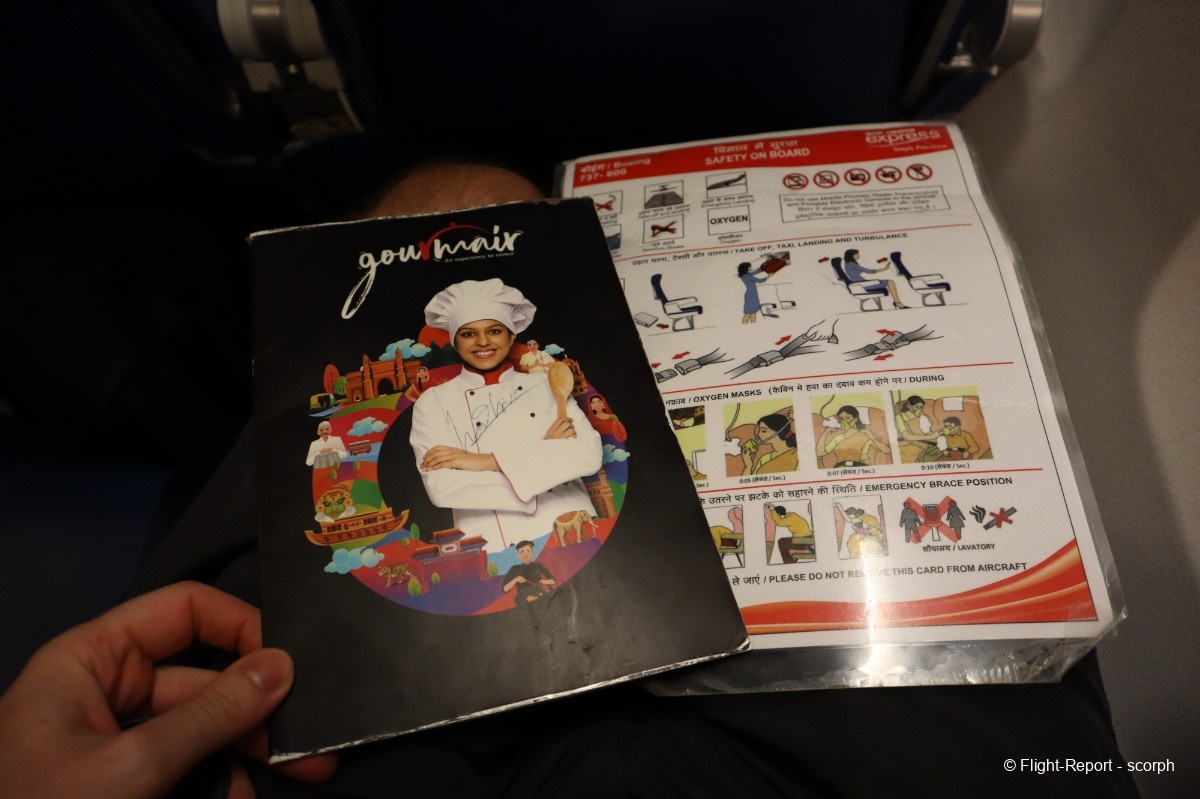
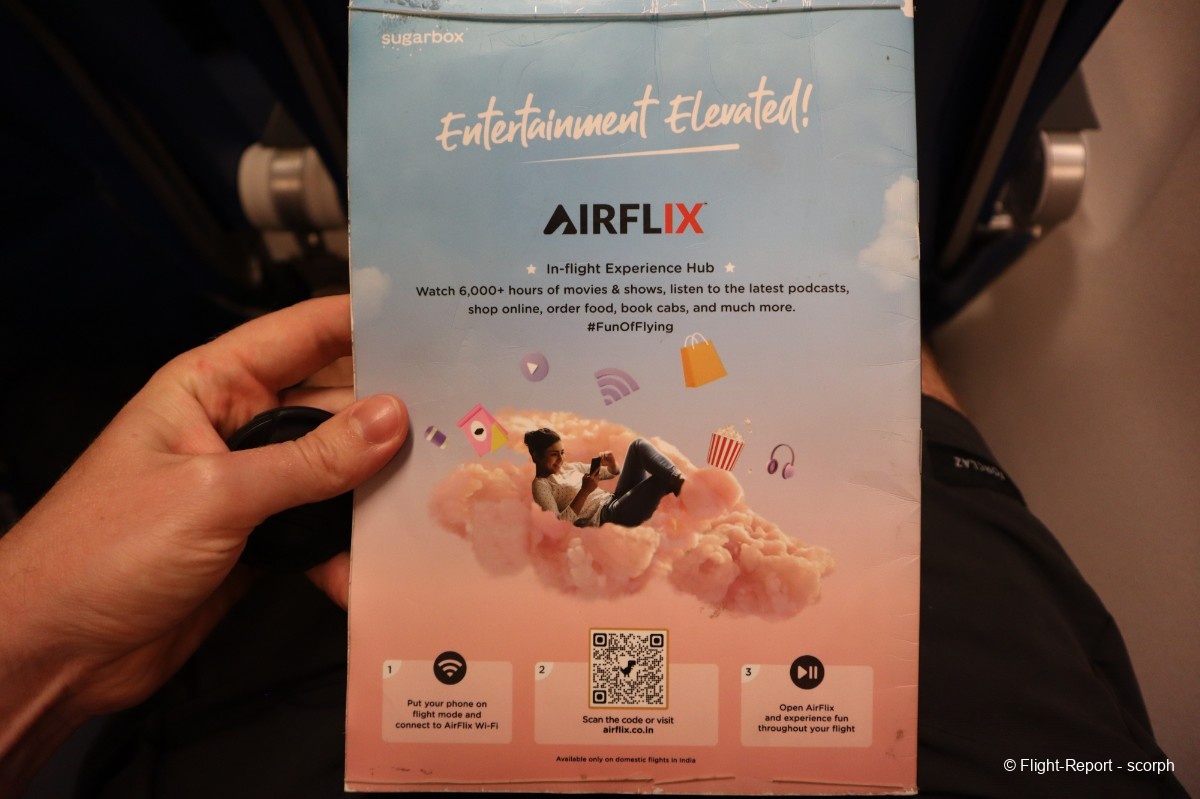
Here’s the inside of the brochure that in addition to the buy-on-board (BoB) menu, featuring a route map of Air India Express network. It clearly highlights the historical core of Air India’s low-cost market, with flights from all corners of India to Arabian Gulf countries. However, since end of 2023 and the beginning of the merger with AirAsia India, the domestic market has been expanding rapidly. The group’s low-cost carrier has added 45 Boeing 737 MAX 8 aircraft to its fleet to aggressively compete with IndiGo and the now-defunct GoAir.
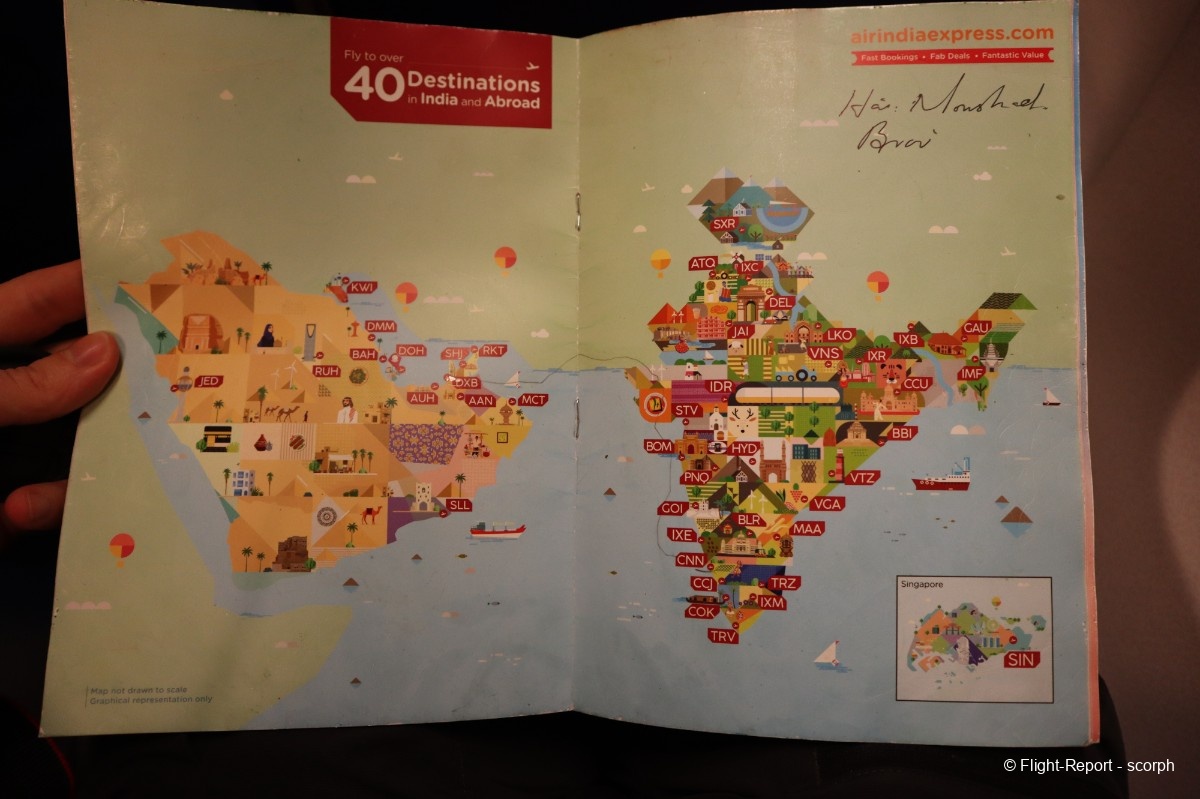
The catering offer is quite affordable, especially for drinks (100 INR = approx. €1.20). Hot meals, however, appear to be available only through online pre-order. For reference, 550 INR is about €6.50, and that price includes a drink and a dessert. On the right-hand page, there’s an overview of the Air India Express loyalty program, which seems relatively appealing.
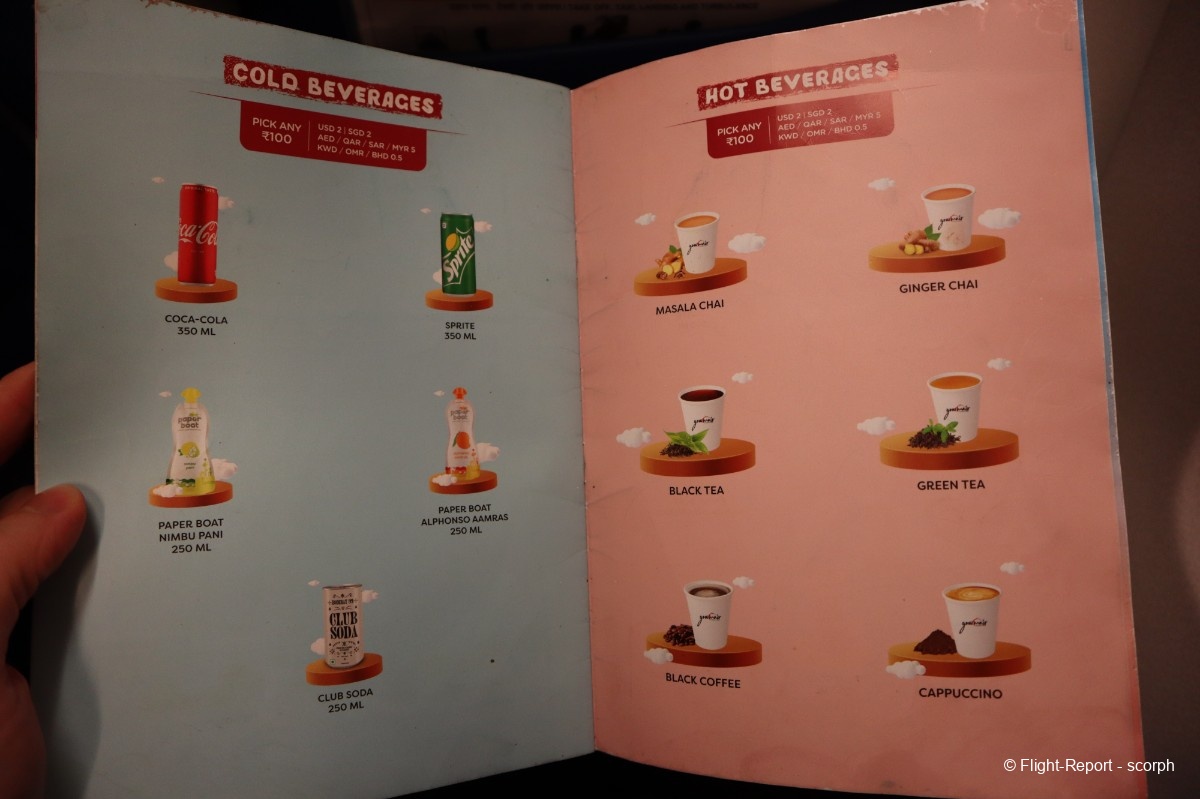
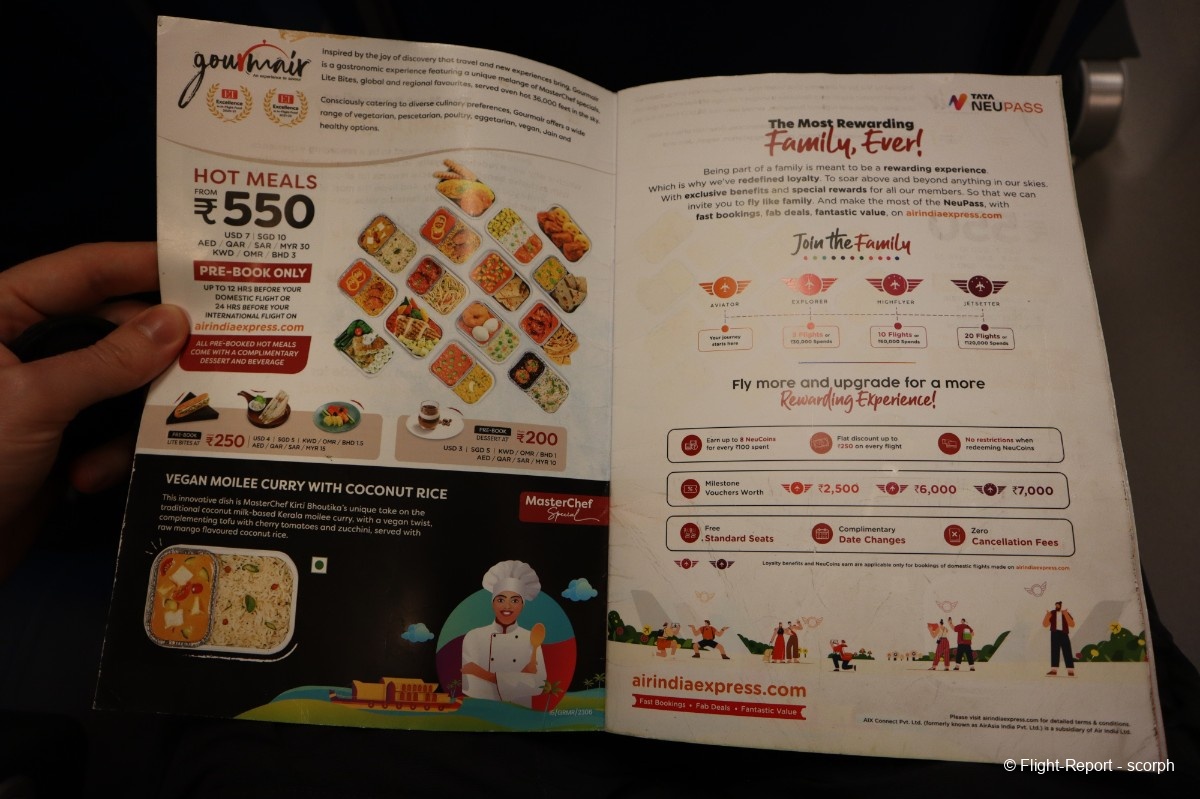
On my side I chose to add €4 to my flight for a seat selection plus an onboard snack (I went with the fresh fruit option). Everything was served in this cardboard box and came with a cup of apple juice. The fruit was actually quite good—especially the pineapple. Of course, at that price point, the cutlery was made of cardboard. :)
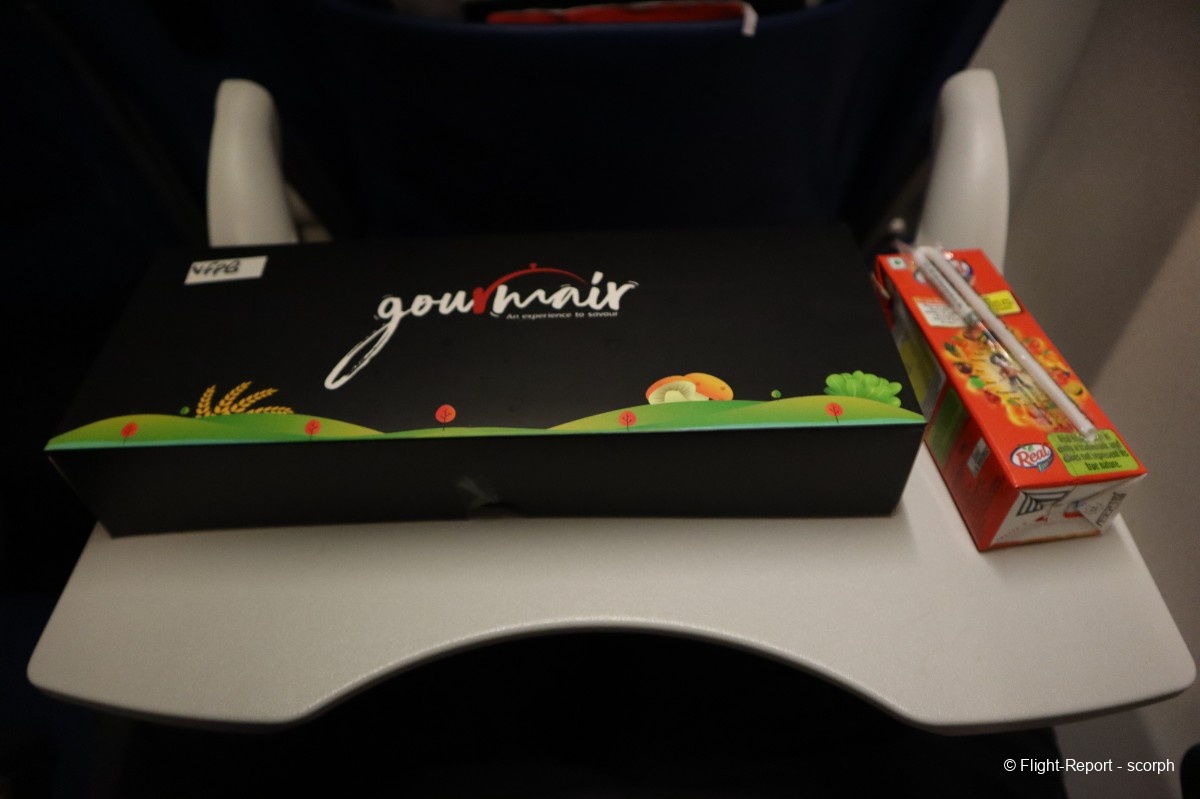
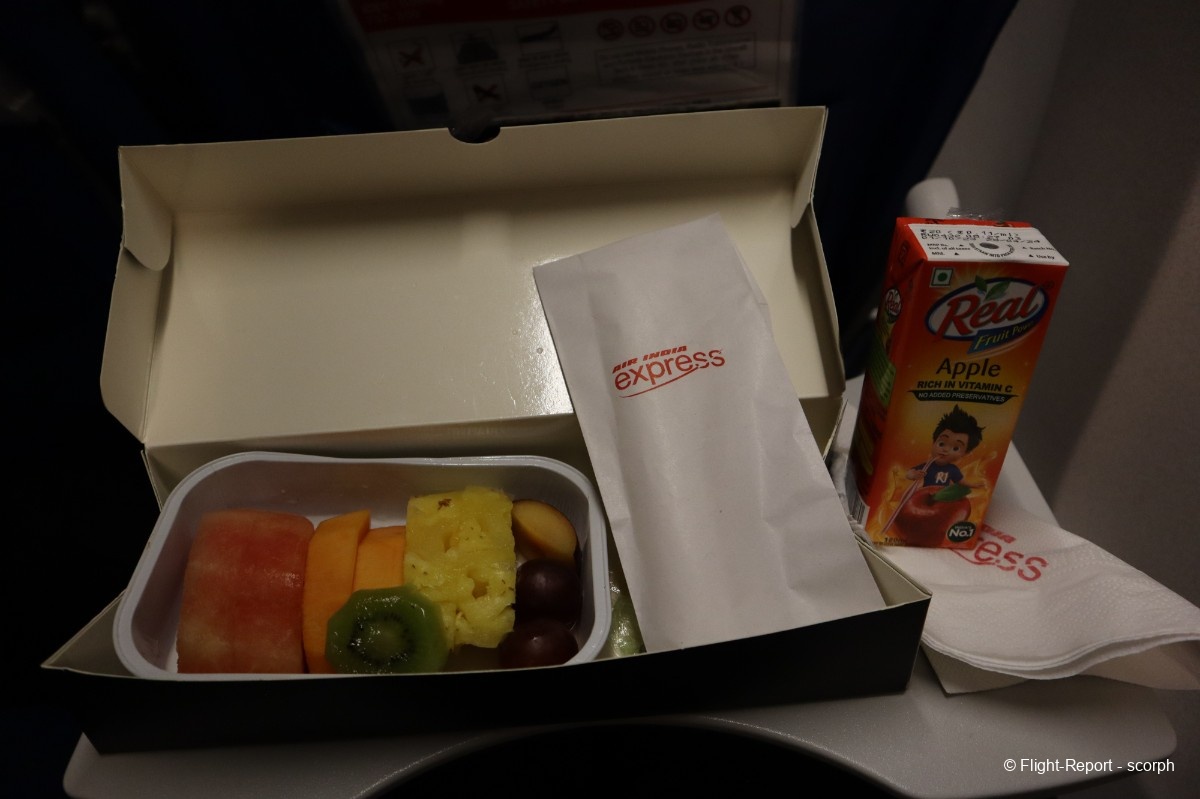
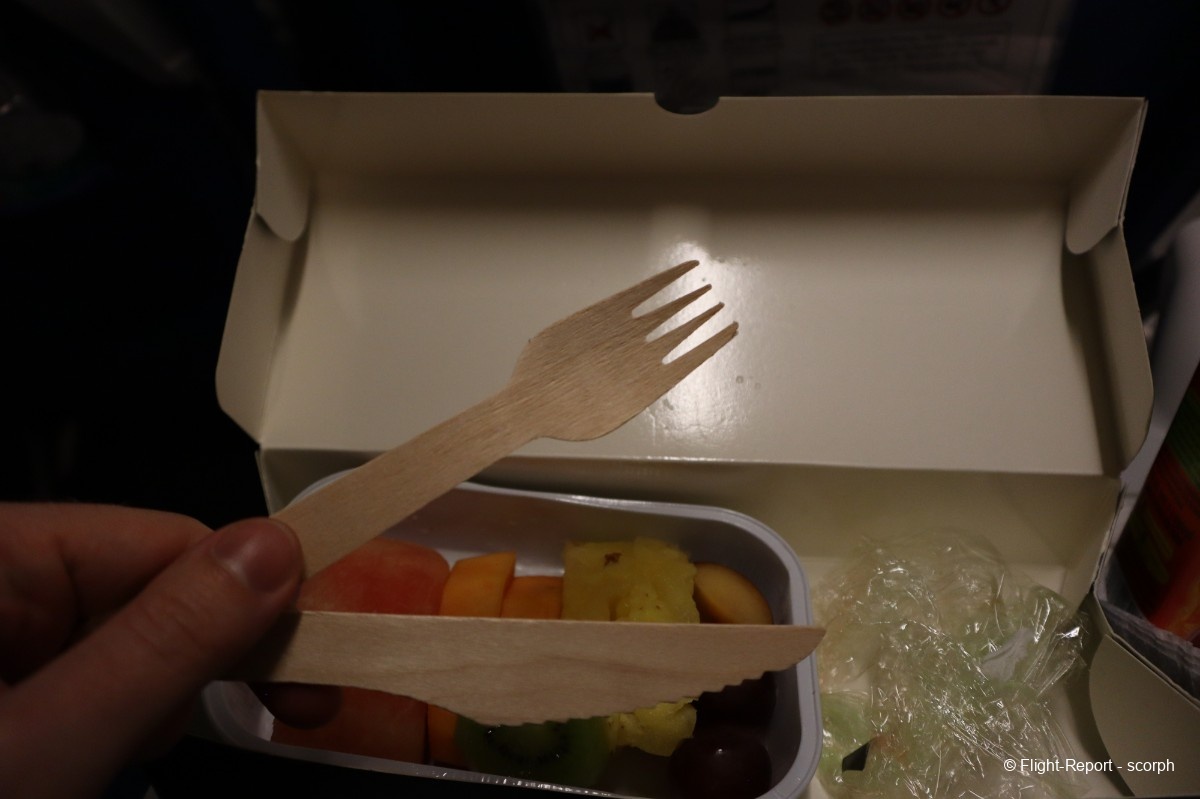
The route taken by our flight today reached a cruising altitude of 29,000 feet for this short journey of less than an hour.
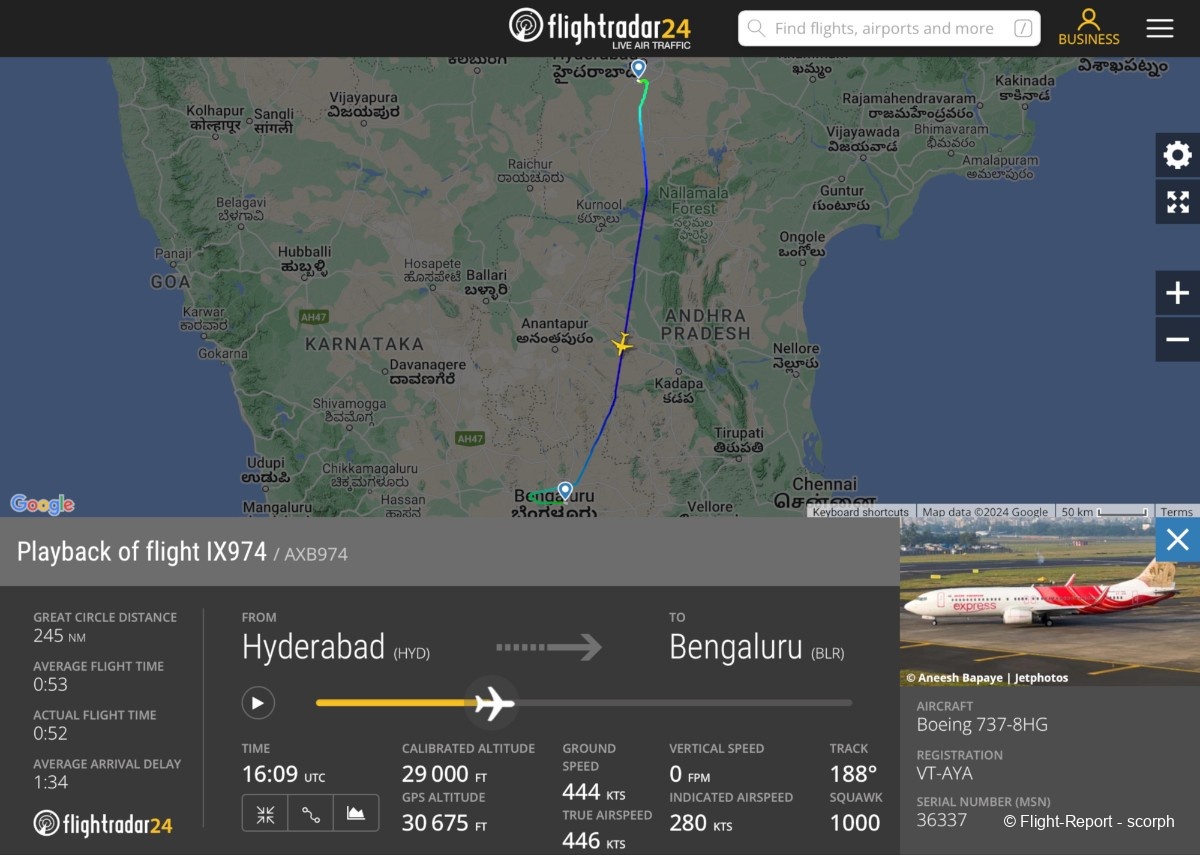
After finishing my meal, I made a quick trip to the restroom, which was clean. I took the opportunity to bring the remains of my snack to the galley trash, where I was thanked by the cabin crew. This led to an interesting conversation with the two flight attendants at the rear of the plane about aviation and how their schedules have been disrupted by the rapid rollout of these new domestic routes.
I was even invited to share some festive cashew-based sweets, typical for the Diwali season a really thoughtful gesture.
On the way back to my seat, I noticed a life jacket was missing two rows behind me, so I put it back in place, which brought back some memories of my very first job.
Soon after, the descent was announced, and we began approaching the lights and highways of southern India’s sprawling megacity. From the air, I could spot a few bursts of fireworks. Always fun to see during an approach. After all, Diwali means firecrackers and fireworks for many in India! Some of the explosions were quite spectacular but not always very well controlled, unfortunately, leading to a large number of injuries each year.
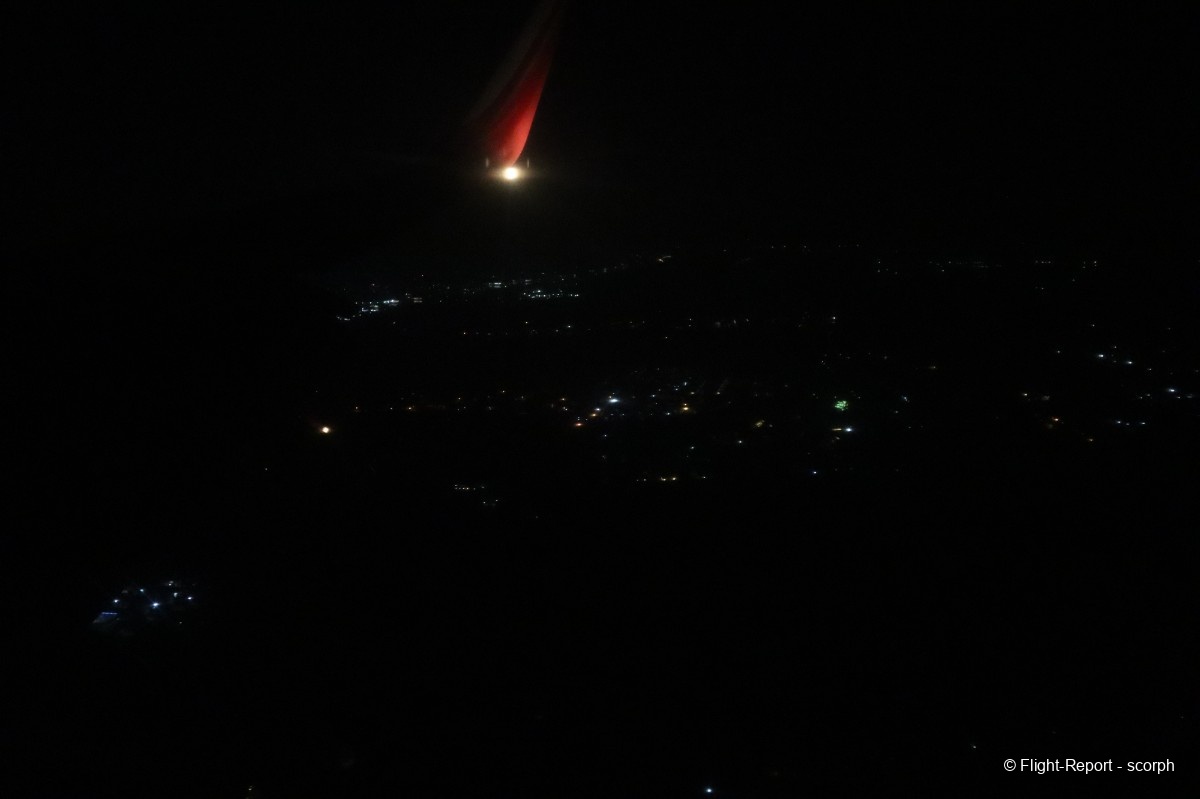
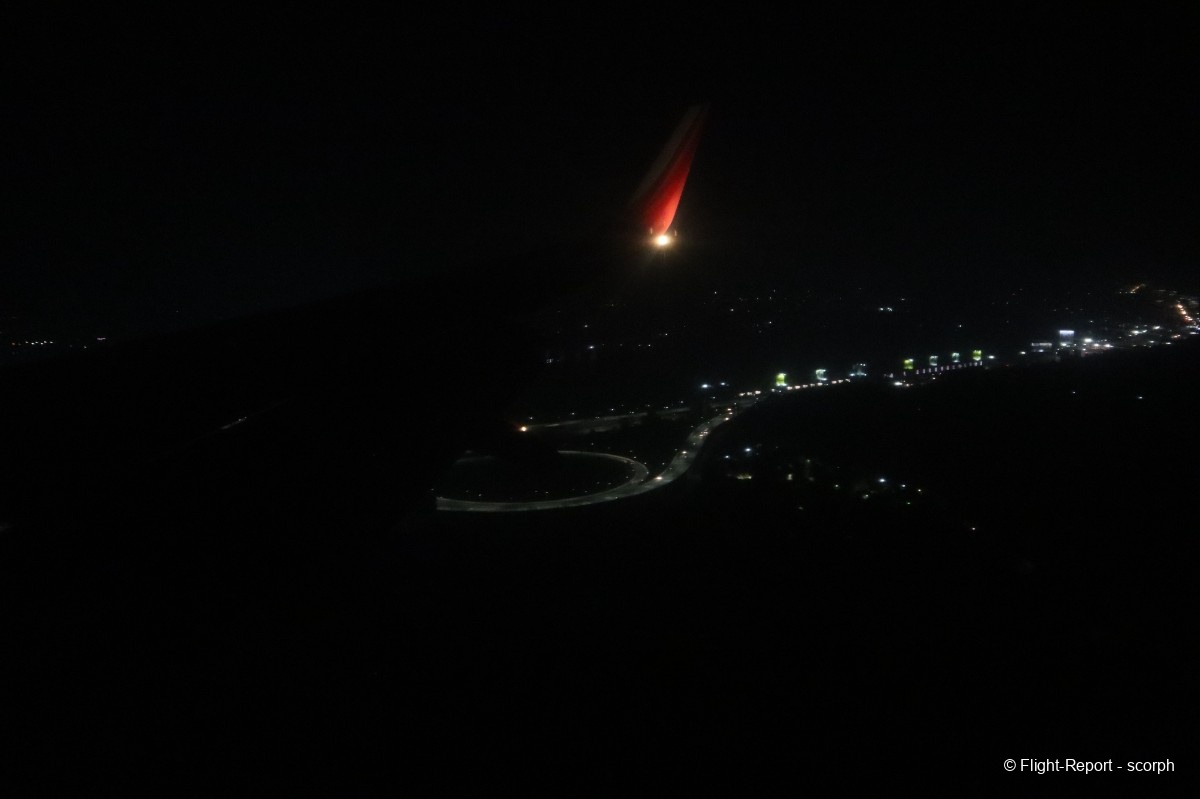
Landing in Bangaluru night
We touched down once again at night on runway 09L. The landing itself was a bit bumpy, but the braking was relatively smooth.
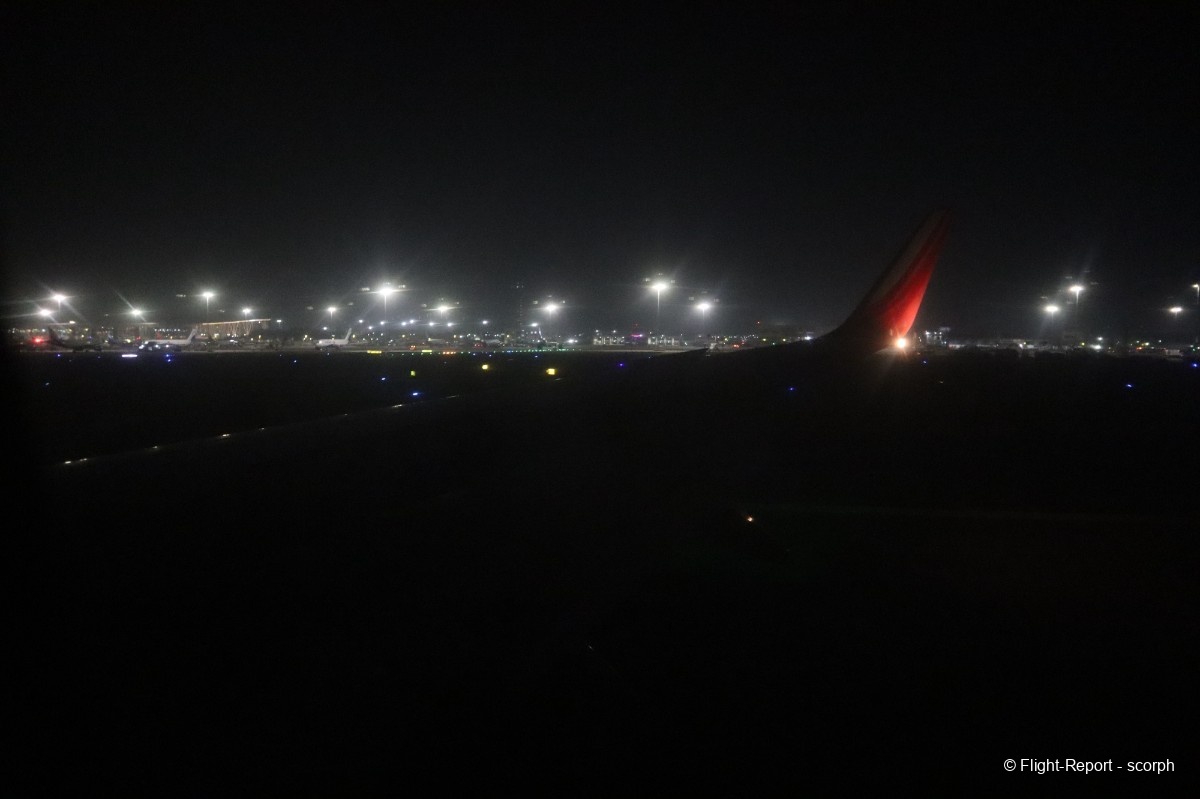
In the distance, you can see the aircraft stored away from Terminal 1.
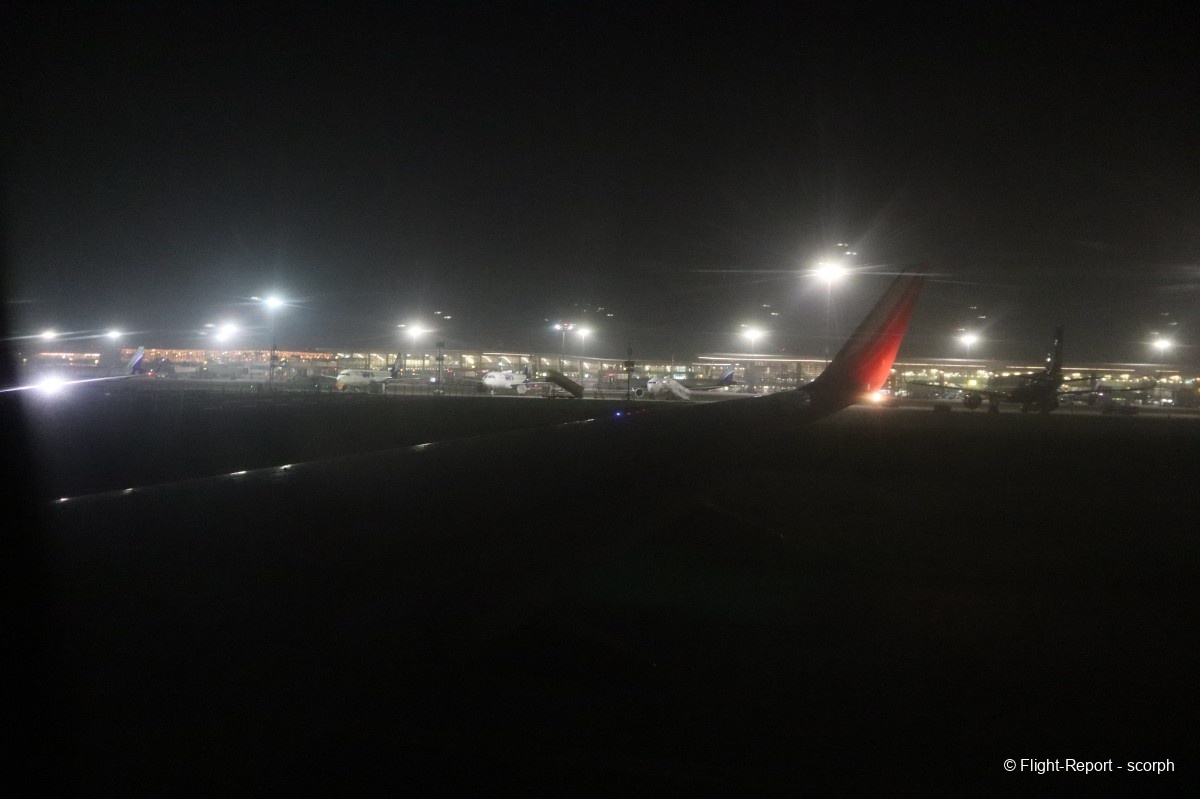
But for us, it’s off to Terminal 2, where both Air India and Air India Express operate all their flights. We spot a few international visitors (though it’s still a bit early for arrivals from Europe), including this Singapore Airlines Airbus A350.

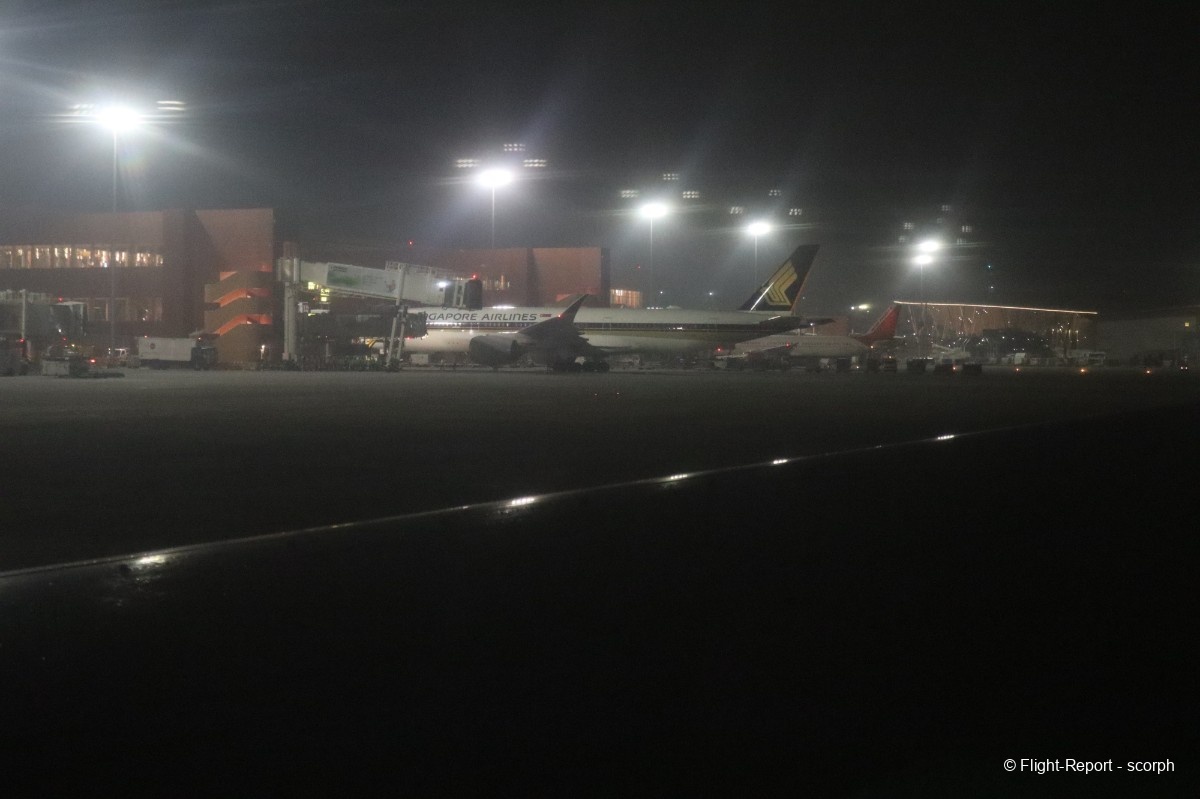
We make our way to our parking stand on the southern side of Terminal 2, which is reserved for domestic flights. Despite Air India Express positioning itself as a low-fare airline, we disembark via a jet bridge.
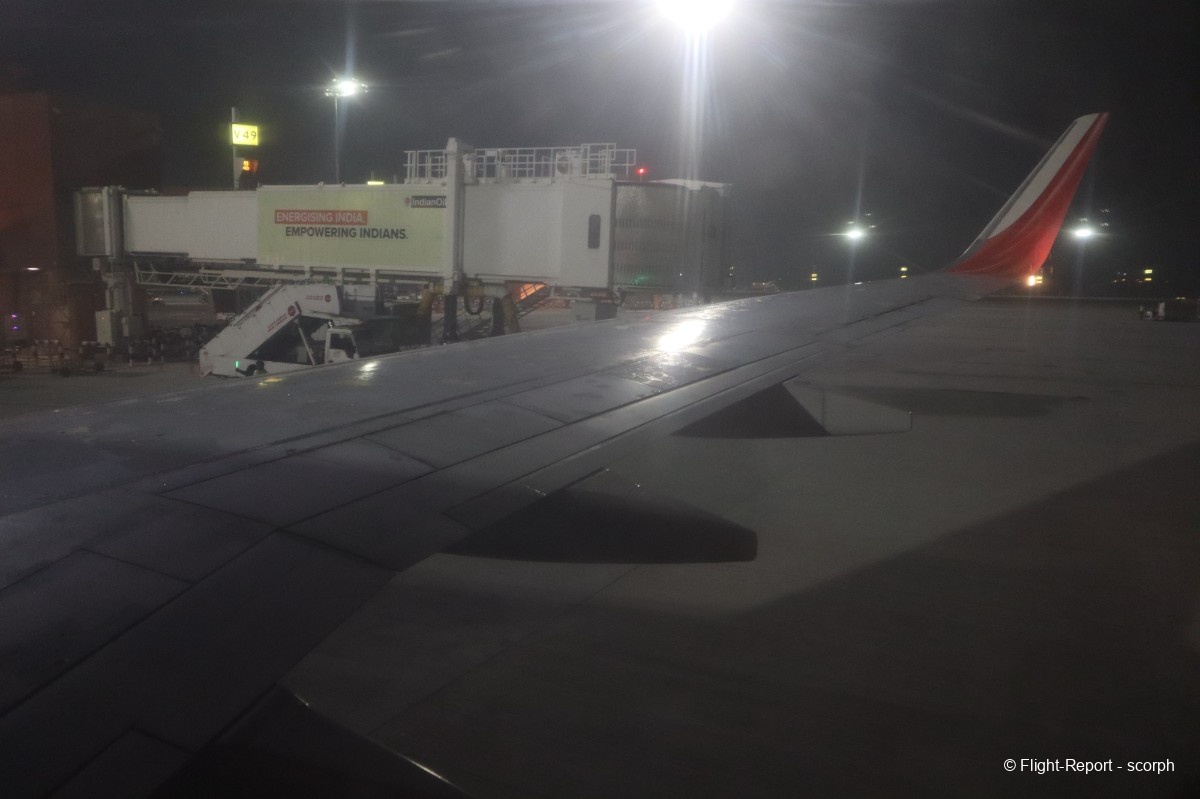
Disembarkation takes only a few minutes, thanks to the light load in the cabin. I take the opportunity to snap a few photos of the empty cabin.

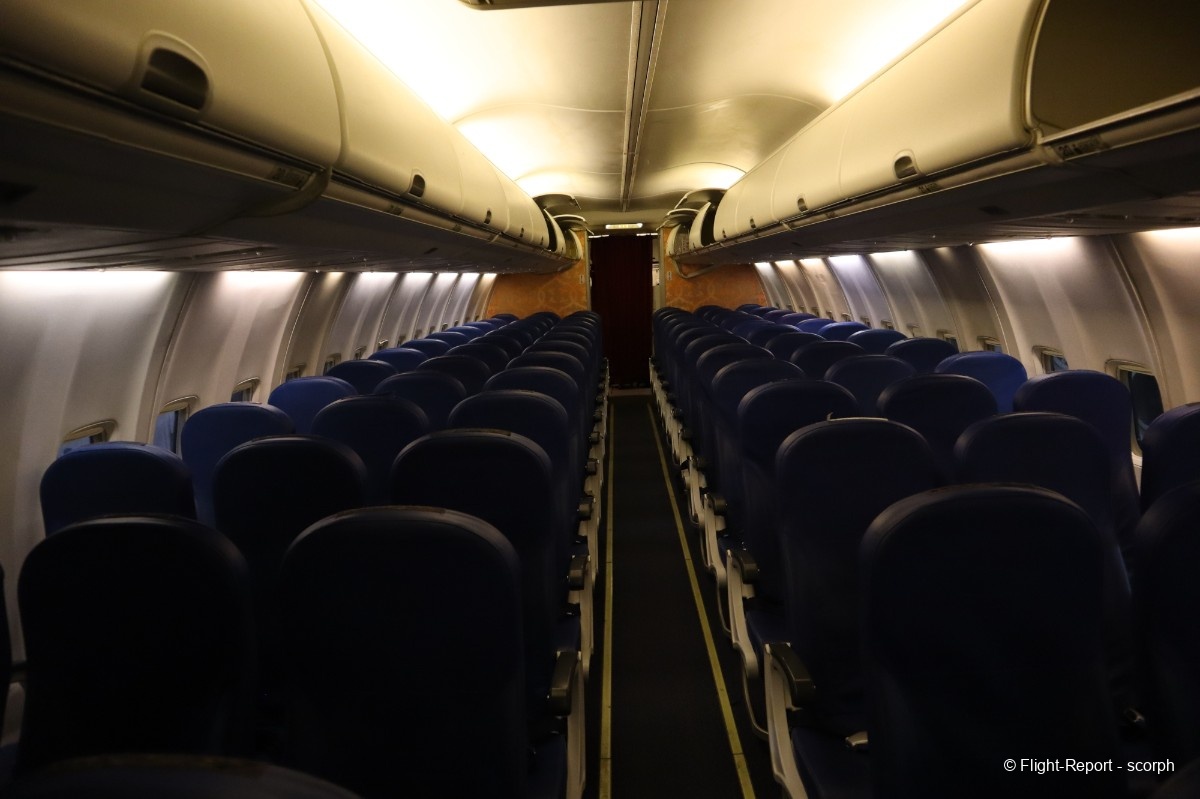
I leave the aircraft with a warm farewell from the leading cabin crew, walk through the jet bridge, and head toward the exit.
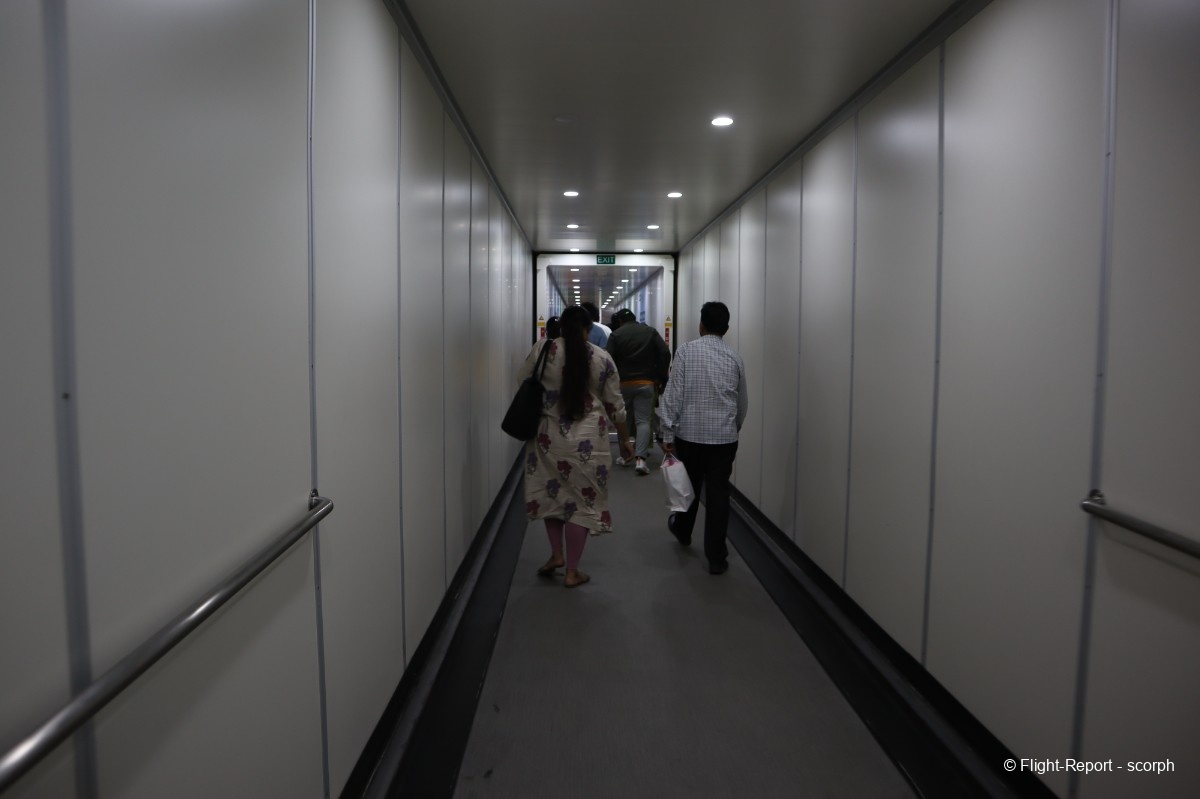
One last glimpse of the nose of our Boeing for the day from the jet bridge.
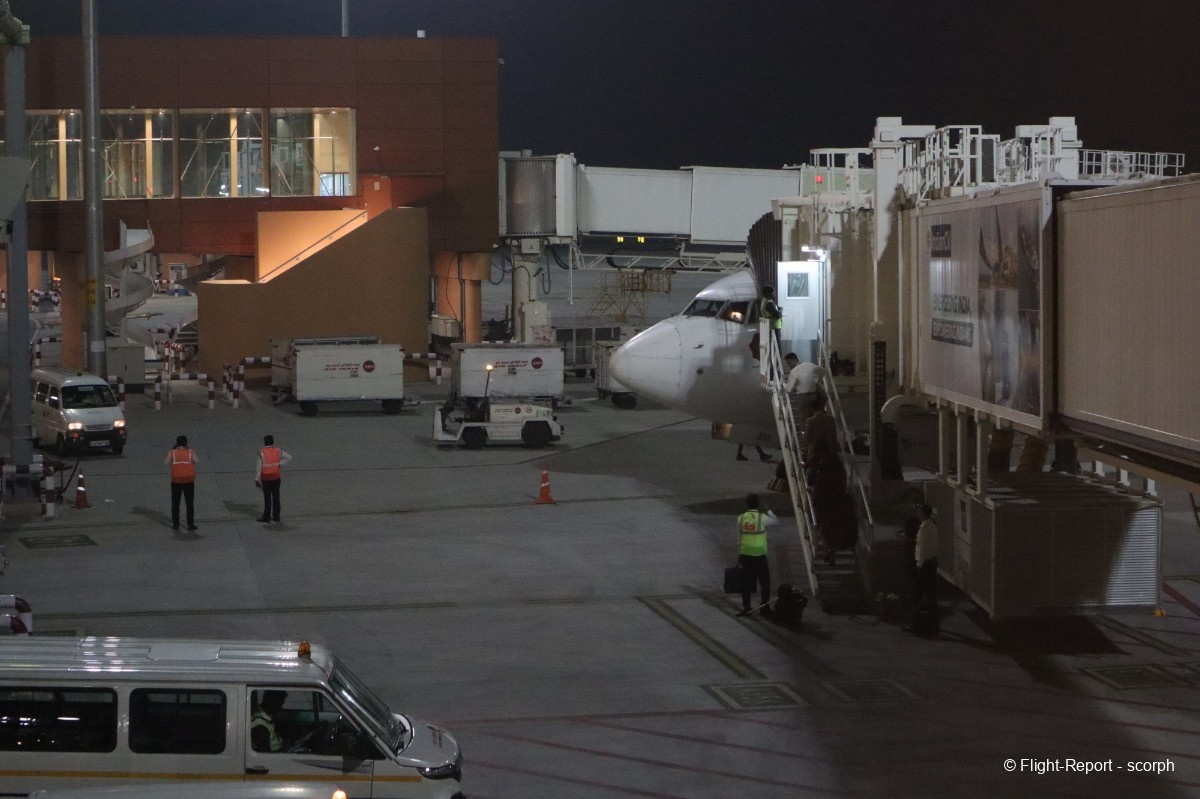
On the other side of the jet bridge, you can see other Air India Express aircraft parked at the gates as well.

The walkways to reach the exit can sometimes be a bit long depending on your location within the terminal, but there are usually travelators available, as well as a complimentary buggy service for elderly passengers.
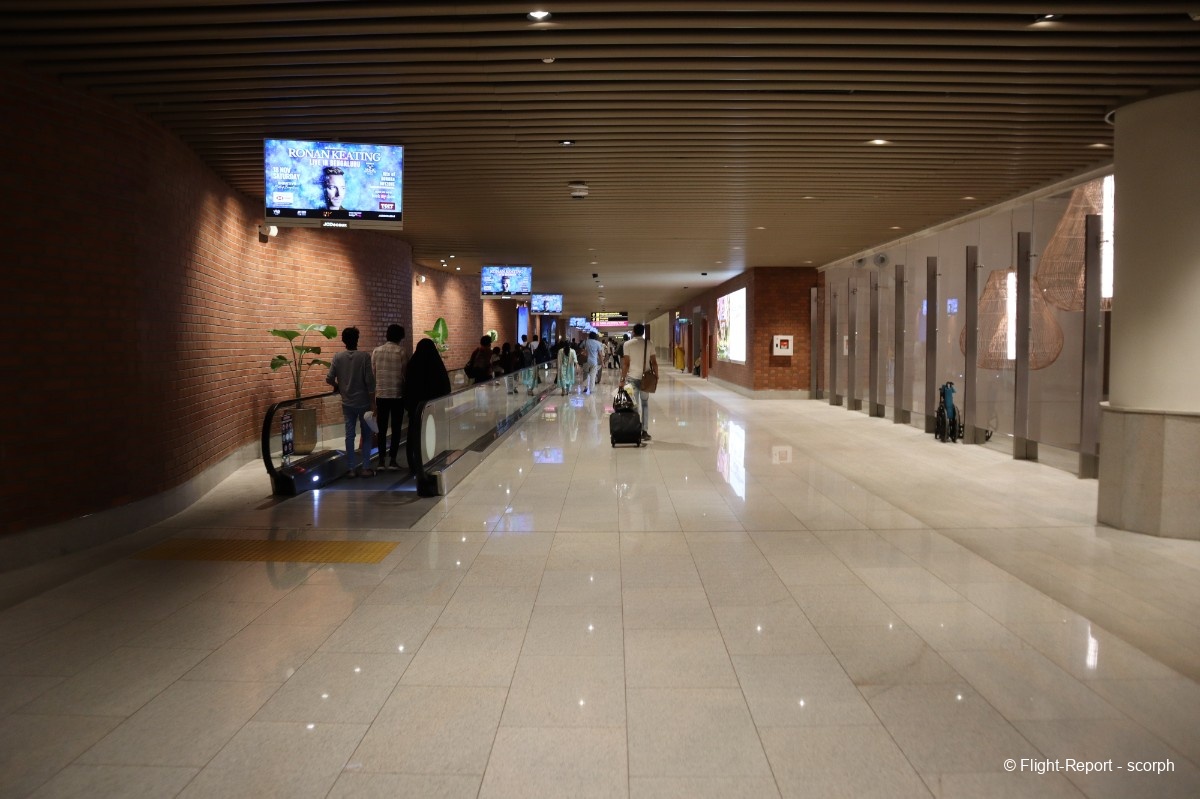
On the evening arrivals board, you can see that most long-haul flights arrive in the middle of the night.
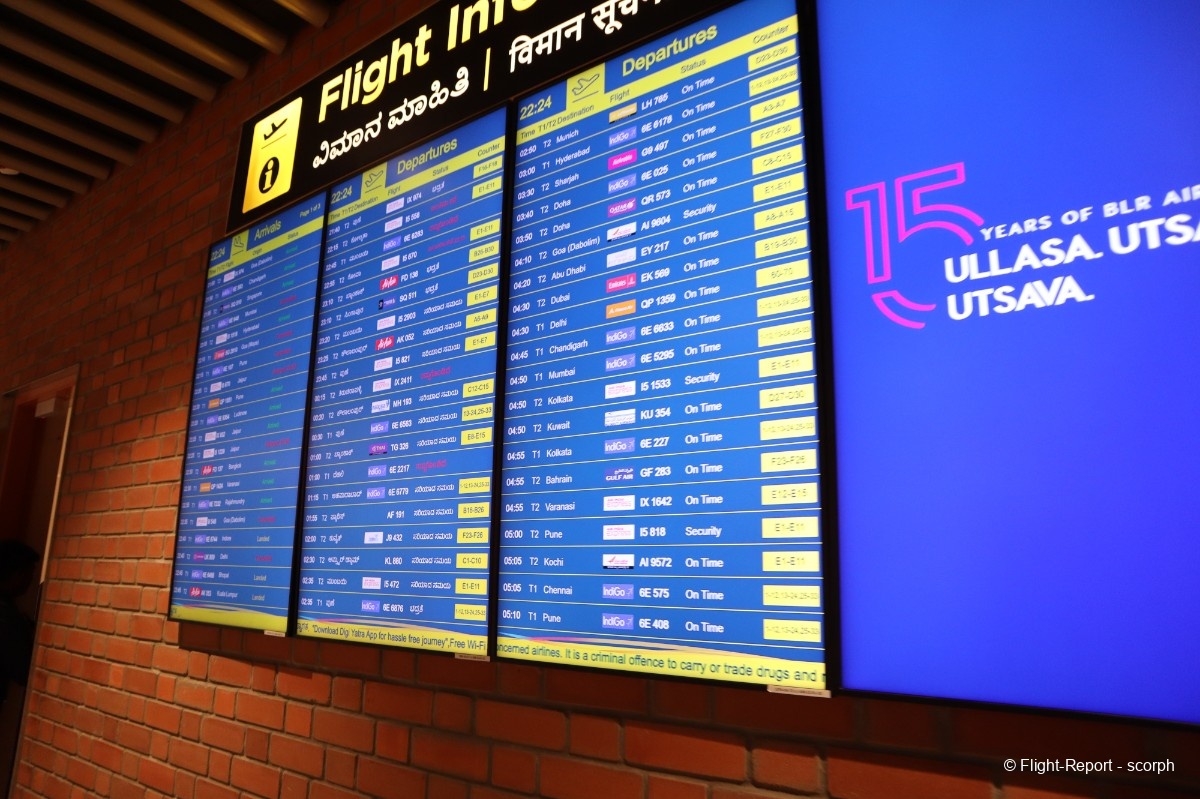
Along the way, we even get a view of the indoor gardens and waterfalls. This new Terminal 2 is truly a remarkable achievement.
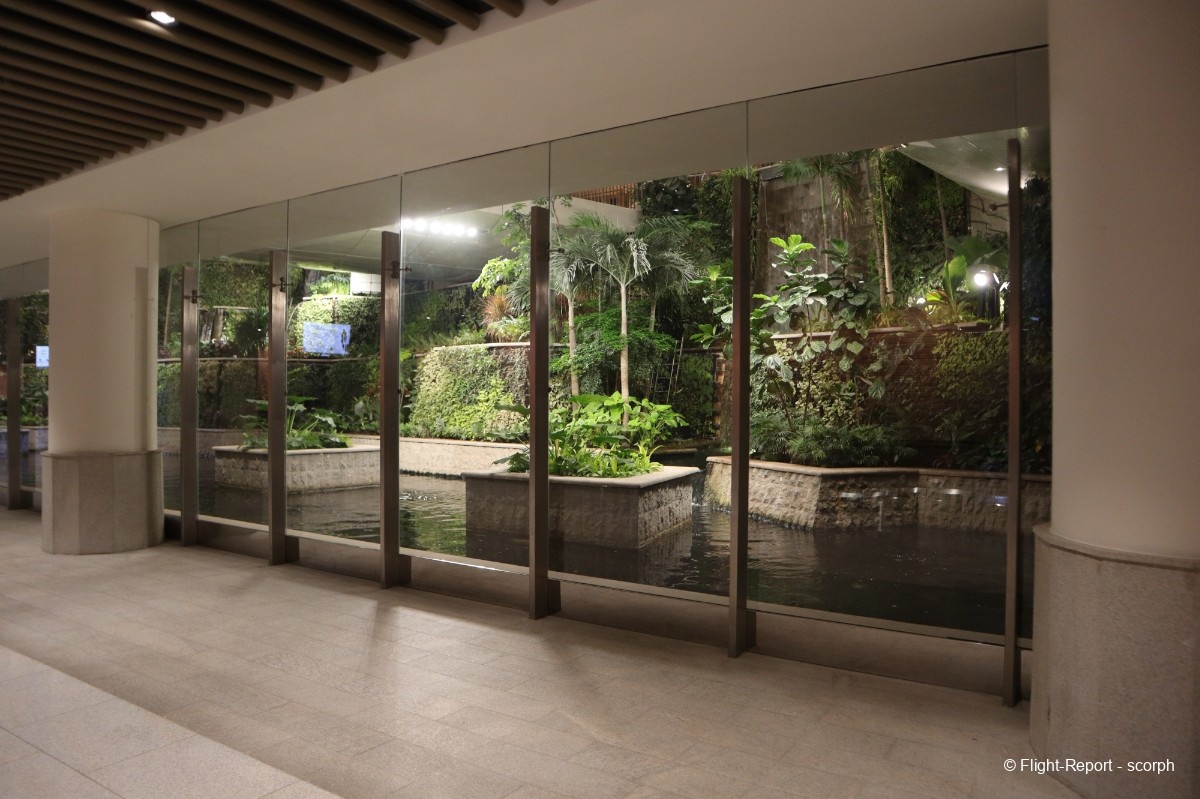
We then enter the huge baggage claim hall. Notably, carousel 9 has currently been replaced by planters and elephant statues. There’s plenty of space reserved to accommodate increased traffic if needed!
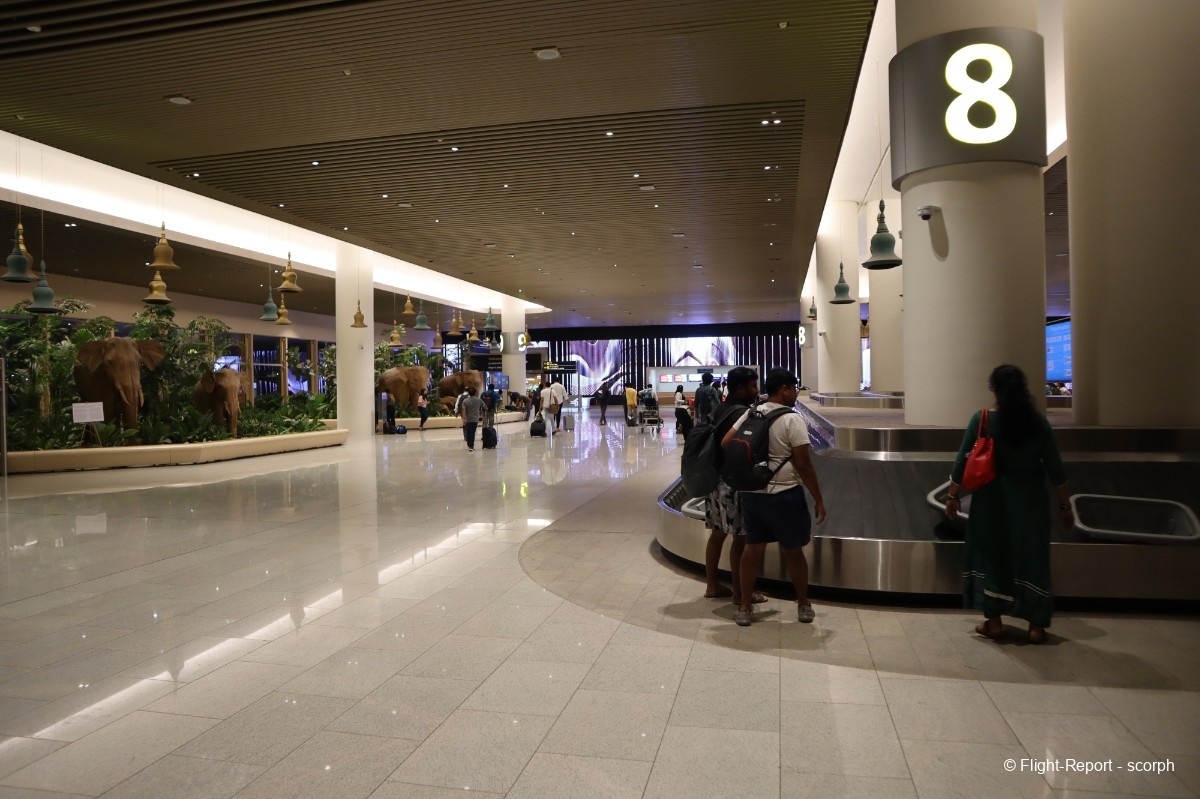
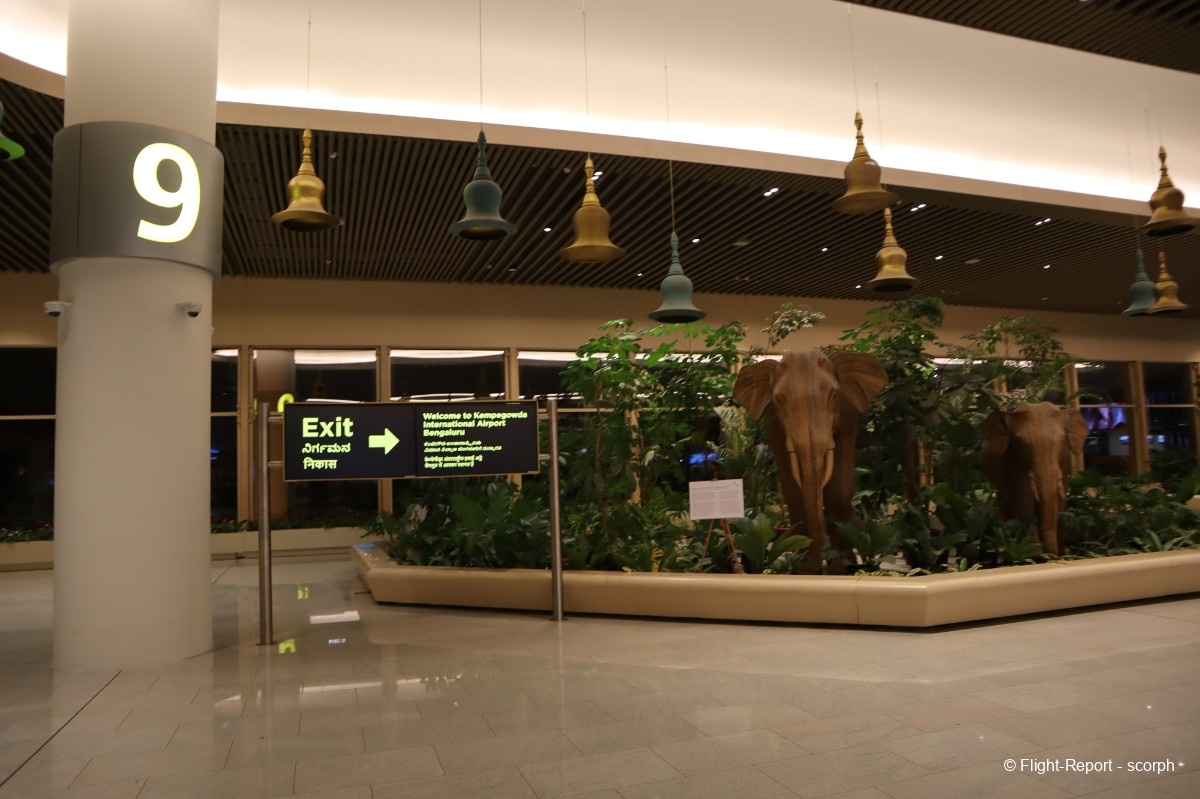
Very quickly, we emerge groundside beneath this huge open-air canopy, exposed to the elements yet still hosting plenty of services from currency exchange booths and prepaid taxi counters to kiosks from major chains offering food, even at this late hour.
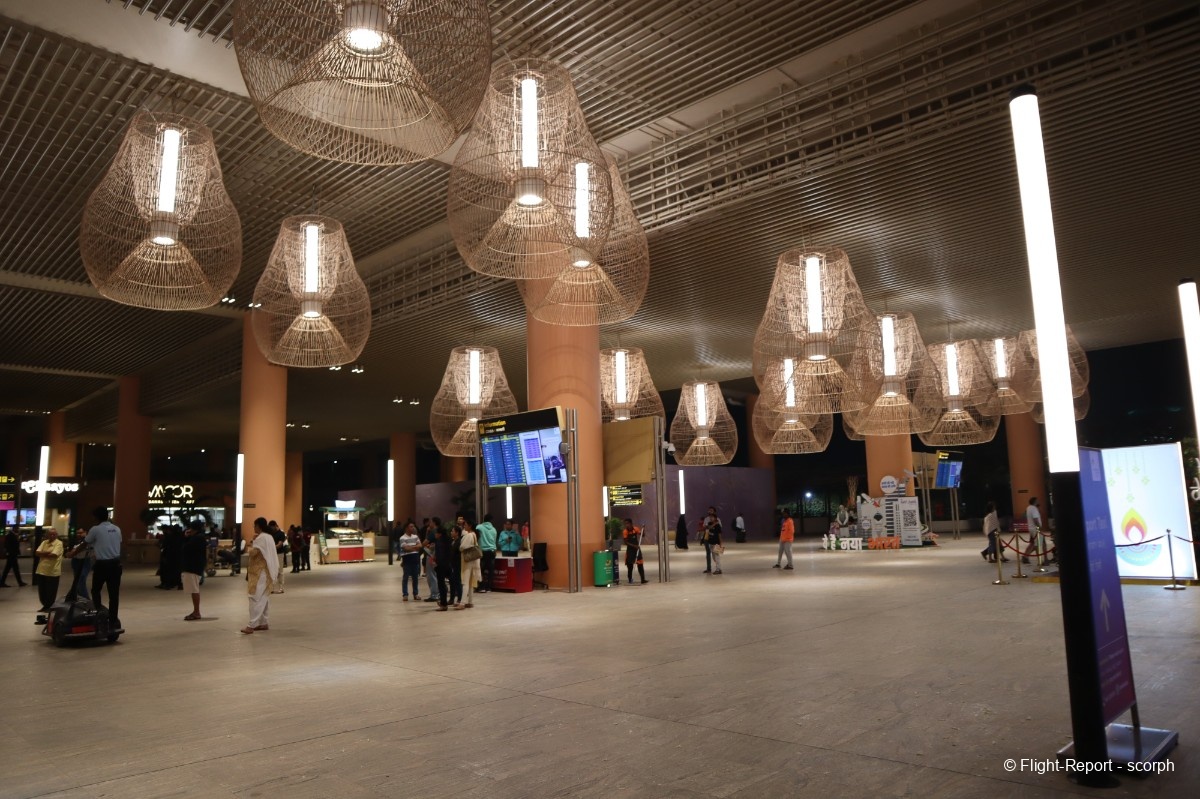
Being used to Terminal 1, I thought the only Uber drop-off zone was there… but I was wrong there’s one at Terminal 2 too (which I didn’t know at the time). Anyway, this gave me a chance to show you the shuttle bus that runs every 15 minutes between the two terminals at the airport.
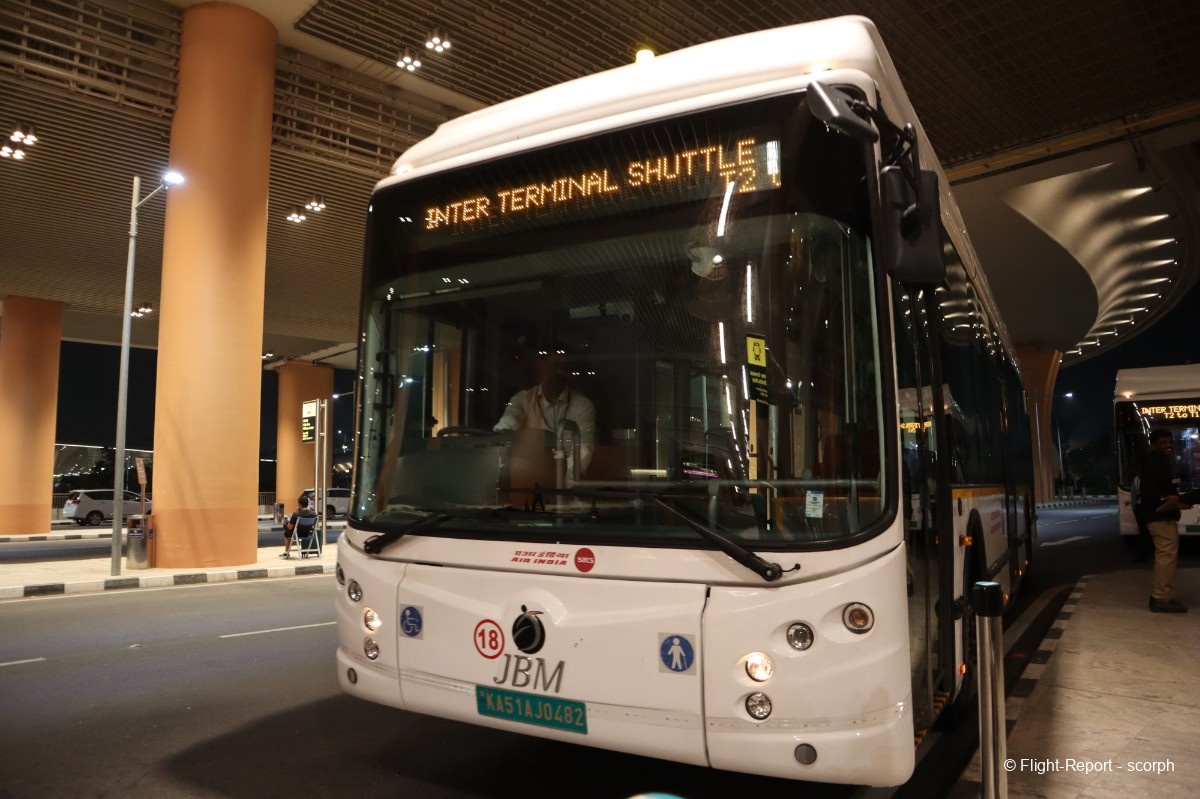
And that’s where this weekend getaway comes to an end… don’t worry, I still have some footage left from my other Indian flights! So we’ll catch up again very soon for the next part.

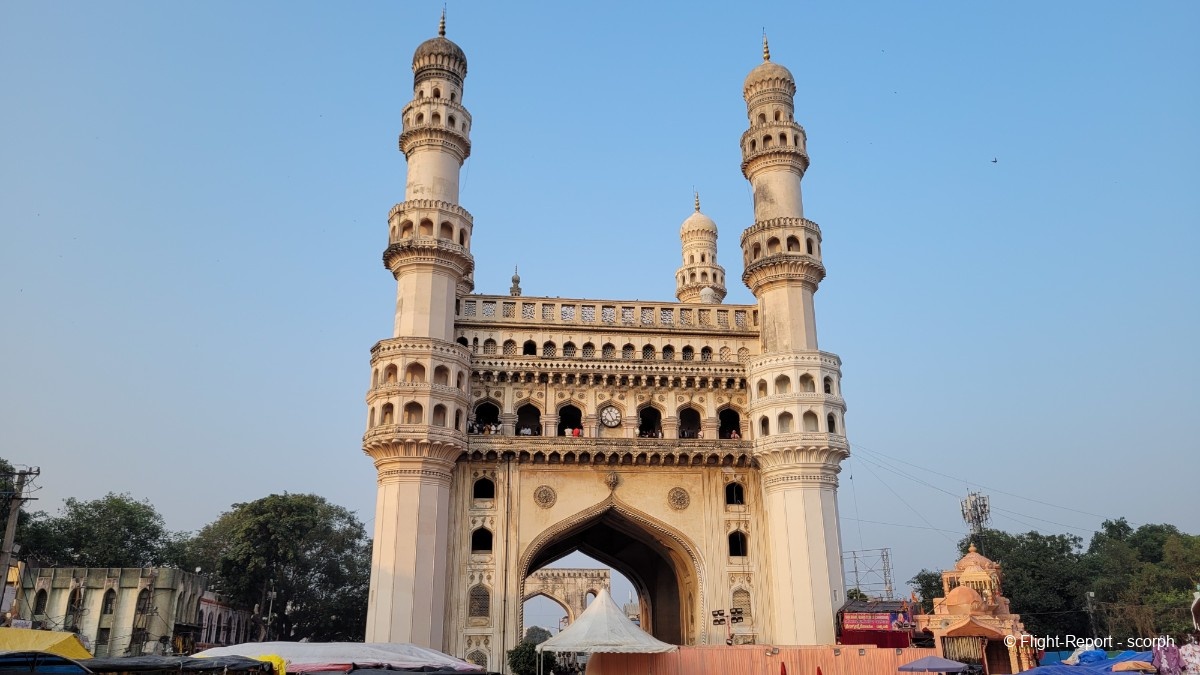
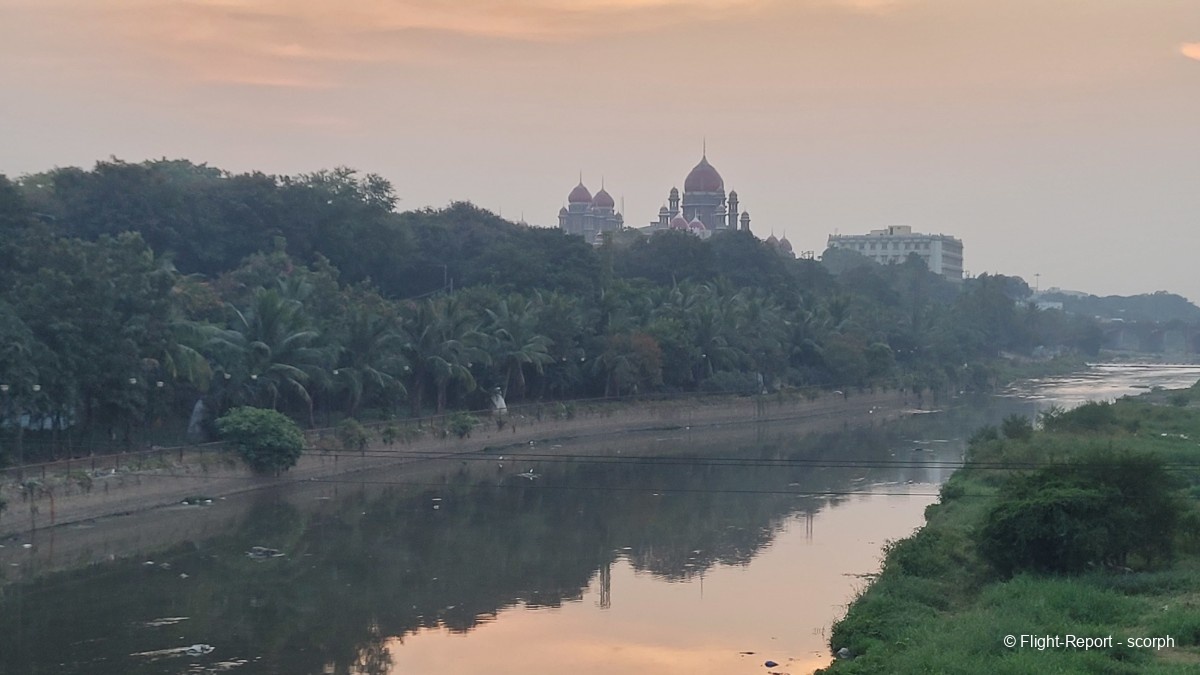
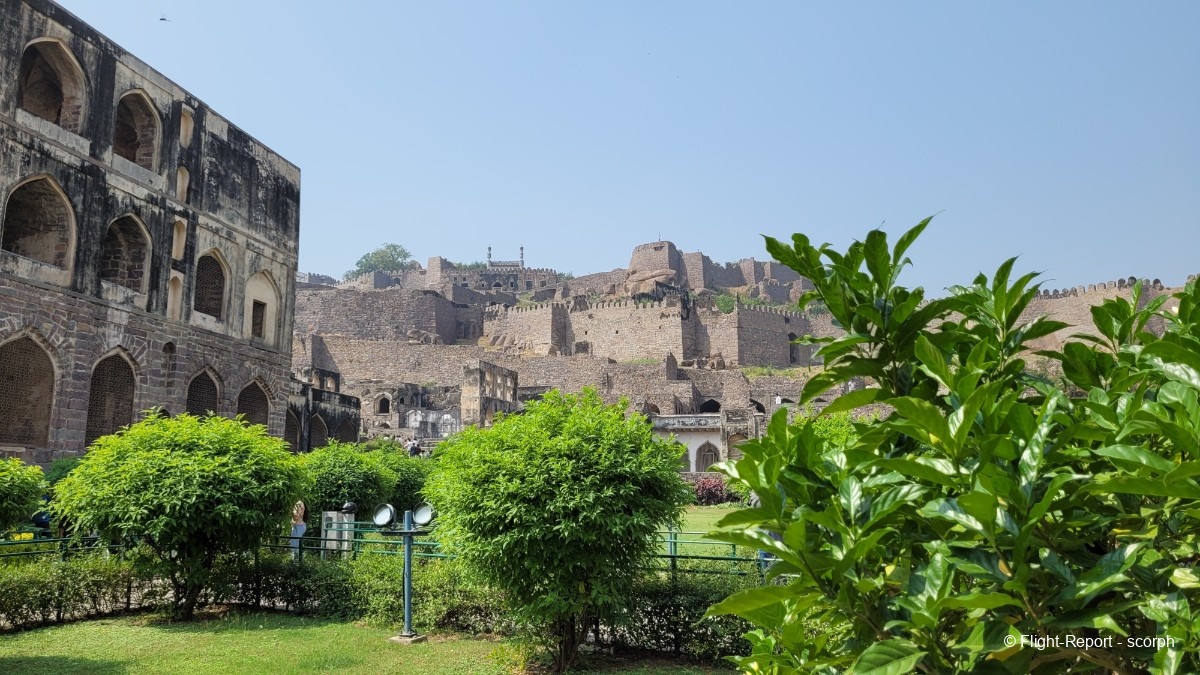
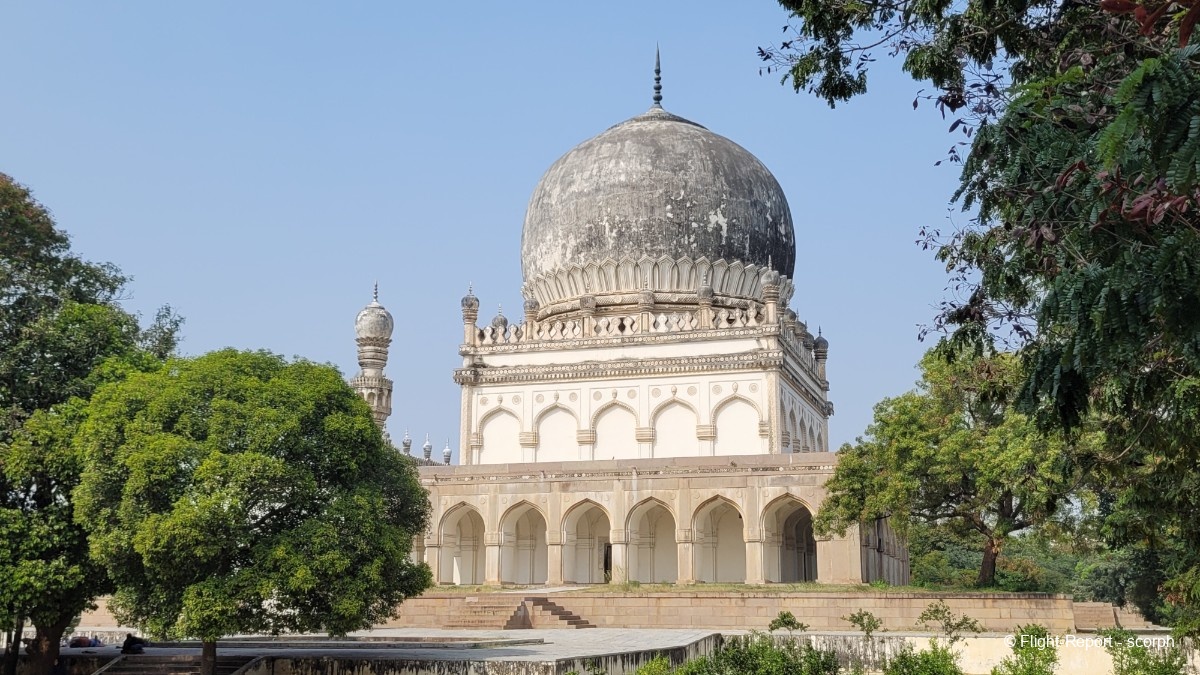

Nice to see a review on AIX as there aren't a ton out there. I guess as far as Indian LCCs go they're not the most basic and not the fanciest--safely playing the middle. One nice thing is the streaming IFE which is rare among LCCs. I know AirAsia India also introduced streaming IFE shortly before merging with Air India Express, so I'm not sure if that had anything to do with it, but it's nice to see. The cabins look like they're the same seats as IndiGo (though with different seat covers).
Beautiful tourism bonus pics! Thanks for sharing!
Hi Kevin and thanks for your comment. Indian commercial aviation as drastically changed within the last 2 years with major consolidation following Air India purchase by Tata group. Air India express has now totally changed is business model to compete with Indigo on the point to point domestic flight using a brand new fleet of B737max and believe me the cabin is far better on these new birds. Globally compared with LLC in Europe the service is clearly better
Cheers!